


A PARTNERSHIP BUILT ON INNOVATION AND TRUST
H.E. MRS. ANNE ELISABETH LUGON-MOULIN Swiss Ambassador to Serbia









A PARTNERSHIP BUILT ON INNOVATION AND TRUST
H.E. MRS. ANNE ELISABETH LUGON-MOULIN Swiss Ambassador to Serbia






Discover the all-new Volvo XC90, now available with a petrol engine or plug-in hybrid powertrain. Designed to impress with cutting-edge technology, 7-seat comfort, top-tier safety and unmatched refinement— Swedish luxury at its finest Drive away in the new, even better Volvo XC90 starting from 65.990 €
Check out our outstanding Volvo XC series models available from only 299 € per month* and stock vehicles, ready for immediate delivery.
Uncompromising quality. Irresistible offers. Don’t miss out—secure yours today!

Your flag flies in every town where someone smiles to see you,” sang the famous Đorđe Balašević, whose songs—especially “To Live Freely”—are once again beloved hits in Serbia. I found myself reflecting on his lyrics a few days ago while in Novi Pazar, attending an iftar dinner at the home of my friend Salahudin Fetić, director of the local Sandžak TV station. After dinner, we went for coffee with the Novi Pazar Mufti, Prof. Dr. Mevlud Dudić, whose interview will be featured in the next issue of this magazine.
Mufti Dudić, a distinguished intellectual and seasoned world traveller, shared with me his experiences in Libya during Muammar Gaddafi’s rule, his visits to the Bosniak diaspora in New York, and his insights into Serb–Bosniak relations in both Sandžak and Bosnia.
after the first article on the camps in Bački Jarak, Gakovo, Knićanin and other places, the topic remains largely unknown to the broader public.
As part of my series “Cycling through Vojvodina”, I visited many towns once inhabited by Germans— abandoned or half-collapsed churches and cemeteries overgrown with shrubs. In a few places, such as Bački Jarak, Gakovo, and Bački Gračac, there are more recent memorials that bear witness to what happened between 1945 and 1948.
Over lunch at Klub književnika last week, the new Israeli Ambassador to Serbia asked me where my deep affection for the Jewish people and their cultural heritage in Serbia comes from and whether I have Jewish roots. I told her I don’t—but that I am drawn to exploring the stories of communities that have suffered injustice or have nearly disappeared from this region, like the Jews, the Germans, or the White Russians.
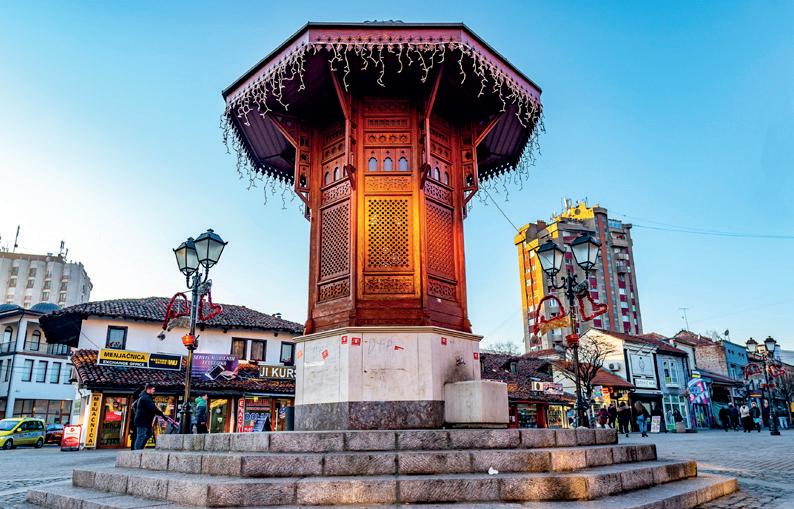
He mentioned that he had to cancel the traditional iftar dinner for ambassadors, as most of them had been instructed not to leave Belgrade due to the current situation in the country.
Two days later, I was in Sombor, where I gave a lecture at the Danube Swabian Museum on how the media has portrayed the fate of Vojvodina Germans in Serbian and Yugoslav press. The first texts on the fate of the Danube Swabians in the SFRY press were written by me in the student magazine Index and by Tomislav Marčinko in Nedjeljna Dalmacija in 1990. In the mid-1990s, Belgrade journalist and author Nenad Novak Stefanović also wrote about it. Today, 35 years
Next week, I’ll be attending the Montenegro Luxury Summit, followed by moderating the “Women’s Voice in Diplomacy” panel on April 3 at the Women’s CEO Summit. The next day, we’re taking ambassadors from Belgrade skiing at Kopaonik for the Diplomacy & Commerce Ski Weekend. Then it’s back to Montenegro in April for the ESG Adria Summit and later Rovinj for the Weekend Food Festival.
And in all those cities, my flag flies—because in each one, there is at least one person “who is glad to see me there.”
In the turbulent times we’ve been living through in Serbia over the past five months, it remains vital to keep the conversation going, to open up complex topics, to communicate, travel, and collaborate. We’re fortunate that in the region of the former Yugoslavia— our shared home—everything one could wish for lies within a 45-minute flight: sea and mountains, Baroque and the Orient, štrukle in the Esplanade and burek and ćevapi in Baščaršija; rivers and lakes, jungles and deserts, nature and cultural heritage.
I believe our mission is to help our foreign friends—those who live and work in Belgrade and other capitals where we publish Diplomacy & Commerce—become familiar with all of this as well.
Robert Čoban
March 2025
FOLLOW US TO STAY UPDATED
Director ROBERT ČOBAN robert.coban@color.rs
Editor in Chief
DRAGAN NIKOLIĆ dragan.nikolic@color.rs
Journalists MIJAT KONTIĆ ŽIKICA MILOŠEVIĆ
Advertising DRAGAN NIKOLIĆ dragan.nikolic@color.rs
DRAGAN VUČEVIĆ dragan.vucevic@color.rs
marketing@color.rs
Photos GORAN ZLATKOVIĆ NEBOJŠA BABIĆ MILOŠ NADAŽDIN
STEFAN ĐAKOVIĆ
KHARIM NSENGIYUMVA JAKOV SIMOVIĆ
SHUTTERSTOCK
Translation COLOR MEDIA EVENTS
Prepress VLADIMIR DUDAŠ C e n t r o b i r o
Contributors
ROBERT ČOBAN
LJILJANA VUJIĆ
JOSIP ASIK
JOVANKA VIŠEKRUNA JANKOVIĆ
Print COLOR PRINT Novi Sad
Distribution PRETPLATA D.O.O. office@pretplata.rs +381 11 314 99 21
COLOR MEDIA EVENTS
Published by: Color Media Events d.o.o. 21000 Novi Sad, Serbia Temerinska 102 VAT: 113769690 Reg. No: 21922978 Belgrade Office: Vlajkovićeva 6 11000 Belgrade, Serbia Phone: + 381 63 432 392
CIP – Katalogizacija u publikaciji Biblioteka Matice Srpske, Novi Sad 33 Diplomacy & Commerce / glavni i odgovorni urednik: Dragan Nikolić, 2016, (mart)-.Novi Sad: Color Media Events, 2016 - , -33cm Mesečno ISSN 2466-3808 = Diplomacy & Commerce COBISS.SR-ID 303269895
Copyright

6
POLITICAL INTERVIEW VOJVODINA’S TOURISM AND ECONOMY ON THE RISE NENAD IVANIŠEVIĆ
Provincial Secretariat for Economy and Tourism
10
DIPLOMACY SERBIAN REENGAGEMENT WITH PAKISTAN H.E. ALI HAIDER ALTAF Ambassador of Pakistan to Serbia
32
POLITICAL ANALYSIS IT HAS BECOME CLEARTHE REPUBLIC IS WORN OUT BY ŽIKICA MILOŠEVIĆ
34
FEATURED INTERVIEW BURN THE BLUEPRINT STUDENTS IN BLOCKADE by Dragan Nikolić
38 media INTERVIEW YOU DECIDE NOT TO SELL YOURSELF NEMANJA RUJEVIĆ Journalist
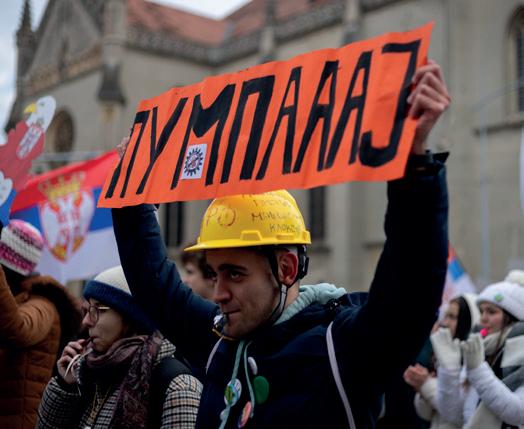
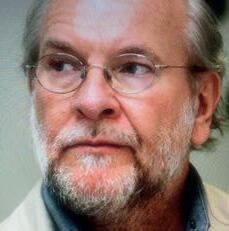
40 BUSINESS INTERVIEW HOW SERBIA IS LOSING GROUND
MIŠA BRKIĆ Economic Journalist

44 TRAVELOGUE WHISPERS OF THE SUDANESE DESERT BY VIKTOR LAZIĆ

48 CULTURAL INTERVIEW THE ARTIST’S STORY JOVANKA VIŠEKRUNA JANKOVIĆ



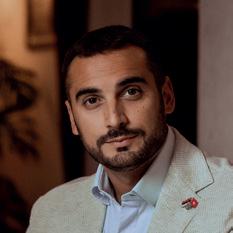

20
AMBASSADOR INTERVIEW A PARTNERSHIP BUILT ON INNOVATION AND TRUST H.E. MRS. ANNE ELISABETH LUGON-MOULIN
Swiss Ambassador to Serbia
23
CORPORATE INTERVIEW EMPOWERING SMALL BUSINESSES FOR BIG SUCCESS ALEKSANDAR GORAČINOV
Director of SME HUB
24
ECONOMICAL INTERVIEW FROM CHALLENGES TO GROWTH IN SWISS-SERBIAN TRADE DRAGICA TOMČIĆ
Economic Affairs Officer at the Swiss Embassy in Serbia
28
The Swiss-Serbian E2E Initiative SHAPING CAREERS WITH INNOVATION
COMING SOON...
We’re cooking up something special with our upcoming editions on Cyprus and Armenia. Curious? Get in touch and be part of it.
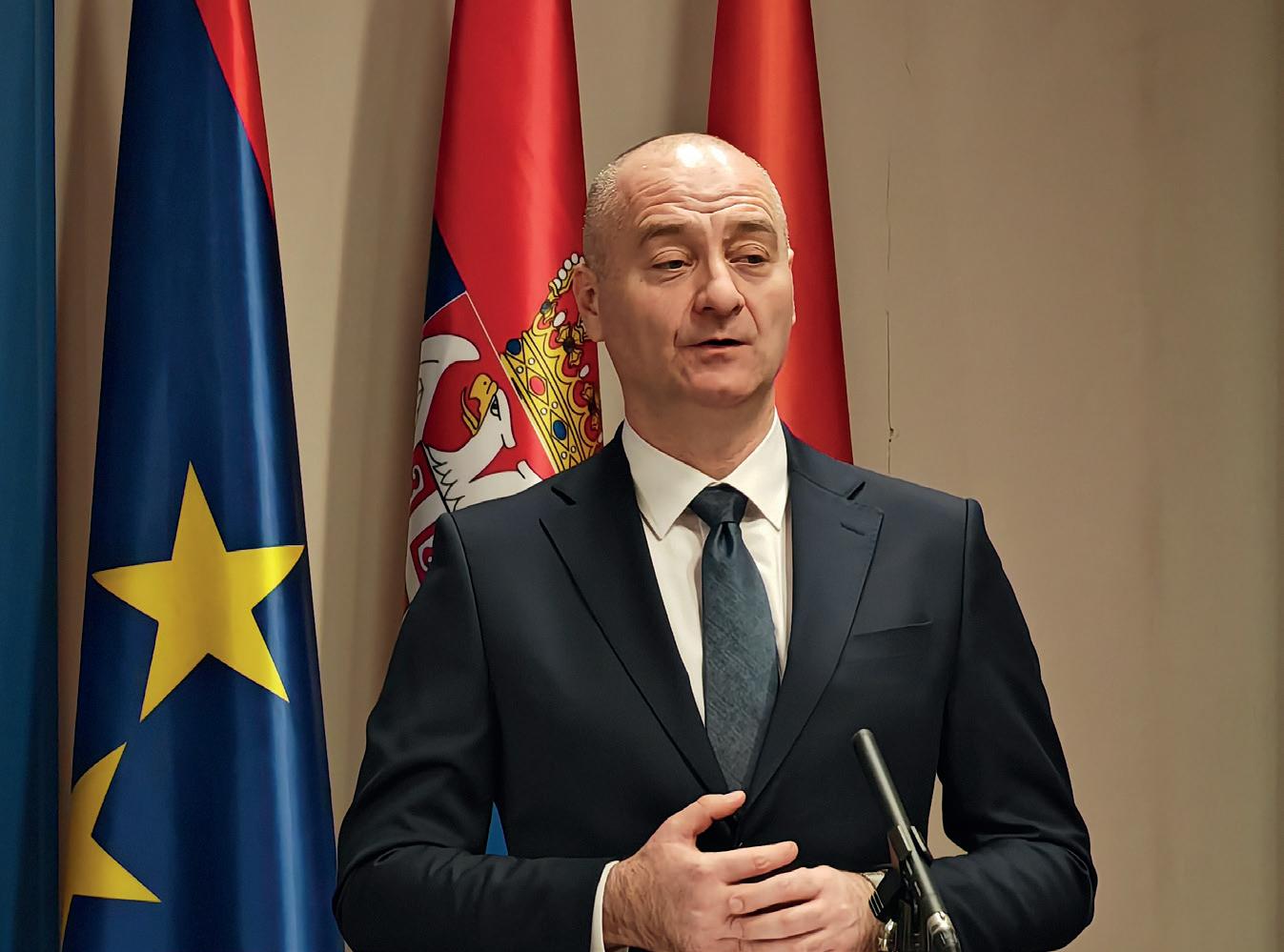
Investments have strengthened Vojvodina’s tourism capacity, attracting both domestic and foreign visitors
NENAD IVANIŠEVIĆ
Provincial Secretariat for Economy and Tourism
Nenad Ivanišević, Provincial Secretary for Economy and Tourism, discusses the dynamic growth of tourism in Vojvodina, the region’s increasing appeal to foreign visitors, and key investments in infrastructure and branding. He highlights the role of certification, event promotion, and strategic partnerships in shaping Vojvodina as a leading tourism destination.
What is the new budget for the current year 2025, which was adopted in December 2024? Has it been increased, and by how much?
cent, representing the largest budget increase for this body to date. The Provincial Secretariat for Economy and Tourism has seen a significant budget increase,
It is of exceptional importance that the budget for our Provincial Secretariat for Economy and Tourism for 2025 has been increased by an impressive 40 per
which is intended exclusively for end beneficiaries. In mid-January, we launched calls for support in the tourism industry, as well as for other sectors of the economy.
These include calls for the procurement of raw materials, machinery, and equipment, which is a programme we have reinstated. We have also announced a call for support for events, as well as for the congress industry in the territory of AP Vojvodina, to cover as many beneficiaries as possible through the Secretariat’s funding schemes.
A total of 500 million dinars has been allocated for tourism, 230 million dinars for the economy, 50 million dinars for events, and 10 million dinars for congresses. It is essential for us that
the Provincial Government has adopted the budget proposal for the upcoming year, which anticipates an increase of more than 20 per cent in allocations for tourism. The priority is to develop accommodation capacities, as there are currently not enough, particularly in smaller towns.
It is a fact that there are never enough funds to achieve everything one aims for while ensuring a positive outcome for all. However, knowing that the process has genuinely improved the quality of life for citizens to a higher level—which is the ultimate goal—remains the most important.
Can you explain how the incentive measures for improving tourism and the economy work?
It was essential to establish and strengthen a network of partners, as they play a crucial role in creating incentive measures for the economy, tourism, and employment. There is a connection between our programme structures and those of our strategic partners, which has been further developed, making it more visible, transparent, and, above all, more accessible to the broader public and interested applicants in our funding calls. We have also managed to engage more actively with the trends of digital technology use—commonly referred to as “digitalisation”—ensuring better two-way communication
with both businesses and citizens. The Secretariat has achieved this goal and has become a model of good practice for organisations on how to utilise modern technology and explore its broader application, particularly in tourism, hospitality, and services.
Through our measures and investments in machinery and equipment procurement, as well as initiatives in women’s entrepreneurship, crafts, telecommunications, and major tourism projects, we have pushed boundaries to support the sustainability of this vital sector and its professionals. The feedback we receive and the situation on the ground in Vojvodina confirm that the results are visible. We take pride in our past achievements as well as in the work ahead.
be reconstructed at these two locations?
The basis for drafting the project-technical documentation is the Spatial Plan for the Special-Purpose Area “Fruška Gora” (“Official Gazette of APV” No. 8/19) and the conceptual design created in 2018, funded by the Ministry of Construction, Transport, and Infrastructure. Under the agreement between the Ministry of Construction, Transport, and Infrastructure and the Provincial Secretariat for Economy and Tourism, signed in 2021, the contract covers the transfer of funds required for the preparation of an urban development project, modifications to the existing conceptual design, and the development of a preliminary project with a feasibility study
We have learned that projects are planned for the restoration and reconstruction of the tourist facility at the National Park Fruška Gora Info Centre, located at Iriški Venac, as well as certain sections of the “Green Trail” – a pedestrian and cycling path on the Petrovaradin–Beočin route. What exactly will
as part of the “Transformation of the Petrovaradin–Beočin Railway Line into a Green Trail” project.
Following the public procurement procedure by the Law on Public Procurement, on 10 February 2022, the Provincial Secretariat for Economy and Tourism signed a contract with AG INSTITUT d.o.o. from Novi Sad.
The contract is valued at 21,596,400 dinars, including VAT. The Spatial Plan envisages the reconstruction of the railway area along the local Petrovaradin–Beočin line and its transformation into a tourist route, the “Green Trail,” designed exclusively for non-motorised movement. This 18-kilometre-long route will enable environmentally friendly connectivity between settlements on the right bank of the Danube, promoting non-motorised transport along primary and secondary roads and linking to the “Fruška Gora Corridor.”
Additionally, the renovation, reconstruction, and equipping of the Information Centre of the Public Enterprise National Park “Fruška Gora” is planned as a joint project of the Government of the Republic of Serbia and the Provincial Government. The aim is to improve the tourism infrastructure and offer of Fruška Gora. The Info Centre will serve as a central hub with various facilities, providing tourists with information and guidance on their activities within the park. Fruška Gora is rapidly developing as a tourist destination and is already among the top ten destinations in Serbia. Therefore, the Info Centre is expected to become the focal point for tourism development in Fruška Gora, supporting spa, religious, wine, gastronomy, and cycling tourism—everything this mountain has to offer.
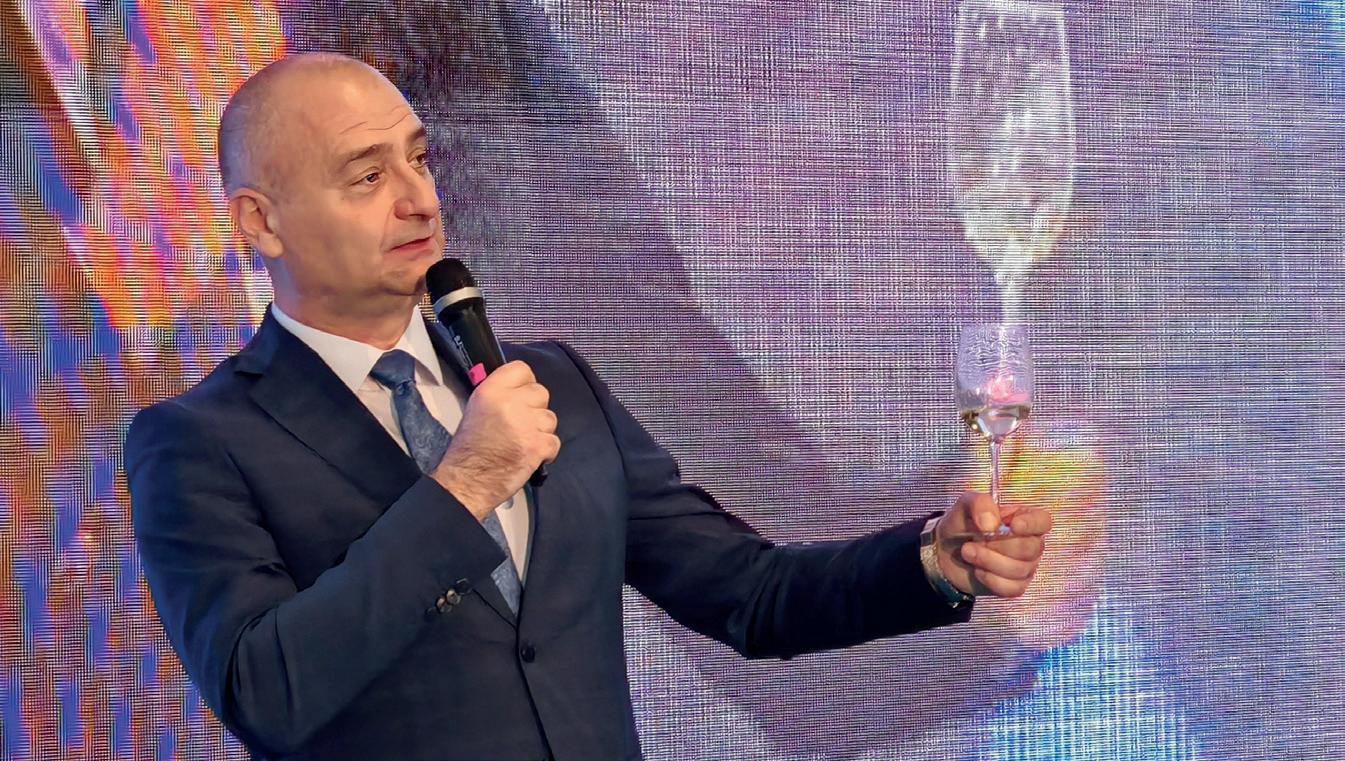

We have heard that the Provincial Secretariat, with the support of the Provincial Government, is helping winemakers and producers of other traditional alcoholic beverages from Vojvodina to place their products on tourism markets, as well as at regional business and tourism events and fairs across Europe and the world. To what extent do winemakers appreciate this support, and how valuable is it for their further market expansion both domestically and internationally?
We have successfully implemented a project for the certification and standardisation of strong alcoholic beverage producers. Alongside promoting premium wines from Vojvodina, we have also highlighted the region’s fruit brandies, given the presence of several high-quality distilleries in the province. The goal is to help them obtain these standards, enabling them to compete fairly in the market while also protecting consumers from misuse. Those who obtain certification gain full eligibility to participate in all winemaker promotions and events organised by the Provincial Secretariat.
Brandy is a recognised local brand in Serbia, and we aim to position it as an essential part of the local gastronomic offer. By integrating brandy into our
promotional efforts, we highlight the region’s unique characteristics. The certification period for this year’s beneficiaries, primarily fruit brandy producers, is three years, with annual supervisory audits. The Provincial Secretariat for Economy and Tourism covered the certification costs, making
the process entirely free for participants.
There is increasing support for religious tourism, particularly in connecting religious sites on Fruška Gora, which is rich in monasteries and other places of worship. How is this support
being implemented in practice? Additionally, festivals and events are a key part of every local tourism offer. How do you support them?
We have significantly advanced the development of various types of tourism, with a particular focus on religious tourism, as this is an area in which Vojvodina can offer a unique advantage. From the monasteries of Fruška Gora to Sremski Karlovci, which has the potential to become a key tourism hub in Vojvodina, we are working to enhance this sector while also recognising the
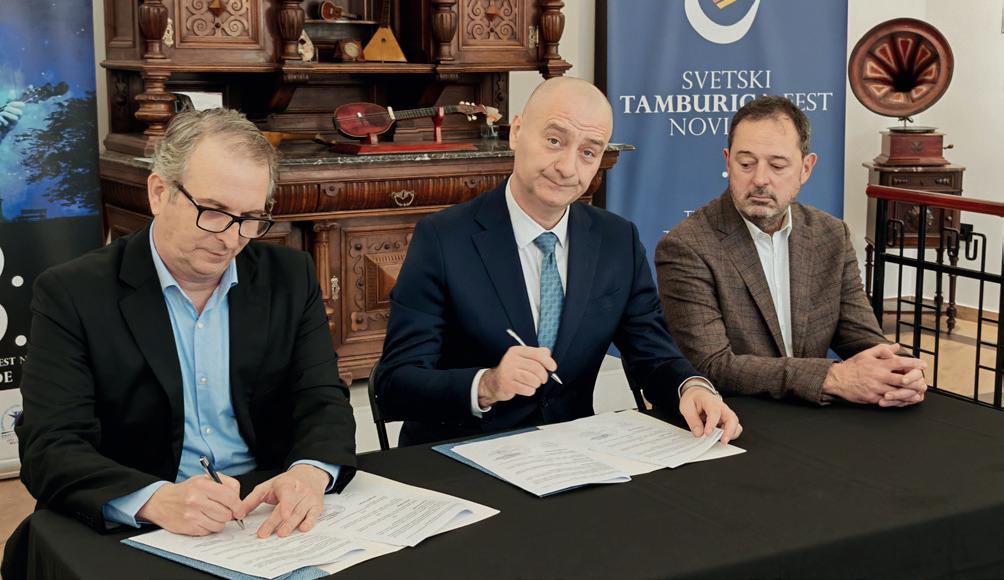
religious diversity present in the region. Event tourism, along with fair-based tourism, has fully recovered following the pandemic, which had a significant impact on this sector.
Vojvodina hosts around a thousand registered events annually, attracting over 500,000 visitors each year. This alone is a significant reason for us to provide support. Another key factor is the strong participation of women in these events—we consistently strive to ensure that more than 50% of participants are women. Additionally, most stalls at these festivals and fairs showcase local products, reflecting the creativity and dedication of the people who invest their time and skills. Through this, we directly encourage female entrepreneurship and traditional crafts, which are always present at such gatherings and inherently connected.
The Secretariat showcased a great deal at the International Tourism Fair in Belgrade, and preparations are underway for participation in the Agricultural Fair in Novi Sad, as well as for presenting the tourism sector at the International Tourism Fair at the Novi Sad Fair. This year, the Provincial Secretariat for Economy and Tourism participated in the 46th International Tourism Fair, held at the Belgrade Fair from February 20 to 23. Our presence was notable, with a diverse and engaging concept showcasing the tourism potential of AP Vojvodina through the participation of our co-exhibitors. Under the dome of the Belgrade Fair, with the slogan “One Ticket, Countless Worlds,” more than 400 exhibitors from Serbia and around the world gathered, making this the largest fair of its kind in the region.
Our slogan, “Come and See,” is an open invitation to experience Vojvodina as it truly is—a vibrant, diverse, intelligent, and delicious part of Serbia that is universally appealing. We aimed to present it in its entirety, bringing together associations, holders of the “Best of Vojvodina” label, traditional crafts, and all other elements that reflect the work of the Secretariat and the Provincial Government.
A special highlight was “Wine Street,” where top-quality wines were showcased alongside other products from AP Vojvodina, including food products and various alcoholic beverages. The wines predominantly came from the

A STRUCTURED APPROACH TO BRANDING AND CERTIFICATION WILL FURTHER ELEVATE VOJVODINA’S IMAGE
Fruška Gora wine region, which is gaining recognition on the global wine tourism map.
All co-exhibitors and other participants at the Secretariat’s exhibition stands were allowed to present themselves free of charge, based on an agreement signed between the Provincial Secretariat for Economy and Tourism and the Belgrade Fair.
Last year, you awarded the “Best of Vojvodina” certification to 28 new recipients as a mark of quality in the categories of products, services, programmes, events, and traditional crafts. Does this initiative continue to promote the products and services that best represent the region’s richness and diversity?
Over the past four years, 70 different products, services, events, and traditional crafts have received the “Best of Vojvodina” label. In addition to the 28 new recipients in 2024, another 12 have had their right to use the label extended for an additional three years.
The certification was initially established in 2004 but was last awarded in 2016 before being reinstated in 2021. This project identifies and rewards the best products, services, and businesses, ensuring that all awarded products meet European quality standards, including HACCP certification and ISO standards. By granting this label, the focus is
placed on domestic industry, production, and the service sector of Vojvodina’s businesses. This recognition symbolises quality, with the overarching goal of fostering economic patriotism.
A key feature of the “Best of Vojvodina” label is that certified bodies independently evaluate applications, and an annual review ensures that recipients continue to meet the required standards. Additionally, all certified products must be produced within the province, clearly highlighting their regional origin and the distinct quality of this area.
In the field of tourism, the competition spans gastronomic and wine offerings, organic production, accommodation capacities— including hotels, rural lodgings, and categorised units on agricultural estates offering tourism services—religious, hunting, fishing, nautical, and cycling tourism, as well as tourism events, destinations, and everything that reflects the unique offer of AP Vojvodina.
Statistics confirm that tourism in AP Vojvodina is developing and advancing at a rapid pace.
Tourist traffic in AP Vojvodina increased in 2024 compared to 2023, with arrivals up 2.7% and overnight stays rising 2.5%. Foreign tourists comprised the majority of visitors, accounting for 51 per cent of total arrivals and 52 per cent of registered overnight stays. The number
of domestic tourist arrivals in Vojvodina increased by 3.3% yearover-year, while foreign arrivals grew by 2.1%.
Between January and November 2024, Novi Sad was the most visited city in Vojvodina, accounting for one-third of all tourist arrivals in the province, with foreign visitors comprising the majority. The highest annual growth in both arrivals and overnight stays was recorded at Vojvodina’s tourism gem—Fruška Gora. Tourist arrivals increased by 19 per cent, while overnight stays rose by 7.3 per cent.
These figures reflect the stability, activity, and innovation of the Secretariat’s policies, which, in collaboration with the Provincial and National Governments, the responsible Ministry, and various tourism organisations at the national, provincial, and local levels, is actively working to enhance tourism infrastructure and the overall tourism environment in Vojvodina. As a result, tourism remains a vital economic sector in the province.
Investments by the Provincial Secretariat for Economy and Tourism in strengthening Vojvodina’s tourism capacity have not only attracted domestic tourists but have also encouraged them to return—just as foreign tourists do. The increase in visitor numbers compared to the previous year supports this trend. Moving forward, a more structured and consistent approach to branding Vojvodina and its products, alongside a strong focus on certification, standardisation, and media promotion, could further refine and elevate the province’s overall image.
H.E.
ALI HAIDER ALTAF Ambassador of Pakistan to Serbia
Pakistan and Serbia enjoy cordial bilateral relations that were established 76 years ago on 18 May 1948. Pakistan’s resident mission was opened in Belgrade in September 1963. The two countries have cooperated on various international fora and have successful trade relations as well.
Bilateral Political Consultations (BPC) were held between the two countries after a 14-year gap in January 2024 in Belgrade, and the 5th Round of Bilateral Political Consultations between Pakistan and Serbia was held on 31 January 2025 in the Ministry of Foreign Affairs of Pakistan in Islamabad. State Secretary Damjan Jović led the Serbian Delegation, while Pakistan’s delegation was led by Additional Secretary (Europe)
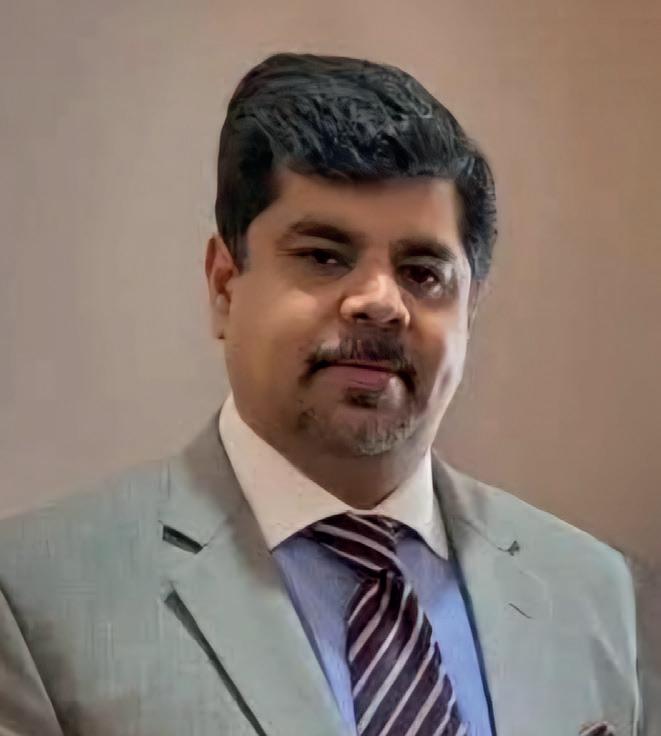

H.E. Ali Haider Altaf, Ambassador of Pakistan to Serbia, shared insights with Diplomacy&Commerce about the recent Bilateral Political Consultations held in Islamabad. The meeting, marking a renewed phase in SerbiaPakistan relations, covered key political and economic cooperation areas, including trade, labour mobility, and diplomatic training. The ambassador highlighted the significance of these discussions in strengthening diplomatic ties and fostering new opportunities for collaboration between the two nations.
Both sides emphasised the significant progress made in the political dialogue between Pakistan and Serbia. The Pakistani side reiterated its commitment to further strengthening cooperation and highlighted the potential for expanding economic collaboration, particularly through increased trade and mutual cooperation in areas of shared interests. Issues pertaining to labour mobility, educational cooperation, and increased people-to-people contact were discussed.
During the consultations, a Memorandum of Understanding was also signed between the Diplomatic Academy of the Ministry of Foreign Affairs of
AFTER 14 YEARS, SERBIA AND PAKISTAN HAVE REVIVED HIGHLEVEL POLITICAL CONSULTATIONS, OPENING NEW AVENUES FOR COOPERATION

the Republic of Serbia and the Foreign Service Academy of Pakistan. This MoU will promote and develop mutual cooperation between the countries, aiming to better educate and train diplomats through regular exchanges.
SERBIA’S INVITATION TO THE PRESIDENT OF PAKISTAN TO ATTEND EXPO 2027
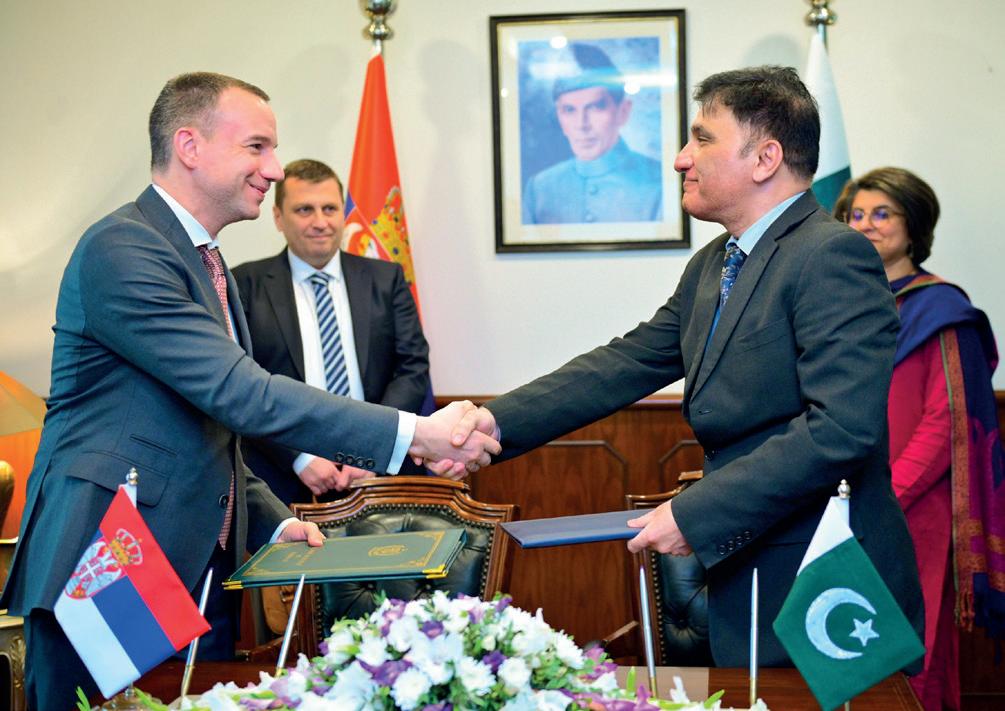
The consultations covered a range of policy issues, including Serbia’s European Union integration, developments in Eastern Europe and the Balkans, and Pakistan’s foreign policy in South Asia. Both sides agreed on the importance of continuing regular political consultations to deepen bilateral engagement further. Kosovo and Metohija were also discussed in detail. Serbia explained its policy and position, which enabled the Pakistani side to better understand the Serbian position on Kosovo and Mitohija.
The State Secretary also called on the Minister for Commerce, Jam Kamal Khan.
The Serbian delegation reiterated Serbia’s invitation to the President of Pakistan to attend Expo 2027, which the Pakistani side acknowledged.
Both sides also discussed the reopening of the Serbian Mission in Islamabad in the near future. They agreed to hold the 6th round of Bilateral Political Consultations in Belgrade in 2026 on mutually agreed-upon dates. This renewed engagement has provided both countries with a better perspective on their respective regional situations.

Inflation, if it is small, is beneficial. Deflation is undesirable, and high inflation is even more detrimental. The „king“ of nasty things is – hyperinflation! Let’s examine the worst hyperinflation cases in history and how they ultimately concluded— starting with the present. The worst inflation in the world was registered in Zimbabwe, with a rate of 561%, followed by Argentina, with 250%. Both countries have experienced terrible political turmoil in recent years, and their governments have been blamed for the inflation. The third place was occupied by war-torn Sudan, with 145%, followed by the long-standing champion Venezuela, a country under American sanctions, with 100%. Türkiye had a 60% inflation rate, while yet another civil wartorn country in Africa, South Sudan, was sixth with 55%. The government has been unable to capitalise on its oil-rich fields for a decade and a half. Sierra Leone and Iran follow with 39% and 38%, respectively, the latter being induced by American sanctions, of course. Egypt concludes the Top 10 with 33% and Malawi with 28%. Others and its oligarchies always use poor Africa.
And what about the records? We, in Serbia and Montenegro, then known as FR Yugoslavia, took part in one of the worst episodes. But not the worst. Consumer prices in Venezuela grew at an astounding average annual rate of 3,608.8% from 1980 to 2020. That meant that a product that cost 100 bolivars in 1980 cost 104,800 trillion bolivars by the start of 2021. By 2023, inflation had tapered off to 400% annually. Now, the 100% inflation from 2024 does not look so bad, right? However, let’s take a closer look. Soviet inflation from September 1989 was 674%, and the prices doubled every 13.09 days. However, in June 1986, Italy experienced an even more severe case, with 8.99% inflation on a daily basis. The civil war in China did not help the yuan in April 1949, when it took 5.27 days to double the price of any item or service. However, this is nothing compared to the end of World War II in Greece, where inflation hit 13,800% in October 1944. The prices doubled every 4.3 days, and the monthly inflation rate reached a peak of 13,800%. The government responded by introducing price controls and rationing. However, it took many years before they were
able to bring inflation under control. The prices stabilised only in 1947. One of the reasons for Hitler’s ascent to power was the famous hyperinflation in Germany in October 1923, when prices doubled in 3.65 days, marking the culmination of hyperinflation with a staggering 29,500% increase. The Republic of Srpska in Bosnia and Herzegovina had its separate currency following the secession of Bosnia, and it did not fare well. In January 1994, the inflation rate was 2.97 × 10^8%, meaning the price doubled every 1.40 days. The same month was also tragic for FR Yugoslavia. The inflation rate was 3.13×10^8 % or 64.63% daily, and it took 1.39 days to double prices. Zimbabwe was frequently in trouble, so in November 2008, it recorded an inflation rate of 7.96 × 10^10 %, which means prices doubled every morning. And the worst case is yet another war-torn country, or the country that lost the war - Hungary in July 1946. The inflation rate was staggering, at 4.19×10^16 %, or 207.19% daily, so prices doubled in the morning and in the evening. Its former currency, the pengő, saw the issuance of the biggest banknote ever: 100 quintillion pengő (10^20).
19 FEBRUARY 2025
Exequatur Presented to the Honorary Consul of the Republic of Kazakhstan in Belgrade
Acting Assistant Minister, Ambassador Nataša Rašević, presented the exequatur to the Honorary Consul of the Republic of Kazakhstan in the Republic of Serbia, Mrs. Milanka Karić, today.
At the ceremony held at the Ministry of Foreign Affairs, which was also attended by the Ambassador of the Republic of Kazakhstan to Belgrade, Madi Atamkulov, the traditionally good and friendly relations between the two countries were reaffirmed.
According to Ambassador Rašević, the assumption of duties by the Honorary Consul will provide an additional impetus not only to the development of consular relations but also to the overall deepening of bilateral ties.
The Consulate of the Republic of Kazakhstan is located in Belgrade, with a consular jurisdiction that covers the city of Belgrade.
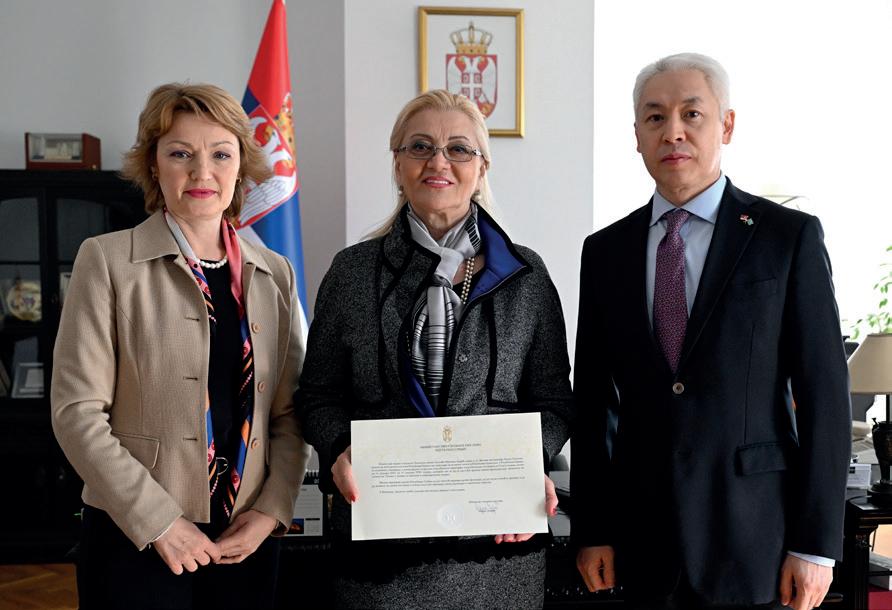

28 FEBRUARY 2025
Farewell Visit of the Ambassador of Indonesia
State Secretary at the Ministry of Foreign Affairs of Serbia, Nikola Stojanović, received the Ambassador of the Republic of Indonesia to Serbia, Mohamad Chandra Widya Yudha, for a farewell visit as he concludes his mandate in the country.
On this occasion, Stojanović expressed his heartfelt gratitude to the ambassador for his dedication and efforts in strengthening the overall relations between Serbia and Indonesia during his tenure.
Stojanović highlighted that in 2024, marking 70 years of diplomatic relations between Serbia and Indonesia, significant high-level visits took place. He recalled that Serbia welcomed Indonesia’s President-elect Prabowo Subianto and the Speaker of the Indonesian
House of Representatives, Puan Maharani. At the same time, the Serbian Prime Minister, Miloš Vučević, attended President Subianto’s inauguration in Indonesia.
Additionally, Stojanović thanked Indonesia for its continuous support and valuable assistance in Serbia’s accession process to the Treaty of Amity and Cooperation in Southeast Asia (TAC), which was successfully concluded during Indonesia’s ASEAN presidency in 2023.
Ambassador Yudha warmly thanked the Serbian leadership for its hospitality and excellent cooperation over the past six years. He emphasised that he will carry fond memories from Serbia and will remain a lasting friend and advocate for further strengthening ties between Serbia and Indonesia.








20 FEBRUARY 2025
The Embassy of Japan in Serbia organised a ceremonial reception in Belgrade to mark the birthday of Emperor Naruhito of Japan, attended by numerous guests from diplomatic, media and public life.
Naruhito Hironomiya has been the Emperor of Japan since May 1, 2019, and was born on February 23, 1960, as the eldest son of Prince Akihito and his wife, Michiko, and as the grandson of the then-Emperor Hirohito. The Ambassador of Japan to Serbia, H.E. Akira Imamura, expressed his gratitude and greeted those present at the reception. This event was attended by Serbian government officials, members of the diplomatic core and other various partners and friends of the Japanese embassy in Serbia.

24 FEBRUARY 2025
On the 24th of February, H.E. Mochammad Chandra Widya Yudha, Indonesian Ambassador to Serbia, held a farewell event due to his departure
The Indonesian Ambassador to Serbia warmly thanked the leadership of our country for their hospitality and excellent cooperation over the past six years.
He emphasised that he would take back from Serbia beautiful memories and mementoes and that he would forever remain a friend of Serbia and promoter of further strengthening of ties between Serbia and Indonesia. The Ambassador emphasised that, although he may be departing, his heart will always hold a special place for Serbia and its remarkable people, and he will remain a friend and advocate for stronger ties between Indonesia and Serbia.

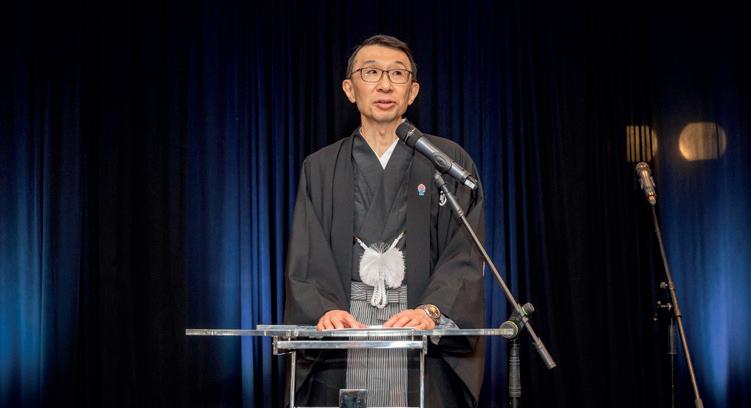

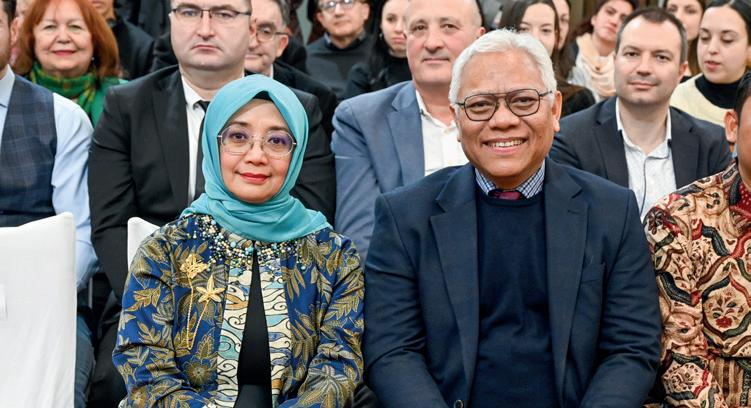
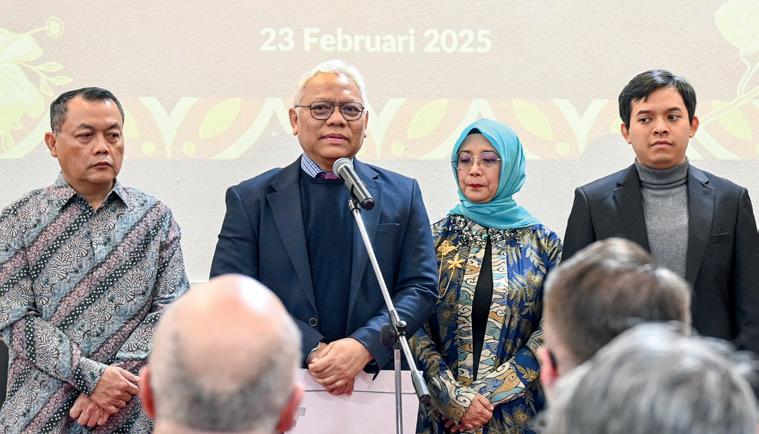
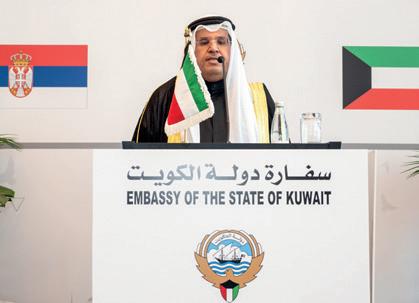
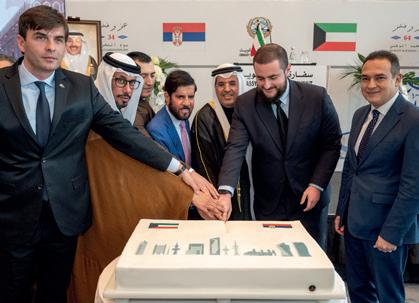
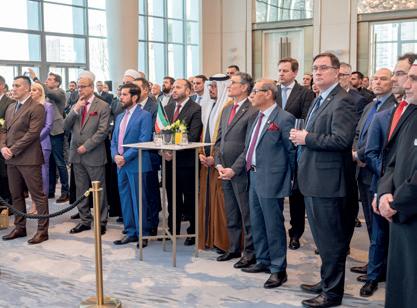
26 FEBRUARY 2025
On February 26th, the Embassy of the State of Kuwait in Serbia organised a solemn celebration of the Day of Statehood and the Day of Liberation. This event, held in commemoration of key dates in Kuwait’s history, brought together
numerous dignitaries and representatives from the country’s political, economic, and cultural spheres. The Ambassador of Kuwait in Serbia, H.E. Fayez Mejbel Almutairi, addressed the audience, thanking them for their arrival and support.

The Minister for Reconciliation, Regional Cooperation and Social Stability, Usame Zukorlić, cut the cake together with the ambassador, symbolising the friendship and cooperation between the countries.

26 FEBRUARY 2025

H.E. Ambassador Maria Levanti and the Embassy of Greece in Serbia hosted the traditional Vasilopita cutting event of the Hellenic Economic Association of Serbia at the Embassy residence on Wednesday, February 26th.
On their social media accounts, the Embassy of Greece wrote: „It was a beautiful evening filled with warmth and wishes for a creative and successful year. We wish the Hellenic Economic Association of Serbia a successful year and that it continues to be a link between Greece and Serbia in the business sector.“

6 MARCH 2025
The Embassy of Finland, in collaboration with Finnagora – The Finnish Institute in Hungary and Europe House in Belgrade - organised a panel on minority languages in Finland, titled “We are Both: Minorities in Finland between Local and Global,” on Thursday, 6th March 2025, at Europe House.
The panel commenced with opening remarks by H.E. Mr. Niklas Lindqvist, Ambassador of Finland, who emphasised the importance of recognising and supporting minority communities. Dr. Riikkamari Muhonen, Director of Finnagora, highlighted the global connections and cultural richness that minorities bring to Finnish society.
Moderated by Prof. Dorijan Hajdu, the panel featured distinguished speakers Dr. Sabira Stahlberg (Finland) and Prof. Johanna Domokos (Hungary/Germany), both researchers in minority and multilingual studies with minority backgrounds.
Following the panel, attendees had the opportunity to watch the film “Je’vida”, directed by Katja Gauriloff. It is the first full-length fictional movie made in Skolt Sámi, with only about 300 speakers in Finland.
Source:EmbassyofFinlandinBelgrade FacebookPage


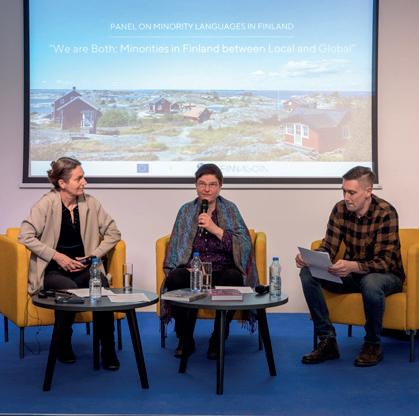










The Latest Issue JANUARY – FEBRUARY 2025
Romanian Experience as a Guide for Montenegro’s EU Path Interview with H.E. Viorel Ardeleanu, Ambassador of Romania to Montenegro Danilovgrad – A city with open doors Aleksandar Grgurović, Mayor of Danilovgrad
For more, please visit: www.diplomacyandcommerce.me
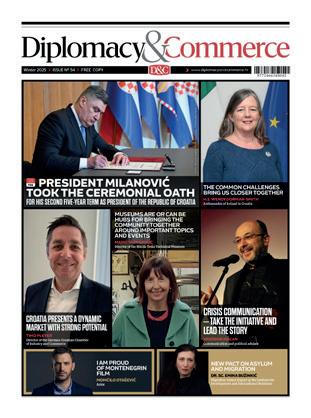
The Latest Issue WINTER 2025
President Milanović took the ceremonial oath for his second five-year term as President of the Republic of Croatia
The common challenges bring us closer together H.E. Wendy Dorman-Smith, Ambassador of Ireland to Croatia
For more, please visit: www.diplomacyandcommerce.hr
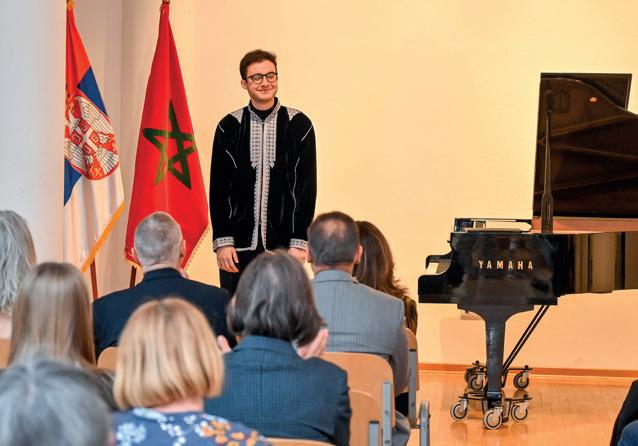

Moroccan pianist Mahmoud El Moussaoui performed at a concert in Belgrade on
The young Moroccan pianist Mahmoud El Moussaoui performed at a concert in the Belgrade Cultural Centre’s ArtGet Gallery. The concert was organised by the Embassy of Morocco as part of the Francophonie Month programme and was attended by numerous ambassadors and representatives of the diplomatic corps.
The repertoire included works by Johann Sebastian Bach, Joseph Haydn, Claude Debussy, Robert Schumann, and Sergei Prokofiev.
Morocco is rich in talent across various artistic fields, and pianist Mahmoud El Moussaoui is a notable example. At just twenty-five years old, Moussaoui is one of his country’s most prominent representatives on the international classical music scene. Born in July 1999 in Kenitra, he began learning the piano at the regional

22 MARCH 2025
conservatory in his hometown at the age of nine. He is currently studying under Wilhelm Latchoumia and Alan Akabo at the Higher School of Arts (Haute École des Arts du Rhin) in Strasbourg. Before that, he completed his studies at the Strasbourg Conservatory, earning high praise from the examination board. Mahmoud has won several prestigious awards. In 2014 and 2016, he won first prize at the International Piano Competition of HRH Princess Lalla Meryem, along with two special recognitions. In 2018, he received second prize and the Best Moroccan Talent award from the Portuguese Embassy. In 2015, he won first prize (piano) and was awarded honours by the Ministry of Culture. He is also a recipient of scholarships and honorary awards from the National Conservatory of Music and Choreographic Arts of Morocco.

In 2018, Mahmoud won the Grand Prix at the inaugural Russian Mushroom Festival in Casablanca. In 2019, he was a scholar of the Yamaha Music Gulf programme in Dubai, UAE. He won third prize at the 8th Competition for Young Classical Musicians from the Arab World in Baku, Azerbaijan. He has successfully performed in several concert halls in Morocco, Germany, France, the United Arab Emirates, Azerbaijan, and Tunisia. His extensive repertoire includes works by composers from the 17th to the 21st century, with a particular passion for performing the music of Beethoven, Debussy, and Schumann. Seeking to refine his musical sensitivity, he has attended masterclasses with renowned professors such as François-Frédéric Guy, Marie-Josèphe Jude, Françoise Thinat, Alexei Sokolov, Anne-Lise Gastaldi, and others.
Mahmoud is also a state-certified engineer in fisheries and aquaculture, holding a master’s degree in management and business administration from EM Strasbourg Business School.
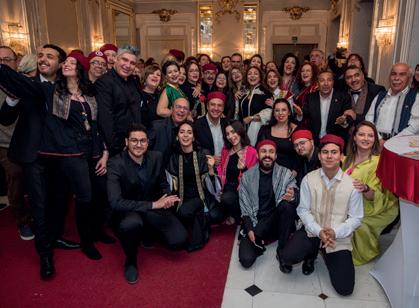
On the 20th of March, in Belgrade, The Carthage Symphony Orchestra graced the stage of the National Theater in Belgrade to commemorate the 69th anniversary of Tunisia’s glorious Independence Day
This celebratory concert brought together distinguished guests and showcased the strong cultural ties between Tunisia and Serbia.
The event was honoured by the presence of several prominent dignitaries, including Mr Damjan Jović, Secretary of State for Foreign Affairs, Mr Lav Pajkić, Secretary of State at the Ministry of Culture; and Mr Ivan Bošnjak, Secretary of State to the Ministry of Human Rights, Minorities and Social Dialogue. Also in attendance were representatives of the Serbian
government, local authorities, members of the Tunisian community, and friends of Tunisia residing in Serbia.
The evening served as a testament to the enduring friendship and cultural exchange between the two nations, uniting diverse communities through the universal language of music.
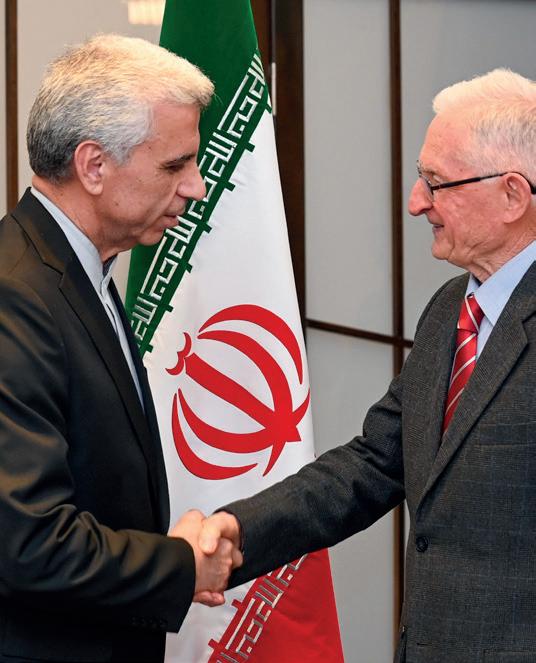
“ARGO” VS “SKY HOOK”
February 6th
Rashid Hasan Pur Baei, ambassador of Iran to Serbia, Živadin Jovanović, minister of foreign affairs of FRY during NATO bombing of Yugoslavia (1998-2000)Iranian National Day.

February 20th
Ambassador of Japan to Serbia Akira Imamura at Birthday Reception of Emperor of Japan, Metropol Palace Hotel.
“IS THE NEW U.S. AMBASSADOR ARRIVED? HE WILL BE MY NEW BEST FRIEND”
February 25th
Ambassador of Russia to Serbia, H.E. Alexander Botsan-Kharchenko, National Day of Kuwait, St. Regis Hotel.
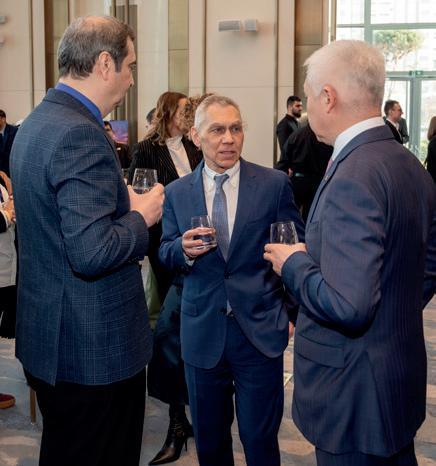

February 23rd
The outgoing Ambassador of the Republic of Indonesia to the Republic of Serbia, H.E. Mochammad Chandra Widya Yudha, at his farewell party - Embassy of Indonesia.
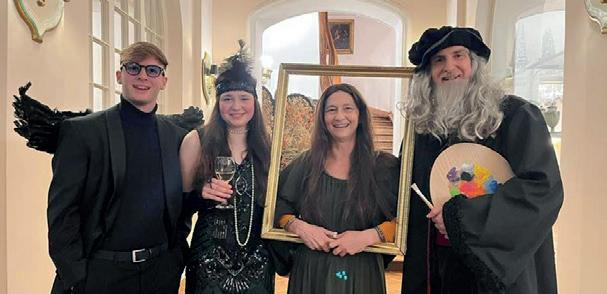
March 1st
Italian ambassador Luca Gori with his family at Carnival Party at Italian Embassy.

February 26th
Maria Levanti, Greek ambassador to Serbia, Reception at Greek ambassador’s residence.

F OCUS ON
FeatUred interView a PartnerSHiP BUilt On innOVatiOn and trUSt
H.E. Mrs. Anne Elisabeth Lugon-Moulin
Swiss Ambassador to Serbia March
ECONOMICAL INTERVIEW
FrOM CHallenGeS
tO GrOwtH in SwiSS-SerBian trade
Dragica Tomčić Economic Affairs Officer at the Swiss Embassy in Serbia
CORPORATE INTERVIEW eMPOwerinG
SMall BUSineSSeS
FOr BiG SUCCeSS
Aleksandar Goračinov Director of SME HUB
Swiss investments reshape industries, while green energy and technology open new frontiers
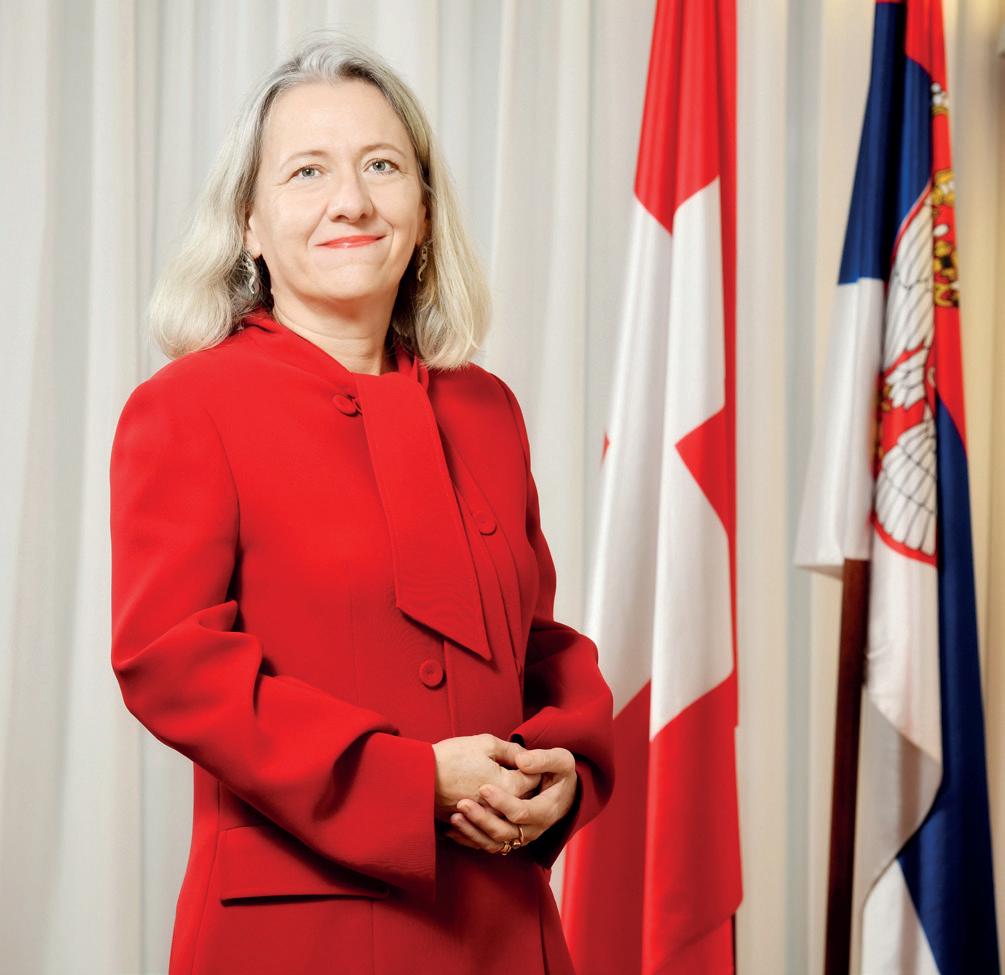
H.E. MRS. ANNE ELISABETH LUGON-MOULIN
Swiss Ambassador to Serbia
Switzerland has long been a key economic partner to Serbia, with investments spanning industry, technology, and sustainable development. Recently posted to Belgrade, Swiss Ambassador Anne Elisabeth Lugon-Moulin shares insights on the latest developments in SwissSerbian relations, the impact of strategic investments, and the future of this dynamic partnership.
You recently assumed the position of Swiss Ambassador to Serbia. How has your transition to life in Belgrade been? What do you like most about the city, and is there anything you miss from home?
Belgrade is a fascinating city, and I have felt incredibly welcomed since my arrival. It is full of energy and rich in cultural and historical heritage. I love walking along the rivers, exploring different neighborhoods, and experiencing the city’s vibrant atmosphere. What makes Belgrade truly special for
me is its people—their warmth, hospitality, and openness are remarkable.
Having lived abroad for more than five years now, I am used to missing things from Switzerland, especially our cheeses and chocolate, the mountains near my home, and the breathtaking view of the vineyards around Leman Lake. I was genuinely thrilled to return to the European continent and settle in Serbia. My time here has been very dynamic, and I appreciate how many activities and
collaborations are taking place between our two countries.
President Vučić visited Switzerland in December and met with 2024 Swiss President Viola Amherd. What were the key discussion topics, and what impact do you expect this visit to have on Swiss-Serbian relations?
President Vučić’s visit to Switzerland was a significant moment for our bilateral relations. Discussions focused on economic cooperation, trade and investment, and Swiss support for introducing the dual vocational education system in Serbia. Both sides acknowledged the strong economic ties between our countries and the potential for further Swiss investments in Serbia, particularly in innovation, sustain-
SWITZERLAND SEES GREAT POTENTIAL IN SERBIA, ESPECIALLY IN INNOVATION, GREEN ENERGY, AND DIGITAL TRANSFORMATION
able development, and tourism. The visit also underscored the important role of the Serbian diaspora in Switzerland, which serves as a valuable bridge between our two nations.
I believe this visit reinforced our political dialogue and set the foundation for expanding economic and cultural cooperation. I expect to see even greater Swiss interest in Serbia, especially in key sectors like green energy, digital transformation, and artificial intelligence—areas where both our countries are highly advanced.
Switzerland is one of the most significant investors in Serbia. Which sectors attract the most Swiss investment, and where do you see potential for further expansion?
Switzerland has a strong presence in Serbia, particularly in services, pharmaceuticals, large industries and IT. In recent years, there has been a growing interest in digital transformation, biotech, and large-scale industries. Swiss companies appreciate Serbia’s skilled workforce, strategic location, and business-friendly environment.
There is still potential for expansion, especially in technologydriven sectors and renewable energy. Serbia’s startup ecosystem is developing rapidly. Real estate is also a new sector where Swiss investments are coming into the country.
Serbia has recently completed its second renewables auction with the support of the European Bank for Reconstruction and Development (EBRD), funded by Switzerland, marking a significant step toward a greener energy future. How do you see the role of Swiss investors and expertise in contributing to Serbia’s renewable energy transition?
The success of the renewables auction demonstrates Serbia’s commitment to green energy, and it opens doors for further investment in solar, wind, and other renewable projects. Swiss expertise in energy efficiency, smart grids, and sustainable infrastructure could play a crucial role in helping Serbia meet its long-term environmental and economic goals.

In December, Switzerland hosted the Swiss-Serbian Innovation Forum. What were the key takeaways from this event?
Switzerland has consistently ranked number 1 on the European Union Innovation Scoreboard (covering countries outside of the EU also) and on the UN World Intellectual Property Organization’s Innovation Index for over a decade.
We are one of the countries in the world spending the most on Research and Development (compared to GDP). The Forum was thus an opportunity to have the Head of the Swiss delegation exchange with Minister of Science, Technological Development and Innovation J. Begovic on systemic issues related to research and sciences in both countries.
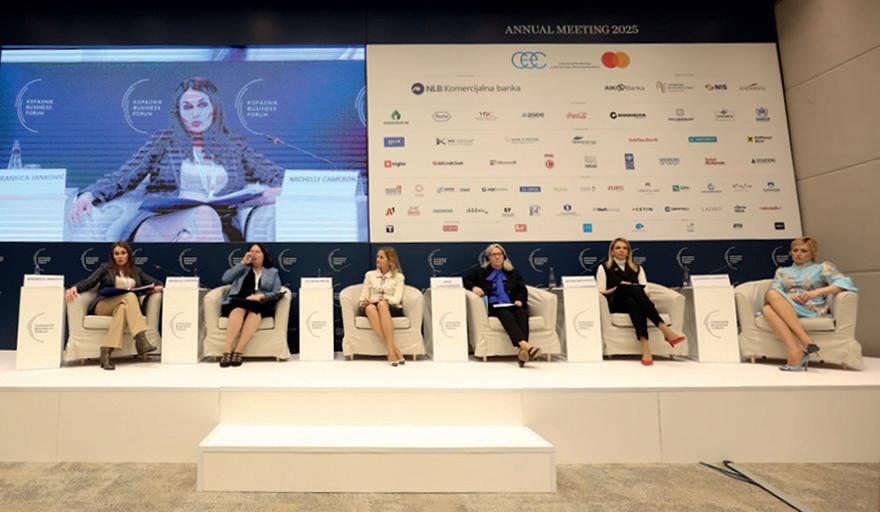
The Swiss-Serbian Innovation Forum was also a fantastic opportunity to highlight the collaboration potential in technology and entrepreneurship. It brought together 500 participants (eg startups, business leaders, and policymakers) to discuss fostering cooperation in areas such as AI, biotech, and sustainable innovation. One key takeaway was the recognition that Serbia is an attractive destination for Swiss investors, particularly in high-tech industries. We established several new connections and are currently exploring ways to support follow-up initiatives.
How would you assess the current trade relations between Serbia and Switzerland? Are there specific areas where cooperation could be strengthened?
Trade relations between Serbia and Switzerland have been steadily growing over the past five years, making Switzerland one of Serbia’s key economic partners, particularly in the services sector, where we rank Serbia’s fourthlargest partner worldwide. Serbia’s exports to Switzerland, especially in machinery, agriculture, and IT services, have also been increasing, which has resulted in a positive trade balance for Serbia. Let me also recall that we have had a bilateral free-trade agreement in place for more than ten years. In 2023, the total trade of goods between the two countries amounted to 708.6 million euros, marking a slight decrease compared to 2022, but when we add services, we are coming up to 2 billion of trade per year. There is, thus, room for improvement. We are actively encouraging Serbian companies to explore opportunities in Switzerland and vice versa, with a strong emphasis on strengthening business-to-business ties in the coming years.
Serbia has seen an increase in student protests and political activism. Do you see political instability in Serbia as a potential risk factor for foreign investments, including Swiss businesses operating in the country?
Private companies need a stable environment to plan their future investments. While the current political momentum is peaceful, it brings a certain level of uncertainty about the future. Therefore, I do see a risk—albeit limited in time—of the private sector being in a “wait and see” mode.
The Swiss government, through SDC and SECO, has been actively supporting small and mediumsized enterprises (SMEs) in Serbia. Can you elaborate on this program and its impact?
SMEs are the backbone of the Swiss economy, and they play a crucial role in job creation and innovation in Serbia as well. Through the Swiss Agency for Development and Cooperation (SDC) and the State Secretariat for Economic Affairs (SECO), we have supported Serbian SMEs by improving access to finance, enhancing business skills, and promoting digitalisation. Our new flagship project is the SME Hub.
Can you share some success stories or notable achievements from this program?
There have been many inspiring success stories. We have seen Serbian startups expand internationally after receiving support from Swiss-backed initiatives. Additionally, traditional businesses have modernised their operations, making them more competitive in European markets. Over the past three years, 147 companies have improved their international market access, thanks to Swiss support.
One outstanding example is Adoré Chocolat, a family-run business specialising in handmade pralines and premium-quality chocolates. With support from SME HUB, Adoré strengthened its organisational, financial, and management capacities, which enabled collaboration with Bambi. While Adoré was already a recognised producer of high-quality handmade chocolates, transitioning from artisanal to industrial production was crucial for its growth and developing its new product, Plazma Praline.
What are the future priorities for Swiss support in this area?
We will continue focusing on innovation, modernisation, and expanding vocational education programs. The dual education system in Switzerland has been a key factor in our country’s economic growth, innovation, and low youth unemployment rate. We want to help Serbia expand vocational education programs to ensure young people acquire skills relevant to the jobs of the future. Additionally, assisting Serbian SMEs in adopting digital transformation and green technologies will be a priority. The Science and Technology Park in Belgrade, which we have
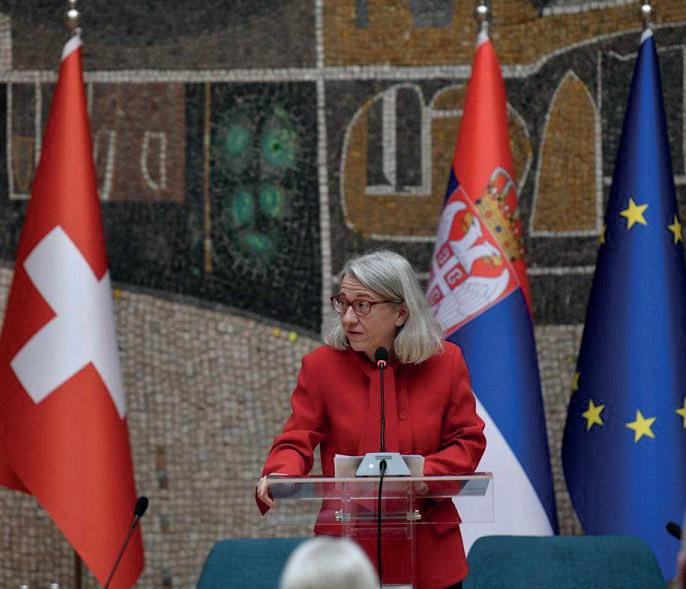
supported since its onset, will remain a key partner for us. Several start-ups have been created at the STP, thanks to the long-lasting support of Switzerland. The Swiss Serbian Chamber of Commerce is also doing a very good job in connecting Swiss companies with key stakeholders in the country. According to the National Bank of Serbia, 600 Swiss enterprises are present in the country.
Freedom of expression and democratic values are key elements of Swiss foreign policy. How does Switzerland engage with Serbia in these areas?
We have been supporting local governance projects for some decades now. As Switzerland is a highly decentralised country, we have especially engaged
ourselves at the local level in Serbia in fostering citizen participation, transparency in public spending and public oversight mechanisms. In doing so, we have always worked and helped all involved actors: the respective Ministry in designing the system, the Standing Conference of Towns and Municipalities for fostering intermunicipal exchanges and best practices, as well as some local CSOs and NGOs to enhance public participation and check-and-balances.
How does Switzerland view Serbia’s EU accession process, and in what ways is it assisting the country on this path? Switzerland supports all Balkan countries in their respective paths towards EU membership.

Our development cooperation portfolio worth 20 million euros/ year is geared towards three key sectors of importance for Serbia’s reforms: economic development and innovation, climate change and energy, and governance. As a non-EU member, it is not up to Switzerland to judge the EU accession process of Serbia. We support the end goal because we believe that the Balkans need to be better integrated with Europe.
Serbia has a significant diaspora in Switzerland. How do you assess their contribution to Swiss society and the economy?
The Serbian diaspora in Switzerland is a well-integrated and dynamic community that has made substantial contributions in my country across multiple sectors, including business, academia, medicine, sports, and culture. Its hard work and entrepreneurial spirit have enriched Swiss society in countless ways.
Many Serbian expatriates maintain strong ties to their homeland by sending remittances, investing in businesses, and fostering economic cooperation. I am also amazed to see how many cultural projects bridging our two societies are emerging from Serbian people living in Switzerland and Swiss citizens who join talent and forces together. Our Embassy also tries to offer them an expanded visibility. They are an invaluable link between our two countries.
Looking ahead, what is your vision for Swiss-Serbian relations in the coming years? I am very optimistic about the future of our partnership. Switzerland and Serbia share a strong foundation of trust and friendship; next year, we will celebrate 110 years of diplomatic relationships. I see numerous opportunities for deepening our cooperation. Innovation, sustainability, and investment in human capital will be key focus areas of our work, be it through our development cooperation portfolio or the private sector.
Lastly, EXPO 2027 will offer significant opportunities to connect our two countries further. I was very proud to represent Switzerland as the first country to officially announce its participation in EXPO 2027, demonstrating our commitment and reliability in Serbia.
Small and medium-sized enterprises (SMEs) in Serbia are increasingly seeking ways to enhance their operations and establish long-term partnerships with larger companies. For the past year, SME HUB has been supporting such businesses, helping them become competitive suppliers by enhancing their organisational capacities, business processes, and standards. The results achieved over the past year and those to come are reflected in the experiences of companies participating in this initiative, as well as plans to expand the support network.
Aleksandar Goračinov, Director of SME HUB, says that from the outset, the initiative has been focused on tangible results –strengthening the capacities of small and medium-sized enterprises so they can become reliable partners to large companies. “From the very beginning, we set clear objectives – to provide adequate expert support to domestic firms, enabling them to strengthen their capacities and integrate into global supply chains,” he emphasises.
Through a detailed analysis of needs, tailored development plans, and targeted support in professionalising management, financial management, human resources, production processes, certification, and compliance with international standards, SME HUB helps businesses enhance their competitiveness. “The first step in this process is understanding where companies currently stand and what they need to reach the next level of development,” Goračinov adds.
The results so far confirm the effectiveness of this approach –domestic companies that have undergone SME HUB’s transformation are already making significant strides in cooperation with large firms. In its second year, the programme aims to support 15 more companies, with the ultimate goal of guiding a total of 80

SOMETIMES, THE KEY CHALLENGE IS CHANGING THE MINDSET – ADAPTING OPERATIONS TO THE STANDARDS OF LARGE COMPANIES CAN BE DEMANDING, BUT IT BRINGS LONG-TERM BENEFITS
enterprises through the initiative. These businesses will acquire the necessary knowledge, resources, and business opportunities to foster sustainable growth and development. “It is essential for small and medium-sized enterprises to recognize that this is not a onetime intervention, but a long-term process, integral to a broader strategy for sustained development,” Goračinov emphasizes.
One of the most valuable lessons the SME HUB team shares from experience is a systematic approach to business development, with a focus on precision, quality, efficiency, and long-term planning. A team of experts with extensive experience in the business sector, together with
carefully selected consultants, helps domestic companies optimise business processes, introduce necessary modernisation, and strengthen organisational capacities. “Sometimes, the key challenge is changing the mindset – adapting operations to the standards of large companies can be demanding, but it brings long-term benefits,” says Goračinov.
In the coming period, SME HUB will continue to expand its network of supported small and medium-sized enterprises, focusing on sectors with the highest potential for collaboration with large companies, such as the food and chemical industries, metal processing, and
plastic processing, among others. Aleksandar Goračinov also highlights a unique aspect of the SME HUB initiative—the call for applications for grant funding is permanently open. “An open call means that businesses can apply whenever they are ready and when they identify the need for support,” Goračinov explains.
After a year of operation, the results are already visible, and the number of domestic companies entering the programme continues to grow. In the latest cycle, five new companies have begun their business transformation process, bringing the total to 14 small and medium-sized enterprises that have either completed or just started the programme. The latest participants include companies from the cosmetics industry, food production, aluminium and PVC joinery, roller shutter manufacturing, and IT sales. “Their connection with large companies opens up new markets and enables the development of innovative products,” he notes.
The total value of support for these new companies exceeds 600,000 Swiss francs and includes a range of services to assist in their business transformation, such as management, finance, ERP, legal, and HR services. After implementing the support, they are expected to achieve significant revenue growth, with estimates suggesting an increase of more than 35% in the coming period.
“These results confirm the importance of the SME HUB initiative as a key mechanism for enhancing the capacities of small and medium-sized enterprises and integrating them into the value chains of large companies,” Goračinov concludes.
SME HUB is a public-private partnership initiative of the Swiss Agency for Development and Cooperation (SDC) and the Serbian company ICT HUB, providing support to domestic businesses in strengthening their organisational capacities and competitiveness.

how trade agreements, innovation, and sustainability are shaping the next phase of economic cooperation
DRAGICA TOMČIĆ
Economic Affairs Officer at the Swiss Embassy in Serbia
Over three decades, Dragica Tomčić, Senior Economic Affairs Officer at the Swiss Embassy in Serbia, has witnessed the transformation of Swiss-Serbian economic relations. From early challenges to strong trade and investment ties, she reflects on key milestones, Swiss business adaptability, and future opportunities in sectors like innovation, sustainability, and technology.
Over your 30 years of service, how would you describe the evolution of economic relations between Switzerland and Serbia?
from a phase of uncertainty and minimal engagement to one of robust and growing cooperation. In the early years, due to the regional
SWITZERLAND AND SERBIA MOVED FROM UNCERTAINTY TO STRONG ECONOMIC COOPERATION
Over the past three decades, the economic relationship between Switzerland and Serbia has transformed significantly, evolving
conflicts, political instability, and the imposition of sanctions, the economic ties were limited. However, Switzerland’s consistent
support for Serbia during this time, particularly through humanitarian aid and development programs, laid the foundation for future growth. The most defining moments of this relationship have been the signing of the EFTA Free Trade Agreement in 2009, which drastically reduced trade barriers and spurred the flow of goods between the two countries, and the establishment of the SwissSerbian Chamber of Commerce in 2014, which further promoted business networking, market access, and mutual collaboration. These initiatives, alongside the
unwavering commitment from both governments to foster deeper economic ties, have led to significant achievements in trade, investment, and institutional cooperation. Today, Switzerland is one of Serbia’s most important economic partners.
Reflecting on your early years at the Embassy, what were some of the major challenges and opportunities in establishing economic ties with Serbia?
The initial years were fraught with challenges that stemmed from the fallout of the Yugoslav Wars, hyperinflation, and the harsh sanctions imposed on the region, which isolated Serbia from the international community. These factors created a volatile economic environment where foreign investors were cautious about entering the Serbian market. At the same time, Serbia was undergoing a period of transition, shifting from a socialist to a market economy, and this created opportunities for engagement, though it was difficult to navigate the bureaucratic red tape, corruption, and lack of regulatory clarity. The administrative hurdles, weak institutional frameworks, and lack of trust in the system created barriers to foreign investments. However, the democratic transition in 2000 marked a pivotal moment, enabling Serbia to initiate reforms and welcome foreign investments, particularly following

the signing of the Stabilization and Association Agreement (SAA) with the EU in 2008. Swiss businesses slowly began to take notice of Serbia’s market potential, and by the mid-2000s, they started exploring opportunities, especially in sectors like manufacturing, retail, and telecommunications.
Which key milestones or turning points do you believe have most significantly shaped the robust economic partnership we see today?
Several milestones stand out in shaping the robust economic partnership between Switzerland and Serbia. One of the most crucial
turning points was the signing of the Free Trade Agreement with EFTA in 2009. Another major milestone was the creation of the Swiss-Serbian Chamber of Commerce in 2014, which served as a bridge for Swiss businesses seeking to enter the Serbian market and for Serbian companies looking to expand to Switzerland. Additionally, Switzerland’s longstanding development aid to Serbia, which has amounted to over 440 million Swiss francs, has been instrumental in supporting

Serbia’s economic and institutional reforms, focusing on sectors such as governance, financial sector stabilization, and private sector development.
How have Swiss investors and businesses adapted to the shifting political and economic landscape in Serbia during your tenure?
Swiss investors and businesses have demonstrated remarkable adaptability to Serbia’s shifting political and economic landscape over the past three decades. In the early days of transition, Swiss companies were hesitant to invest due to the uncertainties caused by the wars, sanctions, and the initial lack of regulatory clarity. However, as Serbia’s political climate stabilized, Swiss investors began to cautiously re-enter the market, with many focusing on industries that offered long-term growth potential, such as consumer goods, construction materials, and pharmaceuticals. The Swiss government also provided important financial and advisory support to help Serbian authorities modernize the regulatory environment and streamline processes, making it easier for businesses to navigate the market.
With Serbia’s gradual integration into the European Union, particularly after signing the SAA, the environment became more conducive to foreign investments, which allowed Swiss firms to expand further. Over the years, Swiss businesses, including Nestlé, Holcim, and ABB, diversified their investments to include sectors like manufacturing, IT, and sustainable energy.
What lessons learned over these three decades do you think will be crucial for guiding future collaboration between our two countries?
The collaboration between Switzerland and Serbia over the last three decades offers a wealth of lessons that will be crucial for guiding future relations. One of the most important lessons is the need for flexibility and adaptability in the face of changing political and economic conditions. Switzerland’s ability to adapt to Serbia’s evolving political climate and regional dynamics, especially during times of conflict and transition, has been crucial to maintaining a strong partnership. Another lesson is the importance of continuous investment in innovation and technology transfer. Switzerland’s strong, innovation-driven economy has been a valuable resource for Serbia, especially in sectors like clean energy, IT, and engineering. Moving
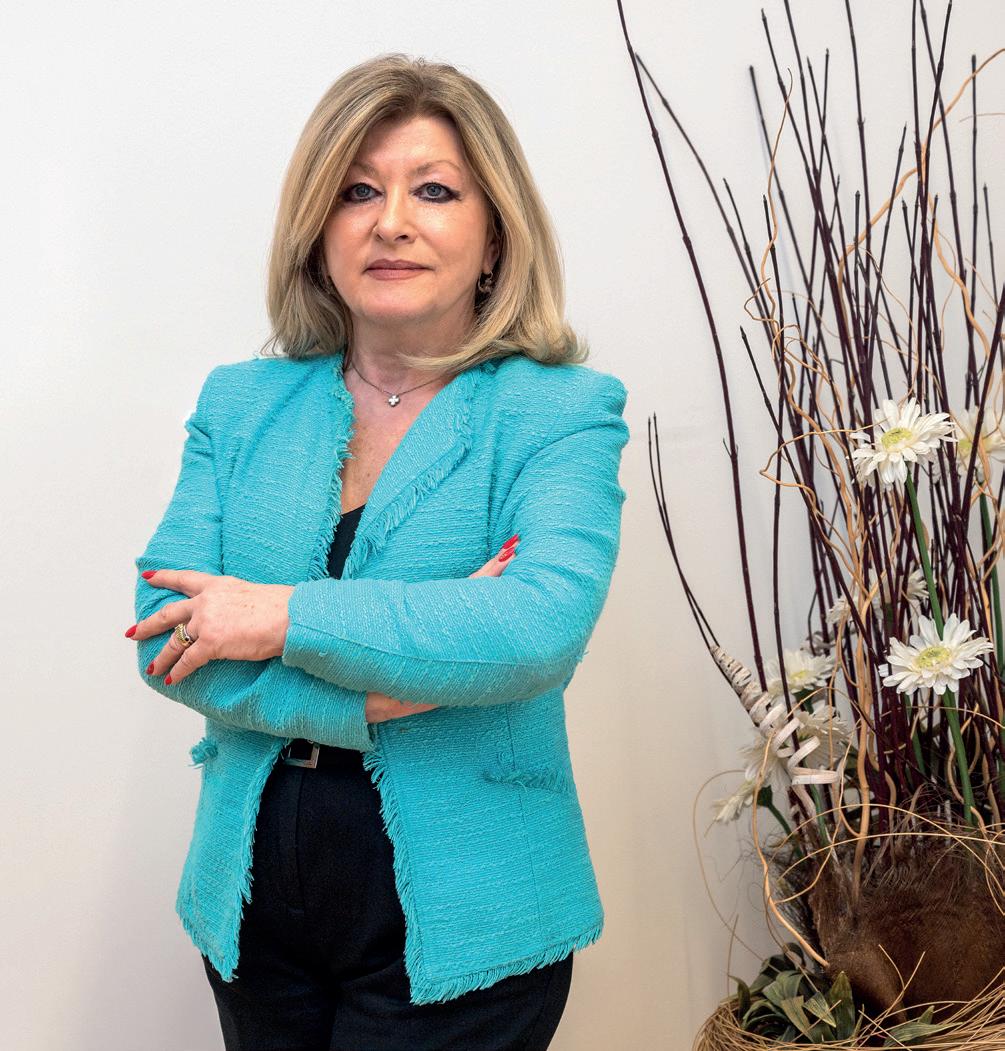
SWISS INVESTMENTS HAVE PLAYED A KEY ROLE IN SERBIA’S ECONOMIC TRANSITION AND GROWTH
forward, both countries can benefit from focusing on deepening innovation partnerships and fostering the development of Serbia’s tech ecosystems. Sustainability is also a key area of focus. Switzerland’s expertise in clean energy solutions and environmental management has helped guide Serbia’s green transition, and both countries can continue to collaborate on renewable energy infrastructure, smart cities, and green technologies. Furthermore, strengthening human capital development, skillbuilding, and institutional capacity will be essential for long-term success. Future cooperation should prioritise these areas, ensuring that both countries remain resilient and competitive on the global stage.
Which sectors do you see as most promising for future growth in bilateral trade and investment, and how might these opportunities be best leveraged?
The future growth of bilateral trade and investment between Switzerland and Serbia holds enormous potential in several strategic sectors. Technology and innovation, particularly in AI, fintech, biotech, and automation, are key areas for future expansion, leveraging Serbia’s rapidly growing IT sector and Swiss expertise in precision industries. Renewable energy is another sector that holds immense promise, with opportunities for Swiss companies to invest in Serbia’s
solar, wind, and hydropower projects. The green energy sector, in particular, offers a huge potential for collaboration between the two countries. Additionally, Serbia’s skilled labor force and favorable trade agreements make it an attractive location for Swiss companies to set up production facilities, particularly in hightech industries. Startups and innovation hubs present an exciting opportunity for joint research and development (R&D) projects between Swiss and Serbian universities, which can lead to groundbreaking innovations. Furthermore, the Swiss-Serbian Chamber of Commerce can play a vital role in strengthening business networks and facilitating matchmaking events, trade delegations, and investment forums that attract more Swiss SMEs to Serbia. These sectors, along with the continued focus on innovation and sustainable growth, will be crucial for the future of the bilateral economic relationship.

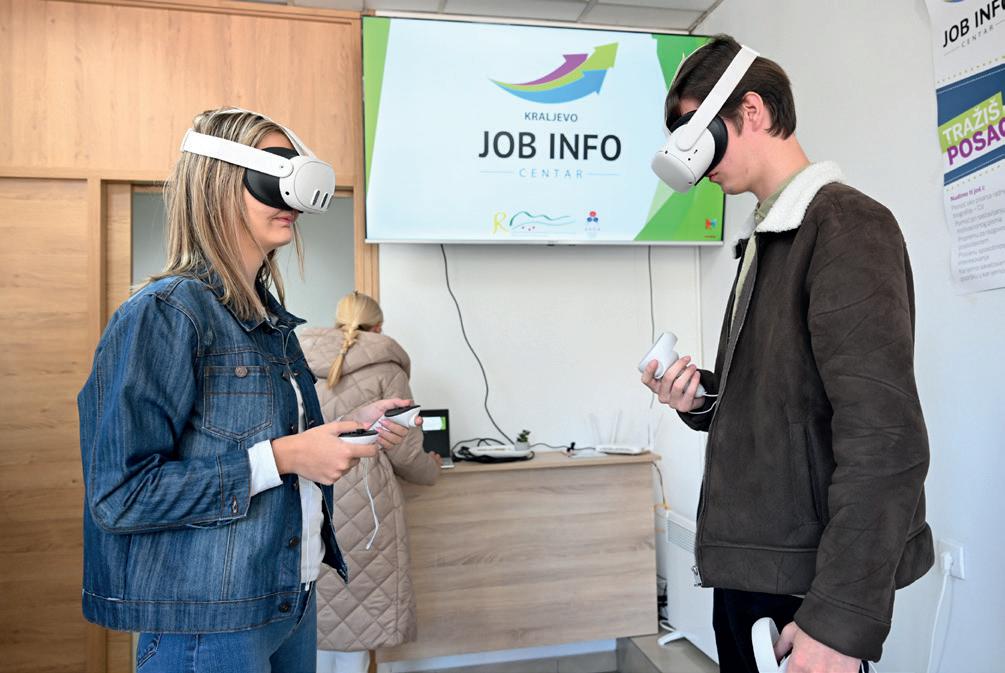
Serbia, on its path to embracing democratic values and achieving economic growth, has received consistent support from the Swiss Government. Among its impactful initiatives is the “Education to Employment” (E2E) project, which enhances employment by integrating Swiss expertise into local innovations and communities.
In an era where technological advancements are rapidly reshaping the job market, effective career guidance has become paramount. E2E exemplifies a forward-thinking approach, notably by introducing, for example, online-based competence assessments and VR technology in its Job Info Centers. As a twelve-year partnership between the Swiss and Serbian governments, the project aligns education with market demands through 11 Job Info Centers across 15 regions. These Career Guidance hubs, similar to the BIZ in Switzerland, provide tailored career counselling services to Serbian youth.
THE

Drawing from Switzerland’s rich legacy in vocational education and leveraging innovative digital career tools and interest and competence assessments, a specialised career guidance service methodology has been developed as a training program for career practitioners. Career professionals offer individual and group counselling, as well as information and support in career planning, and adapt methods to engage Serbian youth. A key innovation is the use of VR technology to provide immersive, hands-on experiences in various professions. Young individuals can virtually experience different professions before making career decisions, bridging the gap between theory and practice.
The impact is impressive: over 38,000 young people have benefited from career guidance services, with many securing employment after on-the-job training in companies. One participant shared, “The VR experience helped me understand the job and make an informed career choice.”
Merging Swiss vocational guidance principles with cutting-edge technologies and motivated and competent career practitioners demonstrates a holistic approach to career counselling. By speaking the language of today’s youth and providing them with tangible tools to explore their futures, Serbia, through E2E, is setting a precedent in preparing its younger generations for the evolving demands of the global job market.
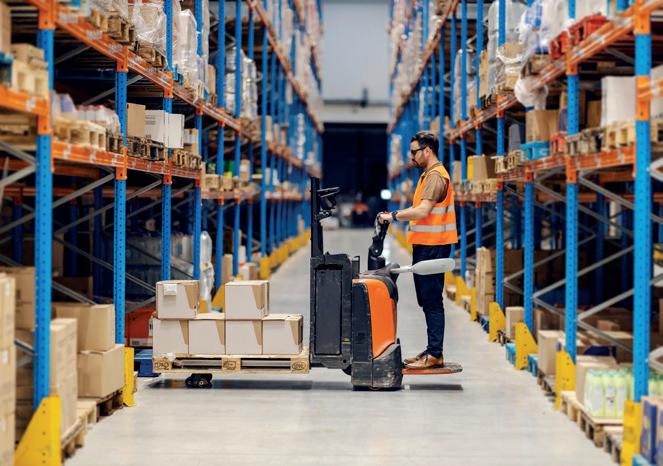
The Chamber of Commerce and Industry of Serbia (CCIS), in cooperation with the Swiss Import Promotion Programme (SIPPO), is organising a business event to mark the launch of the Sustainable Export Initiative. This initiative aims to enhance the competitiveness of the domestic economy in international markets by implementing sustainable business principles.
The activities within the Initiative align with the United Nations Sustainable Development Goals (UN SDGs) and are directly focused on strengthening the economy’s capacity to understand and apply the requirements of the indicators defined by the 17 goals of the 2030 Agenda. Specifically, it integrates environmental protection, social responsibility, and good governance (ESG dimensions) to encourage businesses to incorporate these principles into their operations. By doing so, companies can gain a competitive edge in the market, enhance their integration into international supply chains and explore export opportunities.
The central topic of the Initiative’s presentation will be the Sustainability Readiness Assessment Tool, designed to help companies evaluate their preparedness for sustainable business practices. Alongside representatives of the SIPPO project, the event will also feature
the National Project Manager of the International Trade Centre. Additionally, a SIPPO consultant will deliver a presentation on Sustainable Marketing and Sales Strategies in International Markets.
The business event took place in late March at the Regional Chamber of Commerce of the South Bačka Administrative District in Novi Sad. More details about this event will be featured in our upcoming editions.
The Swiss Import Promotion Programme (SIPPO) operates under the mandate of the Swiss State Secretariat for Economic Affairs (SECO) as part of Switzerland’s economic development cooperation efforts.
SIPPO’s mission is to facilitate the integration of developing and emerging economies into global trade. While export companies in SIPPO partner countries often have high-quality products for international markets, they face challenges in connecting with potential buyers. At the same time, importers in target markets seek reliable suppliers but encounter difficulties in sourcing them abroad.
To bridge this gap, SIPPO focuses on supporting the last mile of the supply chain, helping exporters and importers connect. The programme works through Business Support Organisations (BSOs), which serve as key intermediaries in facilitating market access and boosting exports to Switzerland, the EU, and regional markets.
SIPPO exclusively supports BSOs in its partner countries— whether public or private entities
such as trade promotion organisations, export boards, sector associations, and chambers of commerce—by strengthening their capacity to assist export-ready companies.
Through local SIPPO teams and a network of international and national experts, the programme enhances the performance of selected BSOs in two key areas: Enhancing trade promotion activities – strengthening BSOs’ capabilities in market research, trade fair participation, selling and buyer missions, and study tours.
Supporting organisational development – assisting BSOs in strategic planning, positioning, project cycle management, knowledge sharing, and continuous learning.
SIPPO operates in 11 partner countries and covers six key sectors: fish and seafood, Processed Foods, Natural Ingredients, Technical Wood, Value-Added Textiles, and Sustainable Tourism. Implemented by Swisscontact in 2017 in partnership with BHP Brugger and Partners and Helvetas Swiss Intercooperation, SIPPO is currently in its second phase (2021-2025).


SANJA PEŠIĆ Chief Executive Officer
As we move well into the first quarter of the 21st century, some companies continue to withstand the test of time through decades, wars, and global crises.
Our parent company, the Swiss based APG SGA, is marking 125 years of successful operations this year and celebrating the story of the billboard as a timeless and trusted medium.
Founded back in 1900 in Geneva, the company was listed on the stock exchange as early as 1904 and has remained the market leader in Switzerland ever since. With over 500 employees, it operates in 17 cities, maintaining a network of both traditional and modern outdoor advertising media. At the same time, while Serbia is out on the streets, the Serbian company Alma Quattro, which is 100% owned by APG SGA, marks 31 years of existence and operations, and can proudly state that it has been and remains the market leader in Serbia. Since its founding in 1994, Alma Quattro has made an exceptional contribution to the development of a new communication channel media and as a pioneer, has consistently stayed one step ahead of the market. Both APG SGA and Alma Quattro operate across more than 150,000 advertising sites, providing media support to both international and domestic clients and brands enabling them in achieving their advertising goals. From the very beginning to the present day, Alma Quattro has facilitated thousands of business arrangements, established hundreds of millions of contacts, and through its advertising media network, has launched numerous businesses, products, and services. Today more than ever, our company encompasses everything that defines the global Out-OfHome industry.
how APG SGA and Alma Quattro continue to connect brands with millions every day
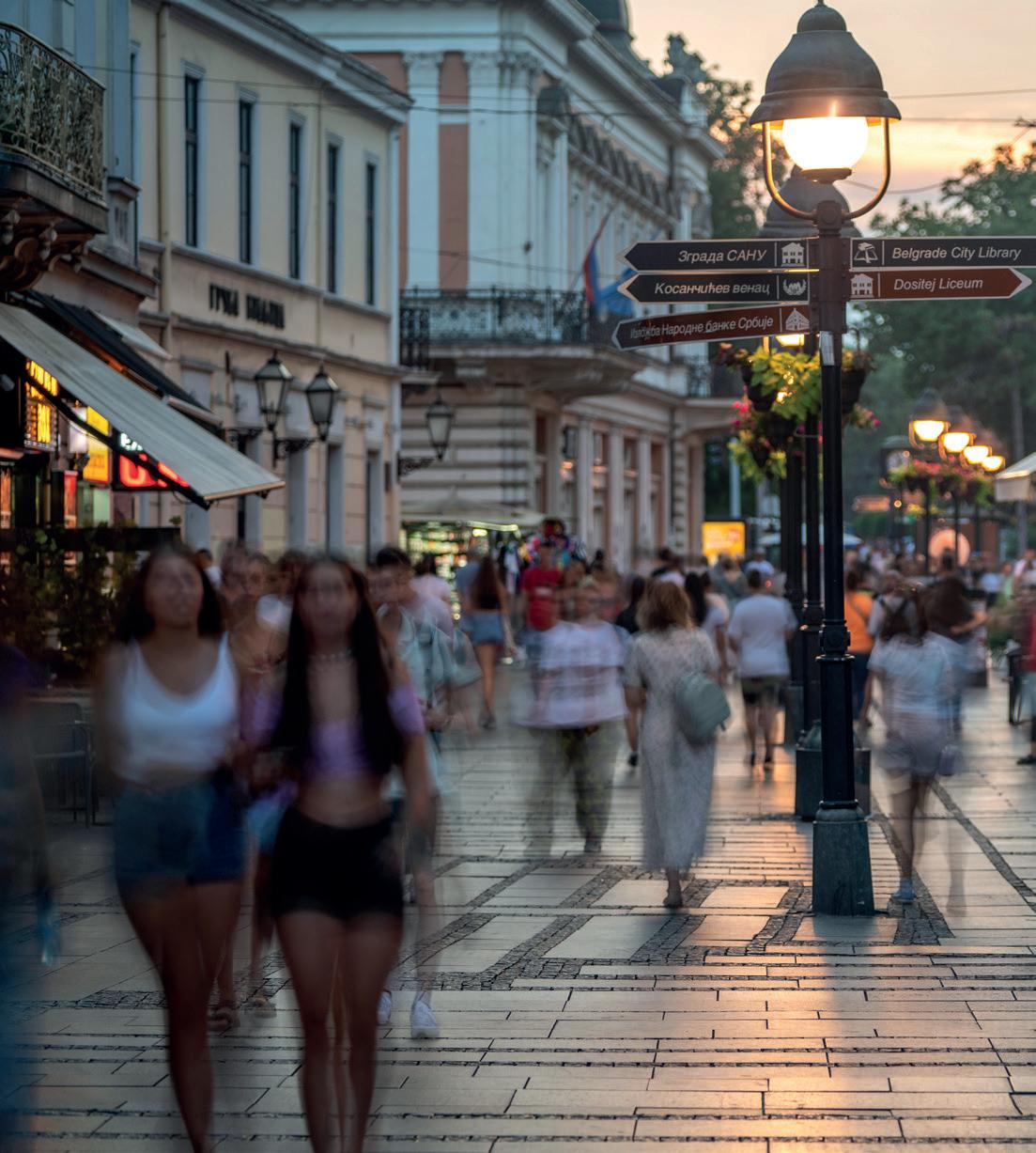
ALMA QUATTRO HAS MADE AN EXCEPTIONAL CONTRIBUTION TO THE DEVELOPMENT OF A NEW COMMUNICATION CHANNEL AND, AS A PIONEER, HAS CONSISTENTLY STAYED ONE STEP AHEAD OF THE REST
With the network of over 800 public transportation bus shelters that serve as a public asset to citizens of Belgrade and with more than 1,700 citylight panels we are delivering advertisers’ messages across the whole city. The bus shelter network


is produced, installed, and maintained by Alma Quattro at its own expense as part of a Public-Private Partnership with the City of Belgrade. With this arrangment, the city of Belgrade secures long-term budget savings, thanks to Alma Quattro’s
full financial and logistical support in maintaining this vital component of the public transport infrastructure. The portfolio of APG SGA and Alma Quattro includes a vast array of media types, such as classic billboards, illuminated billboards, LED and
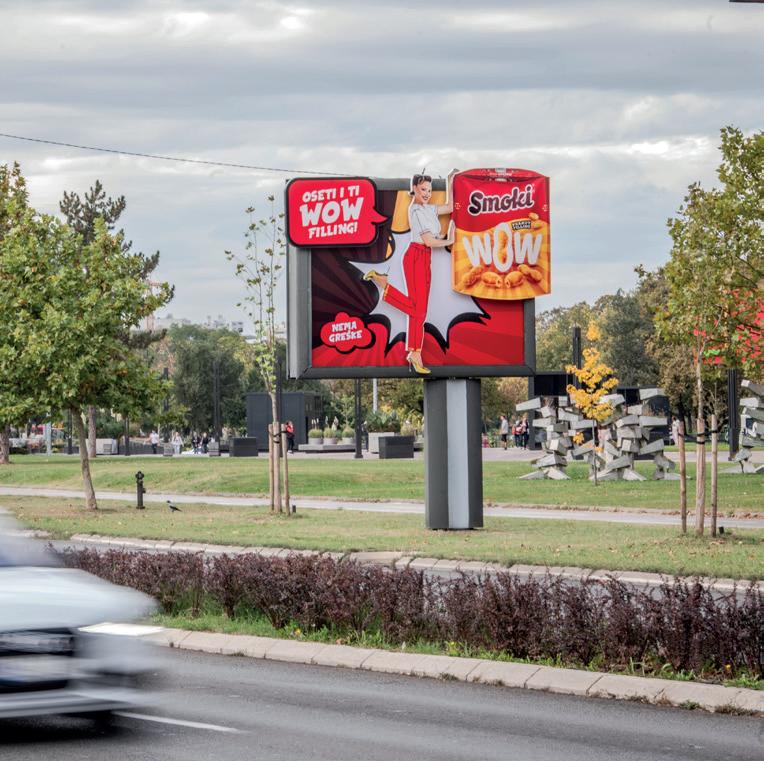

LCD screens, city light panels, as well as large formats like bigboards. All of these advertising media are available to advertisers and are positioned along key traffic routes across the city including pedestrian zones, forming an extensive and
well-distributed network. With over 70,000 square metres of advertising surfaces covered by Alma Quattro in Serbia, we represent an immense media resource and a powerful platform tailored to both small and large advertisers.

A System Built on Corruption and Incompetence Must Fall—Generation Z Won’t Bow, and the Fourth Republic Will Rise!
If we express this in French terms— where they are now in the Fifth Republic—we could say that the People's Republic of Serbia (NR Serbia) / the Socialist Republic of Serbia (SR Serbia) was the First Republic, the one after the introduction of multiparty politics was the Second Republic and the one after the 5th of October was the Third Republic. We need the Fourth Republic because the Third Republic has exhausted its potential.
The essence of these protests eludes analysts outside the country because this is the first such protest in Europe—Generation Z’s protest. It might be the second in the world, as similar student protests were recently recorded in Bangladesh. This is NOT a colour revolution because two things characterise those:
A desire to replace those in power— where the opposition takes power and those in power are pushed into opposition. That is not the case here,
REVOLUTIONS ARE NOT ABOUT CHANGING RULERS BUT ABOUT DISMANTLING THE ROTTEN SYSTEMS THAT KEEP THE CORRUPT IN POWER

as students do not seek a government change that merely replaces one ruling party with another previously removed in elections. Among them are leftists, right-wingers, centrists, atheists, believers—everyone.
A desire to change the country’s foreign policy direction—which is also absent here, as there are both pro-Europeans and pro-Russians, along with others. These matters are left to be resolved later. Even Dugin is missing the point. Everyone has a cognitive bias but cannot comprehend such young people.
This revolt is ANTI-SYSTEMIC. The system of the Third Republic, from 2000 to today, has fostered party-based cronyism, corruption, rule by the incompetent, and the extraction of ever-increasing “corruption rents” while institutions have withered away. The idea now is to reduce or eliminate these elements and establish a new system. Corruption exists even in Finland, but in Serbia (and many Eastern European countries alike) it has taken on
forms seen in African states. The rule of the incapable is endemic. And if anyone wonders why students would sacrifice a year of their studies, here’s the answer— what is the point of earning an electrical engineering degree if someone like Grčić can become the director of EPS?
It is, therefore, entirely irrelevant which party dominates the parliament or who the president is as long as the system functions. If the system works, there will be no mad scramble for power because it would no longer enable rule by the worst, criminal impunity, or enrichment through corruption. The current president could even stay in office if he adheres to constitutional boundaries. A crown prince could be appointed as
WHEN A GENERATION REFUSES TO BOW, THE OLD ORDER TREMBLES— BECAUSE THE FUTURE NO LONGER BELONGS TO THEM
a unifying figure, a monarchy could be declared, or the republic could remain—it doesn’t matter. There is no real difference between the republics of Iceland and Finland on the one hand and the monarchies of Sweden, Norway, and Denmark on the other—they all function because their systems work the same way.
Many have accused Generation Z of being spoiled, of believing everything “belongs” to them. But that very characteristic will be the one that saves us. They don’t perceive barriers between what they have and what they want so that they will fight for it. They simply feel it belongs to them—the country in which they were born should provide them with a chance for everyday life, a dignified job, the ability to buy a home, and a society where the capable succeed while criminals are prosecuted. Right now, the opposite is true. They feel that this country belongs to them and refuse to move. It’s not a case of “we will leave because you are evil” but rather “you will leave because you are evil.” I regret that our generations— X and Y—bowed their heads.
Of course, the West has remained silent on this because they only find it interesting when a real colour revolution is on the horizon—in Georgia or Slovakia, where protesters want to turn away from Russia, likewise the Russian media are interested in the protests in Romania, where protesters want to turn towards Russia. Here, no one knows the country’s foreign policy orientation if the demonstrators
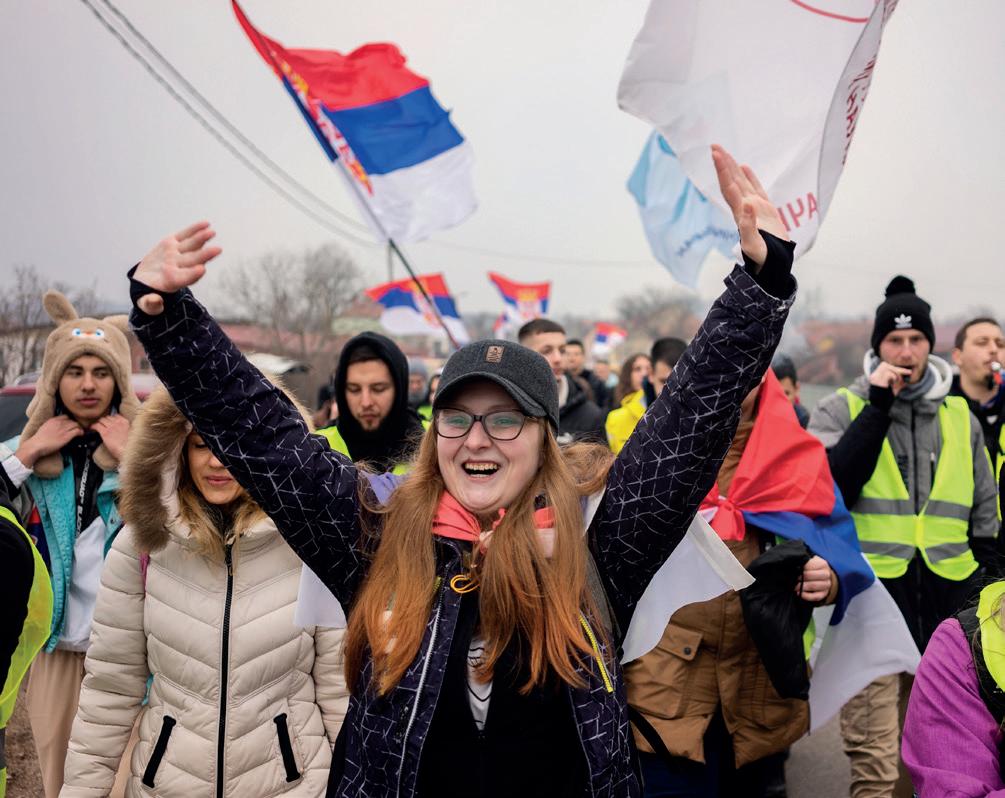
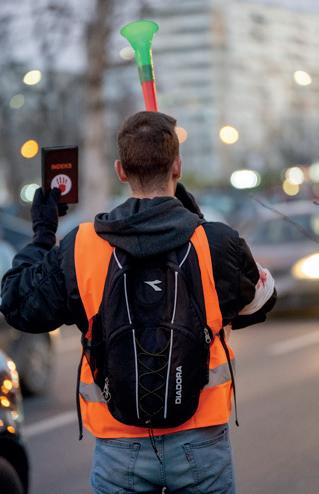


got what they wanted. And that is why they remain silent. The people of Serbia—above all, its students—have been left to fight alone. This is the first deeply anti-colonial uprising in this part of the world.
Twice before, we sabotaged ourselves when we had the chance for a “better life”: in 1990, when we elected all the parties of war and nationalism, losing 10 years, and in 2000, when we allowed looting privatisations and corruption to shape the next 25 years. This is the third chance—to build a new system, not just a new government within the old one. That would be meaningless.
Thus—THE FOURTH REPUBLIC.

We spoke with four students from the Faculty of Philosophy at the University of Novi Sad — Boris Kojčinović, Luka Opruc, and Natalija Petrović, all studying communication, and Kristina Tenjović, a psychology student. This combined interview was conducted in the context of the student protests organised by the Students in Blockade initiative.
The protests began in November 2024, following a physical attack on students from the Faculty of Dramatic Arts in Belgrade who were peacefully commemorating the victims of a fatal collapse of a canopy at the Novi Sad railway station. The tragedy, which occurred as a result of years of systemic corruption and institutional negligence, prompted students across Serbia to raise their voices.
THIS GENERATION DECIDED TO CHANGE THE SYSTEM INSTEAD OF RUNNING FROM IT –LUKA
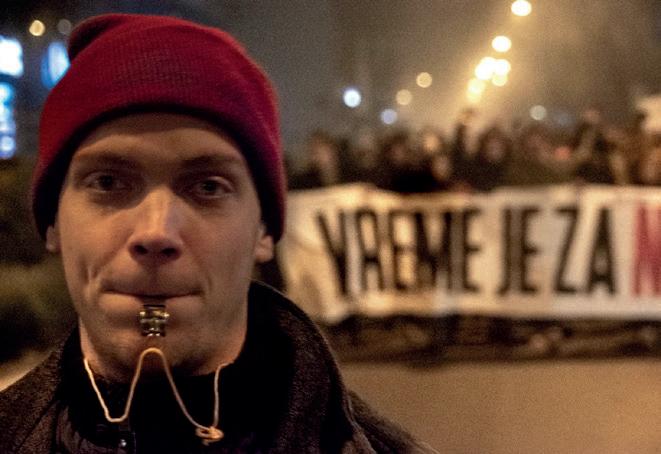
The students’ original demands include the publication of full documentation related to the reconstruction of the Novi Sad railway station, as the currently available materials are incomplete and inaccessible to the public; identification and prosecution of those suspected of physically attacking students and professors, along with the dismissal of those involved if they hold public office; the dropping of criminal charges against students arrested or detained during the protests, as well as the suspension of ongoing proceedings; and a 20% increase in budget allocations for public universities.
From the outset, the protests have been peaceful and nonviolent, consistently calling for a fundamental shift in societal values and encouraging citizens to engage in the defence of the common good actively. All
decisions within the movement are made through plenums, representing a form of direct democracy. So far, the authorities have failed to offer an adequate response, increasingly resorting to violence instead. None of the students’ demands have been met to date.
All interviewees emphasised that the views expressed are their own and do not represent the official position of the Students in Blockade initiative.
Serbia has witnessed numerous protests over the years, including Serbia Against Violence and Stop Rio Tinto, among others. However, students have remained mainly reserved during these movements, participating as individuals rather than as a coordinated force. This absence of organised student engagement led to a certain sense of apathy among older citizens, who believed that students were the very segment of society whose future people were fighting for in the streets — and that without them, change would be impossible. Were they right? And is the current student protest a clear sign that students have now resolved to fight for their future in their own country?
LUKA This generation had the bold idea to try to change a system that doesn’t work — instead of just running from it. The reality is that the current system doesn’t meet the needs of modern life.
You’ll often hear older people say, “Leave it, you’re too young to understand it,” but from our perspective now, that attitude bears a striking resemblance to how they interact with the political elite — as if politics is a mysterious, complicated business reserved for men in suits. The student movement makes it loud and clear that our generation is ready to fully step into political and social life — and change is already happening.
Previous large-scale protests in Serbia didn’t manage to channel public energy into real outcomes. There are loads of reasons for that, but let’s start with the obvious — the generations have shifted. Today’s students are the kids of those who protested in the 90s. We’re lucky: we didn’t grow up in war, we weren’t fed the same nationalist propaganda, and we didn’t live through the post-2000 crash of hope. Many of us are
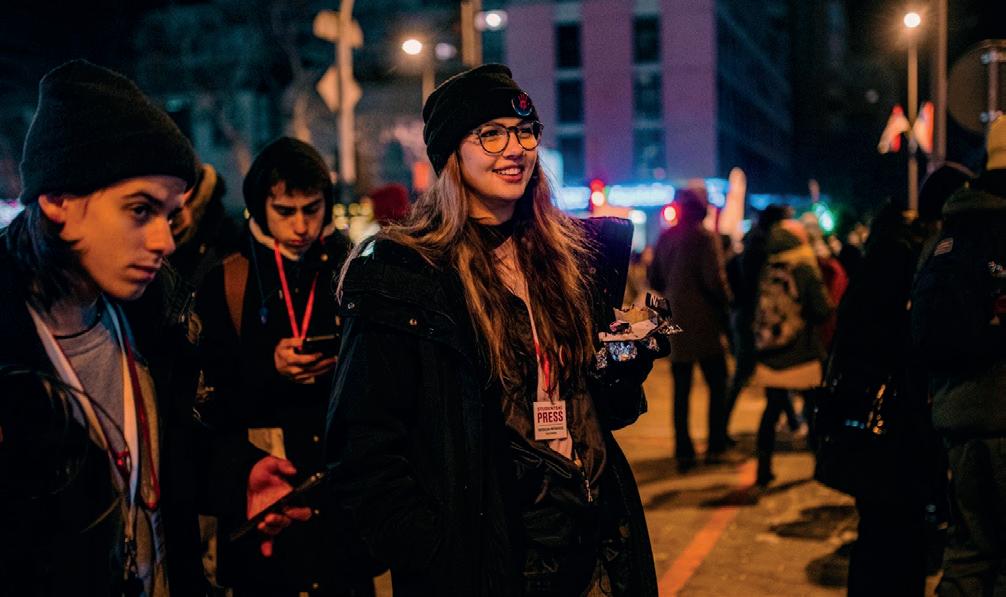
WE’RE NOT SURPRISED BY THE VIOLENCE.
WE GREW UP IN IT – NATALIJA
pretty immune to the usual tactics that divide society.
Back then, students mostly showed up as individuals because political dialogue wasn’t really something you did collectively. On top of that, this government has worked hard to shut down any civic or political engagement — centralising power, gutting local communities, turning institutions into cash machines, stuffing key roles with party loyalists, shutting down public debate, and actively sabotaging unions and any serious opposition.
So now, students are selforganising — and calling on everyone else to do the same in their own spaces. Ironically, one of the reasons these protests have become so massive and visible is exactly what older generations mock us for: phones, the internet, and the sheer speed and spread of information.
Real change takes time. But we’re done, just hoping. It’s time for fewer expectations — and more action.
The tragedy in Novi Sad was the trigger. Still, the protests truly gained momentum after the attack on peacefully gathered students from the Belgrade Faculty of Dramatic Arts, who were paying tribute to the victims from Novi Sad. How did these events shape your demands?
BORIS The tragedy in Novi Sad was just the spark — the real explosion happened in our heads. For decades, this society has been hit by one crisis after another. And every single time, somehow, the government managed to blame anyone but themselves. That kind of spin, pushed through their tabloid mouthpieces, shaped public opinion for years. There is no proper regulation, no accountability — just chaos dressed up as news.
When our friends and their professors from FDU stepped out to honour the victims, someone thought it was OK to attack them. At that moment, something clicked. The alarm went off for all of us. This wasn’t just about one event — it was a line that had been crossed. It became clear: freedom of expression, unless it fits the regime, no longer exists.
For every tragedy — the school shooting, the playground massacre, the helicopter crash — they found a scapegoat. But this time, when a chunk of concrete fell and killed people at a train station, there was no easy target. Just decades of corruption and zero responsibility.
People aren’t blind anymore. No one’s buying the excuses. They tried to shift the blame again, but this time, it didn’t stick — because they’d have to look in the mirror, and they’re not ready for that.
Everything that has happened has shaped our demands. It forced
us to look deeper. The real problem isn’t just bad decisions — it’s the system itself. That’s why we’re not asking for band-aids. We’re demanding a legal system that works, institutions that function effectively, and a society where the law is respected and enforced. Because without that, democracy is just a word on paper.
Were you surprised by the authorities’ response — answering peaceful protests with open, terrifying violence? What do you think pushed them to the point of losing all sense of proportion?
NATALIJA We weren’t surprised, honestly. That kind of violence is something people here, sadly, have come to expect. What shocked others just confirmed what we already knew — that they’ll go to extreme lengths the moment someone stands up to them.
What’s thrown them off is the fact that we, as students, carry a set of values they can’t understand. We’re everything they’re not — and that terrifies them. They’re scared of losing power, losing their seats, and, with that, losing their grip on the system that lets them keep stealing from the people.
The authorities attempted everything to discredit the protests, but each effort backfired. What’s the secret behind your “chess game” with the government — or, more precisely, with the President?
BORIS The secret’s so obvious, it’s wild it was ever a secret at all. We realised that every previous
protest was aimed at the wrong target. People kept appealing to an institution with mostly ceremonial powers — and by doing that, they unintentionally gave it more influence than it should ever have had.
We’re addressing the responsible institutions — the ones that are legally obliged to respond. This is supposed to be a representative democracy, and the will of the people shouldn’t be so out of sync with the will of the parliament. That gap creates corruption and injustice, ultimately tearing society apart, which is exactly why the judiciary is at the heart of our demands.
They’ve thrown everything at us to try and tear us down — but we’re not easy targets. We’re young, we stand for the right things, and we’ve grown up online. We’ve seen how the world works, and we know how to push back — fast, smart, and with a sense of humour they’ll never understand.
Why is He irrelevant when it comes to fulfilling your demands? Everyone knows He’s officially not responsible — but we also know He pulls all the strings far beyond what the Constitution allows. Can you strip Him of power simply by declaring Him irrelevant and refusing to engage with Him? LUKA He is irrelevant when it comes to meeting our demands — because, legally, none of it falls under His responsibilities. But here’s the paradox: in the past weeks, we’ve been watching the president insert Himself into the work of every institution simply because they’ve become so dysfunctional. And at the same time, He consistently avoids doing the one thing that is His actual job — representing the unity of the citizens of Serbia. He’s doing the opposite: dividing people and even fuelling violence.
Lately, the rhetoric emanating from what is supposed to be the country’s most ceremonial role has spiralled out of control. It now sounds more like a street-level party operative than a head of state.
So here we are — in a country where not a single branch of government is functioning. A president overstepping, a government in resignation, a judiciary paralysed by strikes from lawyers and court staff demanding fair pay, and a National Assembly that feels less like a legislative
chamber and more like a mashup of football brawls and gender reveal parties.
We’ve stepped into political territory here, so the obvious question is — how do you think your demands can be met if you insist on keeping politics out of it? Your needs are, by nature, political. And while you’re not
clear before — and it’s even more apparent now — that the government has completely taken over institutions that, by law, are supposed to be independent from one another.
As a result, the judiciary — which should be fully autonomous and treat everyone equally — has become just another tool in the hands of those in power. What
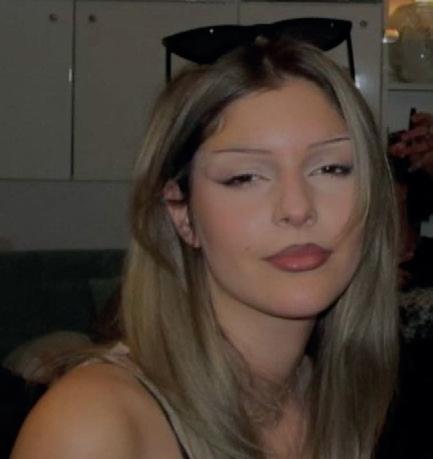
explicitly calling for a change of government (even though the government keeps claiming you’re), isn’t that shift essentially necessary if anything in the system is going to change?
NATALIJA We’re fully aware that what we’re doing is political — but from the start, we’ve drawn a clear line between politics and party politics. We’ve distanced ourselves from all political parties, and we’re not running from the fact that this is a political struggle.
One of the demands from Novi Sad is the resignation of Prime Minister Miloš Vučević and the Mayor of Novi Sad, Milan Đurić — along with their criminal accountability. If the Prime Minister resigns, that automatically brings down the government. So yes, that’s a form of change.
But what we’re asking for is that the institutions — which have been wholly hijacked — finally wake up and start doing their jobs because inside all those institutions sit real people who are actively choosing not to do what the law requires of them. And that has to stop.
The authorities won’t willingly give up power — doing so would mean sending themselves to prison. So, how do you think this situation can be resolved?
KRISTINA We, as Students in Blockade, are calling on the institutions to do their job. It was
My personal view on a government of experts differs slightly from that of some of my peers. I see it as a risky move, but if there’s strong student oversight, it could be a workable solution for resolving the crisis. Still, young people are highly cautious. We’ve been let down too many times to trust easily.
WE’RE NOT THE FUTURE — WE’RE THE NOW! – KRISTINA
we’re demanding is simple: equality before the law and an end to selective justice.
We’re seriously concerned that the government has embedded itself deep into the judicial system, and that’s why it’s crucial to break that grip. If the judiciary can’t be freed while this government is in power, then yes — the government needs to go, along with everyone who’s been doing its dirty work.
An independent judiciary isn’t optional. It’s the foundation of any real democracy.
What’s your position on the proposals to form a transitional government? Would you accept one made up of both government and opposition representatives — or only one composed of independent experts?
BORIS A transitional government is entirely off the table in the current political climate — I think that’s a firm no for the majority of students. People don’t trust those in power, but support for the opposition has also dropped significantly during the student movement. Some of that criticism might be unfair, but most of it is entirely justified — people no longer believe in them. They haven’t fought hard enough, they haven’t offered a real path forward, and let’s be honest — part of the opposition is too close to the regime, and that ruins their credibility in this fight.
That’s why our focus right now is on direct democracy — the kind we practise through plenums and the kind we hope citizens will build through local assemblies. It’s a long road, for sure, but it allows every voice to be heard. And perhaps, just perhaps, that’s how we begin rebuilding trust in institutions.
Are you ready — as what is now clearly a serious political force, possibly the only one that can genuinely challenge the current regime — to actively step into politics and potentially participate in a technical or transitional government composed of experts?
NATALIJA Students in Blockade aren’t aiming to become political players in the traditional sense, nor do we plan to take part in institutions or government structures actively. We see ourselves as a driving force — a catalyst — in this society. Our demands are clear and concrete, but we’re calling on every other part of society to wake up, to start demanding real change, and to be ready to make sacrifices. The social and political system has to come to an end — and that won’t happen unless everyone gets involved.
How do you view the role of the opposition, and are you willing to accept their outstretched hand and include them in achieving your goals?
KRISTINA The relationship between students and the opposition is... complicated. Currently, the opposition’s standing is relatively weak. None of the parties have proven themselves as reliable or trustworthy during their time in office. On top of that, the regime-controlled media have done a grand job spinning narratives and applying pressure, which only deepened the public’s distrust.
The student movement has, from its inception, sought to remain independent and outside of traditional politics. But as the movement grew, many people started to see students — with their clear messages and actions
— as a genuine political alternative. And that shift only further pushed the opposition into the background.
Right now, students aren’t interested in forming or joining political parties, even though ideas like that have come up. It just doesn’t align with what this movement stands for.
The tricky part is that everyone knows this situation can only be resolved in the political arena. However, collaborating with the current opposition is not an option — it wouldn’t benefit the movement and could easily harm it.
Could that change in the future, with new people and new ideas? Maybe. Nothing’s off the table in times of major change. But for now, the answer is no.
What’s your view on how citizens have responded to the protests? Why have these walks across Serbia — through nearly every town and village — been so powerful, eye-opening, and even cathartic? It feels like you’ve managed to awaken the so-called “ordinary person,” the one who is the backbone of this society but lives far beyond the inner circle of political elites and major university hubs.
KRISTINA What this movement has given people is something they’d lost a long time ago — hope. That hope was crushed by the failures of past struggles and worn down by the constant pressure of life under this regime. Trust in the system collapsed when the promise of a “better tomorrow” in the 2000s turned into a playground for manipulation, abuse of power, and personal gain. What followed was a kind of collective disconnection — people felt powerless and drained after decades of fighting, constantly being told what to think and what to believe.
But the messages coming from this generation — messages of justice, dignity, and unity — were always there, buried deep in people. They just needed someone to say them out loud. People forget that institutions are supposed to serve us and that power should belong to the people, not rule over them. Solidarity, unity, democracy — these are the values most citizens of Serbia want. But no political option so far has even tried to bring that closer to them.
What’s also hit home is the strength and ambition of young people. That has stirred something powerful — a kind of nostalgia and a renewed awareness

WE’RE DONE TREATING SYMPTOMS. THE PROBLEM IS THE SYSTEM - BORIS
of how critical social and political engagement is. Because when you realise your children, for all the right reasons, don’t want to live in the country you helped shape — you’re left with one choice: to support them. To stand beside them. The people didn’t need much — just a spark. A bit of motivation and courage. I think they found that in us. Trust isn’t something you can demand — it’s something you earn. And that’s where every political force before us failed. Perhaps that’s why people now view students as the light at the end of the tunnel.
How do you respond to the international community’s stance on the protests? Russia accuses you of staging a colour revolution, the West claims you’re pro-Russian, and the domestic government calls you foreign agents. Why is there such a lack of support from the so-called democratic world?
Luka The word that best describes the EU’s attitude toward Serbia — and, honestly, the broader politics of the European Commission — is hypocrisy. And this case is no exception. But it’s not just about money and interests this time like
it usually is. What scares them is that students in Serbia have become a true political vanguard — speaking openly about transparency, accountability, and direct democracy.
Those values pose a serious threat to the so-called “democratic world,” which, let’s face it, is looking less and less democratic every day. The real danger we pose is to systems built on hypocrisy, private interest, and profit at the expense of people — and we’ve seen enough to know that this is not just a local issue. It’s global.
Just like sovereignty in Serbia doesn’t belong to the government but to the people, the European Commission isn’t the sole voice or representative of European citizens. There are more of us — and they know it.
Do you personally see these protests as historically significant or even transformative? Do you believe they have the potential to spread regionally or globally, given the support you’re receiving from ordinary people around the world? People genuinely admire what you’re doing.
Boris Honestly, it’s hard for us to view these protests with any distance — we’re in the thick of it. We’re juggling so much on the ground that there’s barely time for big-picture analysis or reflection on long-term impact. What we do know is that this is something big, and we’re proud of it. How big, how historically significant — that’s something we’ll understand better once this fight is over when we can take a breath and look at what’s been achieved.
What we’re fighting for — as students and now alongside so many citizens — is essential to any democratic society. Whether this will spread regionally or globally is hard to predict. However, there’s no doubt that other countries could learn from it — it just depends on whether their citizens see it as urgent and relevant in their context. It matters to us that Europe and the rest of the world understand what we’re doing and why we’re doing it. But I think they’re afraid to look too closely at students in Serbia — because doing that would mean confronting the state of their societies. And let’s be real: things aren’t exactly blooming there either, no matter how much they want to believe otherwise.
The idea that ordinary people should have a say in how things work — that idea’s been pushed to the margins. We’re just trying to bring it back to the forefront.
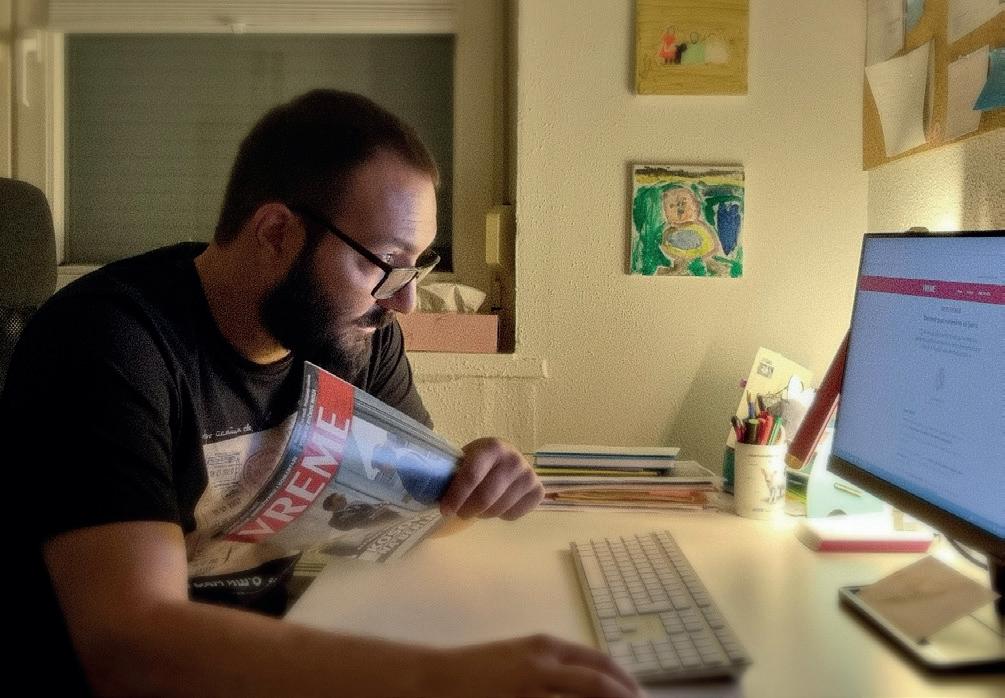
NEMANJA RUJEVIĆ
Journalist and editor of Međuvreme, the newsletter of the weekly magazine Vreme
Journalist Nemanja Rujević dissects the state of media freedom, political control, and social unrest in Serbia. In this interview, he speaks about the tightening grip on independent journalism, the growing impact of student protests, and the West’s ambiguous stance on Serbia’s democratic struggles. With sharp insights and unfiltered opinions, Rujević questions whether real change is possible or the country is stuck in a cycle of repression and stagnation.
How Do You Assess the Current State of Media (Un)Freedom in Serbia?
Censorship is hardly even necessary anymore. By now, everyone knows what they can and cannot say. The President of Serbia acts as the chief editor of media
outlets that control around 70 per cent of the market—indirectly, of course, through his media proxies, who have become enormously wealthy. Though, now and then, Vučić directly intervenes, even calling into TV programmes himself.
but they rarely lead to any real consequences.
How Will the Sale of United Group’s Business Segments Impact the Media Landscape?
The deal is great for those who orchestrated this billion-euro trans-
CENSORSHIP IS HARDLY EVEN NECESSARY ANYMORE. BY NOW, EVERYONE KNOWS WHAT THEY CAN AND CANNOT SAY
The remaining independent media have largely entrenched themselves in opposition, raising their defences against the regime’s attacks. However, this has also led to a certain complacency, where journalists hand the microphone to government critics who repeat the same things we have heard countless times. Of course, there are still excellent articles and investigative stories,
capable of delivering unfiltered criticism of those in power. What will remain is only carefully measured criticism on television, limited to whatever President Vučić deems acceptable.
That said, there are claims that N1 and Nova S will continue operating with the same editorial policy for years. Hopefully, that is true. A key indicator will be whether prominent journalists and editors start migrating to Telekom-owned television channels—where viewership is negligible. Still, salaries for top journalists rival those of airport directors.
What are the consequences of increased political control over the media for journalists in Serbia? Is it difficult to maintain professional integrity in such an environment?
Not at all—nothing is easier. You decide not to sell yourself. They’re not executing people for it yet. Surviving in the media afterward is tough, but no one has starved. Stress, on the other hand, is another story.
What bothers me more is that the audience either doesn’t recognise what’s happening or, even worse, sees it and doesn’t care. In a media landscape where advertising money is cut off, state funds are funnelled through Telekom to regime tabloids, and journalistic ethics are optional, only the public can sustain independent media that report honestly.
But few people do. Hardly anyone buys newspapers, subscribes, or donates to independent media. People have grown used to everything being “free”, but it cannot be. If the audience refuses to pay, they will be informed by hobbyists or someone’s paid mouthpieces, not in the public interest, but in the interest of their financiers.
What Is the Social Significance of the Current Student Protests? What is their central message, and how has the broader public received it?
action—they have never been too squeamish about working together when large sums of money are involved. But for the media landscape and the public, it is terrible news.
United Group invested in media outlets that criticised the government, providing a crucial counterbalance to the relentless propaganda of regime-controlled channels. If that disappears, Serbia will be left without major, financially strong media
Their significance is immeasurable. Someone said this isn’t a fight for freedom, but freedom has already arrived through the protest—above all, freedom from fear. As I mentioned, they’re not executing people yet. Young people have encouraged one another and emboldened entire cities, villages, professional groups, and even some unions.
Aside from its loyal enforcers who treat public tenders and job appointments as personal privileges, the regime is left with only the audience for Pink and Happy
TV—those worn down by decades of this system, fearful that any change will mean lost pensions or partycontrolled jobs.
The students’ message is simple—they want a functioning state. They don’t want to destroy it, as the regime and its cronies fantasise. On the contrary, they want the state to work as it should and can. It won’t become Norway overnight, but it can certainly be better.
This is where things get complicated. For students to get the state they are demanding—or as it is often put, “institutions”—the government must change. This regime is so deeply entrenched in corruption that it cannot allow functioning institutions to exist because that would mean doubling the capacity of Zabela prison and sending top officials to jail.
However, students do not explicitly call for a change in government, nor do they want to be associated with the opposition. This is understandable, given the opposition’s poor reputation after years of demonisation. But there is no alternative opposition. If students do not want to become one themselves, what do they want?
At some point, fatigue may lead student assemblies to declare their demands met, and they may return to their studies and exams. However, the demand for a proper state will not truly be fulfilled. This movement cannot go on indefinitely or repeat itself in endless cycles of protests without resolution. A possible outcome is pressure to form a transitional government and hold free elections. But for now, that idea is unappealing to the students.
Since it is unappealing to them, it is also unappealing to many citizens who say, “Lead the way, kids, you know best.” That may not be fair to the students, but they have become the only real political force standing against Vučić. And with that, they now bear the greatest responsibility.
How Do Western Countries View the Student Protests in Serbia?
People have been wrong all along when comparing Vučić’s era to Milošević’s, and they are even worse now. Milošević was largely “out of step” with the world, especially if we define the world as the West. Vučić, on the other hand, is entirely in sync with today’s global trends. Who is supposed to support change? Trump, Orbán, and Meloni? Or the Germans, too preoccupied with their troubles?
Beyond all other issues, the West and the European Union have long had a hypocritical approach
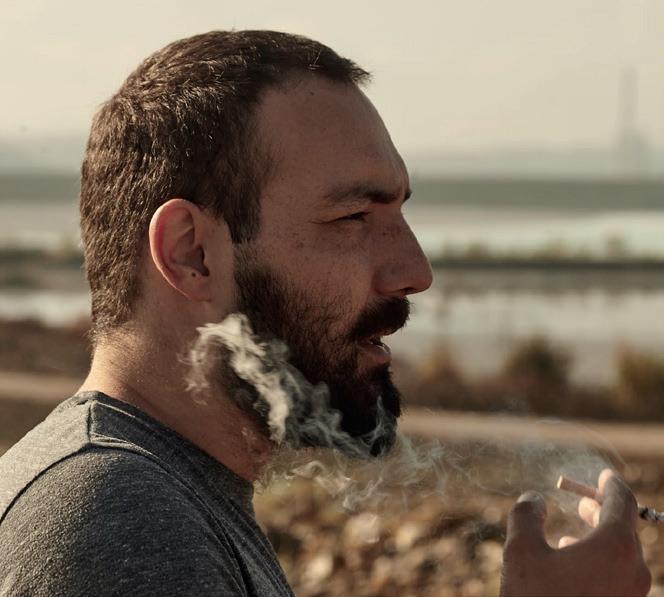
EITHER SOME UNEXPECTED EVENT WILL COLLAPSE THE REGIME LIKE A FLEA MARKET IN A DOWNPOUR, OR THIS PAINFUL STAGNATION WILL DRAG ON WITH AN UNPREDICTABLE OUTCOME
to what they promote as “Western values.” These values apply at home but not necessarily elsewhere. Now, they are also facing an identity crisis—unsure whether those values even matter to them anymore, let alone whether they are willing to export them.
Vučić understands this game perfectly and knows exactly how to win people over. The key is to stay
firmly in power, deliver just enough, and promise even more.
How Is the West, Especially Germany, Involved in Serbia’s Lithium Exploitation Plans?
It follows logically from the previous point. Germany’s auto industry is struggling, but it is the backbone of its economy. It has bet on lithium, and it needs it. Serbia has a world-class
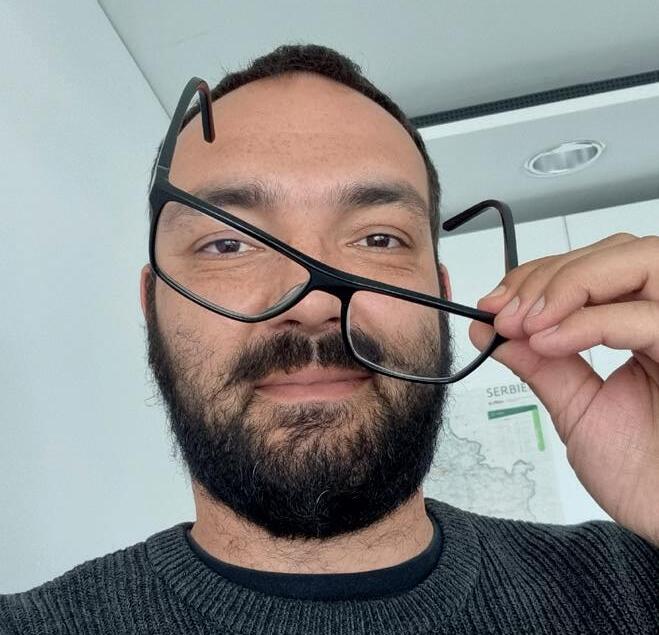
deposit, and it is unlikely that the German Chancellery will lose sleep over bats, farmland, rivers, or a farmer’s home in the Jadar Valley.
For a while, I thought Vučić saw this as his golden ticket in relations with Germany. Now, I’m not sure he will even dare to mention the project again anytime soon. Nor am I sure that Germany won’t find alternatives elsewhere. The resistance to mining in Serbia is too strong.
Can Western Pressure Improve Media Freedom and Student Rights in Serbia?
I am not among those who believe in the “the worse, the better” strategy, hoping that someone will “sanction the regime.” We’ve seen around the world—and experienced firsthand—that sanctions always hurt the people. Ideally, the European Union would align with its contractual relationship with Serbia. Officially, that is what the EU accession process is about.
Specific standards must be met— some are ultra-capitalist, but most are not meaningless, particularly those related to the rule of law. The real issue is that Serbia is the only EU candidate with a serious obstacle in Chapter 35, which requires it to recognise Kosovo’s independence in some form. And you can’t have it both ways—if you want a strongman who “delivers” on Kosovo and other matters, there will be no rule of law or other democratic standards.
Even neighbouring countries without the Kosovo issue have struggled with EU integration. I’ve long believed that the accession process has been dead since Croatia joined—it’s just that everyone is pretending otherwise.
What Does the Future Hold for Media Freedom and Political Protests in Serbia?
Things will likely have to get much worse before they get better. Either some unexpected event—a “black swan”—will cause the regime to collapse like a flea market in a downpour, or this painful stagnation will drag on, leading to who knows what kind of outcome. Vučić wouldn’t be rigging elections if he was willing to step down when the people demanded it.
Since even biology dictates that he must leave power one day, the real question is what the political and media landscape will look like when that happens. There will likely be a few years of confusion, shifting alliances, and a scramble for positions. But politics and the media will improve—so long as no one else accumulates the same power level as Vučić. That is what must be carefully watched.
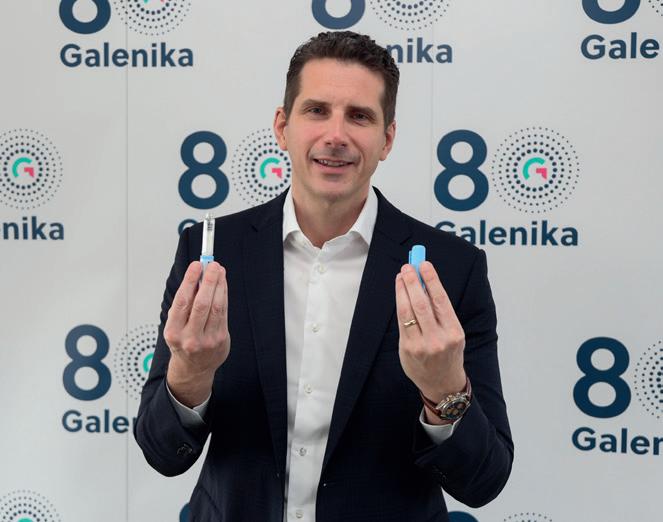
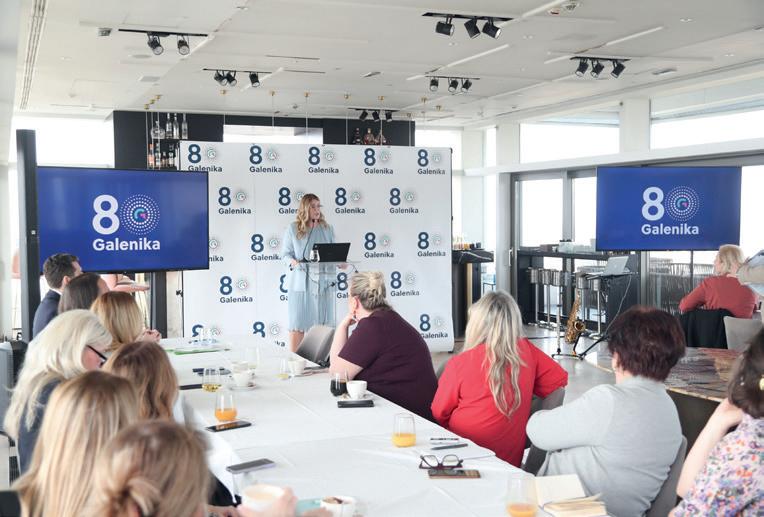
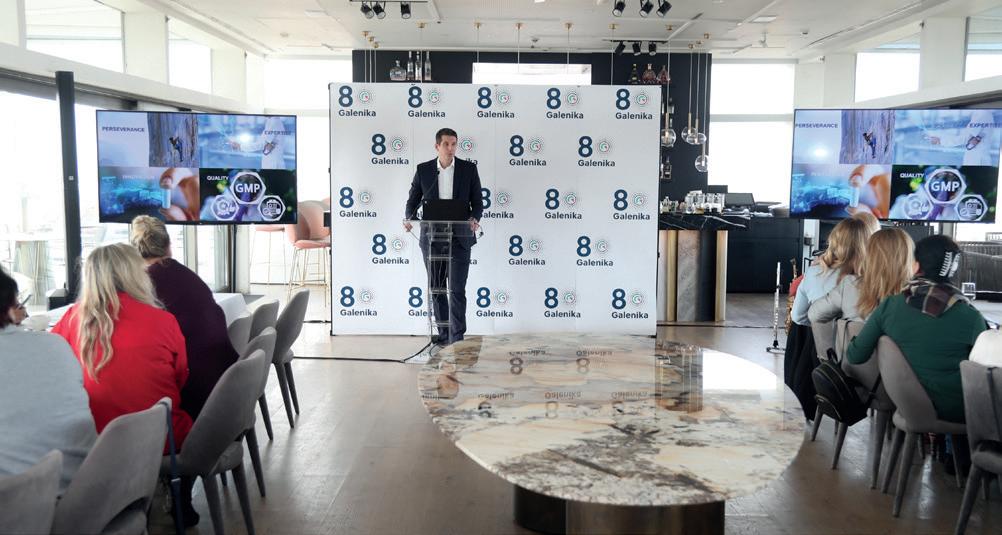
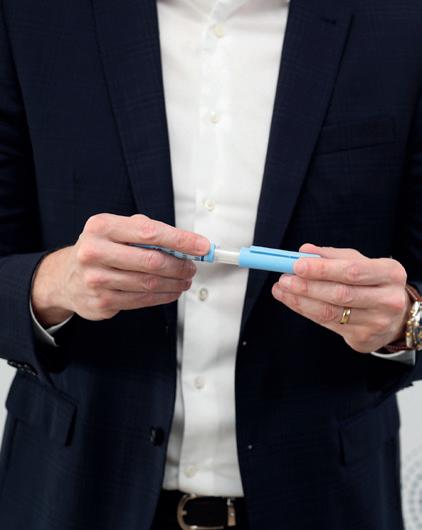
This year, Galenika marks 80 years of business. The pharmaceutical company, whose resilience is built on tradition, expertise, quality and innovation, has achieved rapid growth and development following its privatisation and subsequent investments. In the seven years since joining the Brazilian NC Group, Galenika has produced over 310 million product packs and increased its sales in Serbia by an impressive 84 per cent. Investments have been made in the construction of three new factories, as well as in the modernisation and expansion of existing facilities. The product portfolio has been significantly expanded, and through a strategic partnership with its sister company in Brazil, EMS, Galenika has successfully completed the technology transfer for 13 next-generation generic medicines.
In its 80th anniversary year, Galenika is preparing for a major market innovation in the form of a peptide platform developed in
collaboration with EMS in Brazil. The first peptide-based medicines for treating obesity and diabetes have already been registered in Brazil, with sales expected to commence within two months. The same products are expected to be registered this year in Serbia, the European Union, and the United States.
“The company’s 80th anniversary is marked by expansion – both in terms of our product portfolio and the continued internationalisation of our operations, as well as ongoing innovation. Our peptide platform is an excellent example and represents a true breakthrough, both for us here and for our company in Brazil. Being at the forefront of the pharmaceutical industry in the entire region, as a symbol of health, quality and trust, is a major achievement for the company. We have the expertise and a clear vision for the future, and our goal is to lead the further development of the pharmaceutical industry. Innovation and responsibility inspire us and strengthen our resolve to
continue delivering outstanding results,” said Ricardo Vian Marques, General Manager of Galenika.
Over the past 80 years, Galenika has received as many as 103 national and international awards in the fields of research and development and continues to grow steadily, with quality serving as the foundation of trust in its brand and products. The company has expanded its operations to 30 international markets across four continents. Among its most recent achievements is a partnership with a company building the first domestic pharmaceutical factory in Azerbaijan, which recognised Galenika as a partner with outstanding expertise. The partnership includes the transfer of Galenika’s product technologies as well as knowledge sharing. In addition, Galenika has launched its first business activities in Latin America and is planning dynamic growth in new markets across the EU and the MENA region.
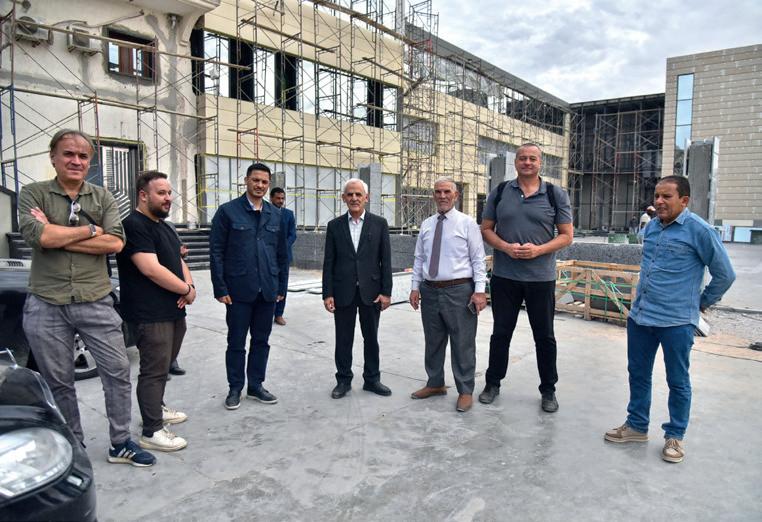
During the special visit of Diplomacy&Commerce magazine to Libya, our delegation visited the impressive port of Misrata and the corresponding Free Zone, which is said to be the future largescale entrance and exit point of all goods to and from Libya and the invaluable connection between Europe and Africa, as it has always been in this part of the Mediterranean
The Misrata Free Zone is considered to be one of the most important economic resources

for its active role in the trade exchange movements between countries for its exemption from all tax restrictions to encourage investment establishments that lead to a good economic return to all parties and contribute for the establishment of a giant economy and facilitate the movement of the global trade in the advanced investment environment; free zones are designated and organised by law to host industrial, commercial and service operations that are advertised to all who wish to

The delegation from the Diplomacy&Commerce magazine, during its visit to Libya, visited one of the food giants, the Al-Naseem factory in Misrata Al-Naseem is primarily a dairy factory, but it has expanded its core products to include a wide range of food and drink items. It all started when Mohamed Raied founded a Company in 1994 that specialises in food and beverage manufacturing and distribution. He called it Al-Naseem, and it was a time when large-scale private incentives were not allowed. It began as a simple ice cream factory with a small group of passionate people; it has
invest. To benefit from the superb location of Libya, particularly in Misrata, the city is beginning to attract foreign capital and investors. The Misrata Free Zone was introduced as the first free zone in Libya, covering a total area of approximately 3,500 hectares, which includes the seaport. It boasts numerous features and has the potential for future expansion of up to 20,000 hectares. The stacked containers and cargo ships send a powerful and hopeful message for the future.
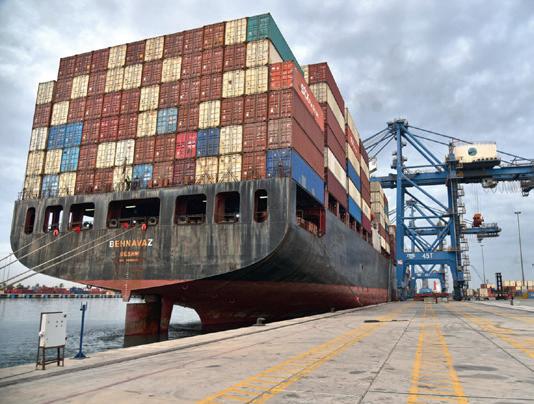

since grown significantly over the years. We spoke with Mr. Raied and tasted the excellent ice cream, which is shipped all the way from New Zealand, and observed the top-notch automated production facilities. Al-Naseem ice creams, yoghurts and drinks like laban are very popular in the whole of North Africa, making Al-Naseem a powerful player in this region of the world.
Na kraj druge strane stavi traku ovako nekako da izgleda: Levo preko trake stavi naslovnicu InFocus Libya, a desno preko trake stavi QR kod koji ćeš naći na serveru u direktorijumu.
The special InFocus Libya edition was published in November 2024 in cooperation with the Embassy of Libya in Serbia. All articles are available in our online edition at: diplomacyandcommerce.rs

Serbia lags behind while corruption spreads, inflation soars, and the workforce flees
MIŠA BRKIĆ Economic Journalist
Miša Brkić, a renowned economic journalist, sharply analyses Serbia’s current economic and business landscape. From entrenched corruption and inflationary pressure to the challenges of EU integration and workforce emigration, he dissects the key factors shaping the country’s stagnation. In this interview, Brkić explains why Serbia struggles to move forward, how political decisions impact the economy, and what it would take to break free from the cycle of inefficiency and missed opportunities.
Student protests have been ongoing for over three months and have been characterised as anti-corruption demonstrations. How deeply has corruption taken hold of Serbian society? Corruption is an endemic disease in Serbian society. In other words, it is nothing new. However, it has exploded over the past 12 years, becoming a mandatory systemic “stylistic device.” The moment the Serbian Progressive Party took complete control of the state and all local governments, a Pandora’s box of systemic corruption was opened. The government was left without external oversight from independent regulatory and control institutions, whose role it deliberately minimised and ultimately destroyed.
In previous years, corruption was primarily encountered in healthcare, the police, and local government offices. However, it has since metastasised throughout the entire system, becoming its key component. The recent wave of arrests we have witnessed in recent days illustrates just how deeply corruption has spread, branching out and ultimately devastating both the state and society.
When we look at the level of corruption created by the Serbian Progressive Party today, it may seem that any fight against it is futile. But it is not.

EVERY MONTH OF DELAY IN EUROPEAN INTEGRATION FEELS LIKE A YEAR OF LOST PROGRESS
Although Serbia ranks high among the world’s most corrupt countries and the battle appears impossible, there are still methods, measures, and mechanisms to curb it.
The first and most important step is to reduce the size of the state and limit its power by cutting down the regulations it imposes on markets. A minimalist state, focusing on just four or five key areas (such as border security, foreign policy, judiciary, and citizen protection), is the first guarantee of reducing corruption. Next, the number of laws and regulations granting excessive authority to the state must be drastically reduced, as
such a system naturally breeds corruption.
Beyond this, classic operational methods for combating corruption must be applied. Chief among them are strict laws, intensified and expanded criminal prosecution, and the enforcement of severe sanctions. However, this alone is not enough. Additionally, more sophisticated instruments are required.
One such tool is a systematic examination of hundreds of administrative procedures to eliminate any opportunities for corruption in state operations. Another is public education and mobilising public opinion to support law enforcement. In other
words, enforcement, prevention, and education must be implemented simultaneously and in coordination.
A government genuinely committed to fighting corruption must establish an independent commission responsible for overseeing and implementing these three elements. This commission should include an investigative unit composed of professionals—accountants, economists, and legal experts—trained to identify regulation loopholes and detect potential corruption risks.
Will Happen to NIS After US Sanctions? Could There Be an Energy Crisis?
We have already seen signs of disruption, such as Wizz Air—a company backed by American capital—briefly halting fuel refuelling at Belgrade Airport because NIS is its sole supplier.
As of today (24 February), there are still no clear indications of how the Serbian-RussianAmerican oil dispute will unfold. The key issue revolves around the Russian company Gazprom’s stake in NIS. If the US insists on sanctions and Russia refuses to relinquish its ownership share, the only possible outcome would be NIS’s bankruptcy due to an inability to continue operations.
The consequences of bankruptcy are well known—for owners, creditors, business partners, competitors, and consumers alike. However, what truly matters is that the market continues to function and that consumers—whether car, truck, bus, or aircraft owners—have a steady fuel supply. If one supplier, in this case, NIS, is removed from the equation, other players will step in to fill the gap.
Have We Really Tamed Inflation? Serbia’s Prices Are Unreal.
Serbia’s inflation may seem to be under control, but prices remain astonishingly high. Serbia is more expensive than many wealthier and more developed European countries. Why is that?
Let’s clarify one thing right away: The Serbian government
ignited inflation during the COVID-19 pandemic. For three years, it poured so-called helicopter money into the economy, supposedly to help citizens and businesses weather the crisis. By its own admission, the government spent €9 billion this way. But economics is not a religion—this money, which was not backed by goods or services, eventually led to soaring inflation.
Many players influence prices: producers, distributors, retailers, and the state itself. Take fuel, for example: petrol prices in Serbia are among the highest in Europe because the government imposes hefty excise duties, which it channels into the budget to cover its own expenses. Serbia’s state apparatus is large, sluggish, expensive, and inefficient, driving production costs.
Another factor is the inefficiency of local producers, whose productivity and competitiveness are far below European standards. Retailers also play a role, taking advantage of weak competition to maximise profits. While foreign retail chains are currently under attack, it is worth remembering that they did not come to Serbia to act as charities but to generate profit. The government is responsible for setting fair rules and ensuring market competition.
Why doesn’t it do so? Simply put—because it is incapable.
How do you explain Germany’s industrial crisis? Could it affect Serbia’s economy, considering Germany is our largest foreign trade partner?
Many quickly blamed the disruption of Russian energy supplies as the primary cause of Germany’s industrial downturn. However, I see two far more significant reasons.
The first and most crucial is the lack of innovation. Germany’s industry has rested on its laurels for years—much like the entire European industrial sector. Innovation has been stagnant, and many of the most promising startups originating in Germany and Europe have relocated to the US for better business conditions. Germany’s rigid business environment and costly welfare state have become a heavy burden for industrialists.
The second reason is the flawed strategy of Germany’s political leadership (and the EU) in hastily setting deadlines for phasing out fossil fuels and
forcibly introducing electric mobility in the automotive industry. Industrialists lacked the capital to meet this political directive, and even when they produced electric vehicles, consumer enthusiasm remained lukewarm.
The impact of Germany’s industrial crisis on Serbia’s economy is only just beginning to be felt. I have the impression that our politicians are either unaware of the looming consequences or are deliberately burying their heads in the sand, refusing to acknowledge the economic tsunami approaching from our most important trade partner.
Is this agreement a form of neocolonialism? Are we on the path to becoming a German colony—if we aren’t one already? I don’t subscribe to that kind of neo-colonial hysteria. Serbia cannot function as an isolated country on this planet. We are part of what former communists used to call the “international division of labour.” Our problem is that we participate in this system not with our intellect, knowledge, or skills, but with our natural resources.
In that sense, we are similar to Russia. They rely on oil and gas,
while we have rare metals that we should utilise and integrate into the global economy. This isn’t colonialism—it’s globalisation, a process that, for example, China has benefited immensely from over the past 30 to 40 years.
Serbia is not a colony but on the periphery of global industrial and technological revolutions. Perhaps that is because we are too fixated on the past.
How Far Behind Is Serbia on Its European Path, and What Does That Mean for Our Economy?
Serbia is significantly lagging behind. It feels as though every month of delay is equivalent to a year of lost progress. We are witnessing a strange phenomenon in which the government’s rhetoric is full of commitments to European integration, while its actions are rooted in anti-European values and behaviour. This contradiction is understandable because true European values directly challenge the current regime.
The prolonged stalling of European integration is causing enormous harm to both the economy and the citizens. Any objective analysis will show the
CORRUPTION HAS METASTASISED THROUGHOUT THE ENTIRE SYSTEM, BECOMING ITS KEY COMPONENT
immense benefits that businesses, entrepreneurs, and citizens of Bulgaria, Romania, Poland, Croatia, and Slovenia have gained from joining the EU—and how this accession has driven economic growth and prosperity.
How Can Serbia Develop Its Economy Amidst Workforce Emigration?
A growing number of skilled professionals—doctors, craftsmen, scientists, and drivers—are leaving Serbia. How can we stop this trend, and given our current economic situation, is it possible to fill the gaps with workers from third-world countries?
The answer lies in integrating Serbia’s labour market into the global division of labour. Poland and Romania did not collapse when they joined the European Union and saw their workforce move en masse to the UK and Italy. This is precisely why Serbia’s EU accession is crucial. A fully open labour market would give Serbia the opportunity to organise itself as a wellstructured society that could attract workers from other EU member states.
Many economically developed countries have demonstrated that compensating for workforce shortages by importing labour from third-world countries can ensure economic growth and market stability.

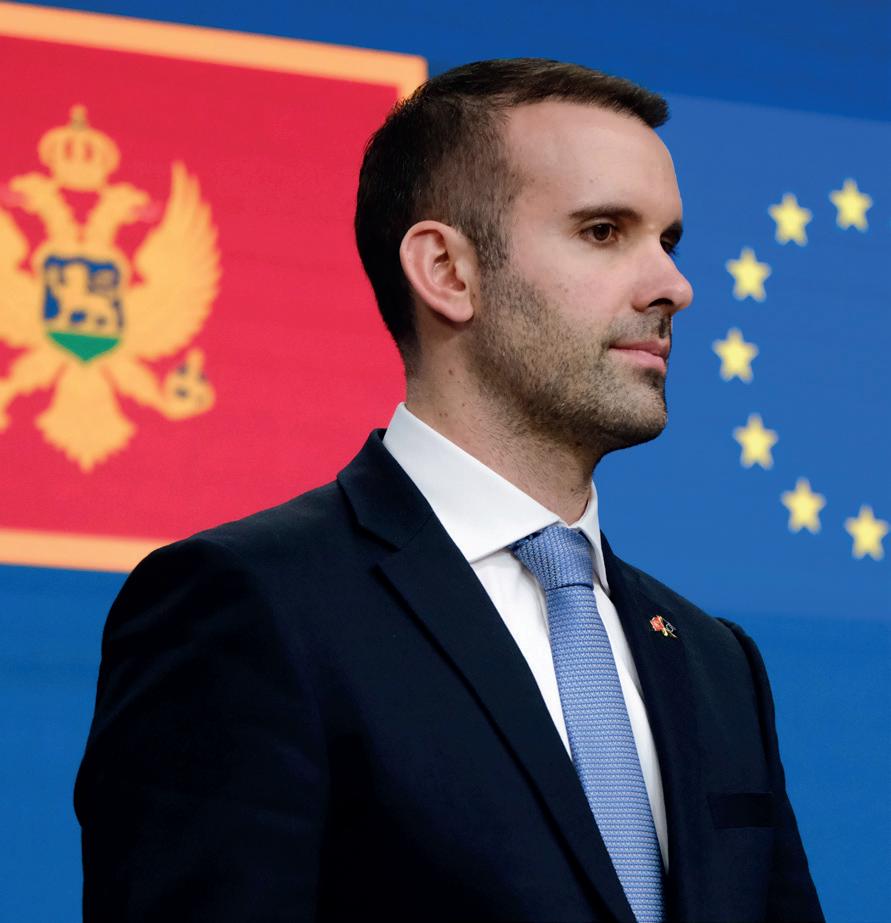
Although there are justified doubts about whether all EU member states have the necessary will to enable Montenegro to join soon, should one be as “full of enthusiasm” as Milojko Spajić?
Montenegrin Prime Minister Milojko Spajić is “full of enthusiasm” about the prospect of Montenegro joining the European Union by 2028. Following the relaunch of accession talks last summer after years of stagnation and the positive report on meeting interim benchmarks for Chapters 23 and 24 (IBAR), Podgorica has since closed three additional negotiation chapters. The last time Montenegro closed any chapters was in 2017, while accession talks officially began in 2012.
EU officials publicly encourage Spajić’s optimism, asserting, in essence, that they are ready to support Montenegro in its efforts
THE OUTCOME IN UKRAINE IS A SIGNIFICANT FACTOR IN SHAPING THE FUTURE OF THE EU
Von der Leyen’s early tour of the Western Balkans at the start of her second term signals that enlargement is returning to the Brussels agenda, largely due to the war in Ukraine and the fast-tracked candidate status granted to Ukraine, Georgia, and Moldova in December.
EU Enlargement Commissioner Marta Kos has highlighted Montenegro’s lead in the integration process compared to other regional countries, stressing that it has a realistic chance to conclude accession negotiations during her mandate, which runs until 2029. A proactive enlargement policy has become an investment in the EU’s security and stability— after all, exporting stability is far preferable to risking the import of instability.
Still, can Montenegrins—and later the Western Balkans, sidelined from the enlargement agenda in recent years—seize the opportunity presented by a more favourable political climate for expansion? This remains a divisive issue within the EU, further complicated by the French president’s insistence that the Union must reform itself before admitting new members.
Podgorica and its neighbours have never lacked optimism, just as Brussels has never been short on promises. Yet, beyond the usual carrot-and-stick approach, nothing truly remarkable has happened. Let’s not forget that, for over 20 years, EU membership has been a moving target for the region. The closest the Western Balkans have come to the European family is by stepping into the antechamber known as the European Political Community—an initiative devised by French President Emmanuel Macron, applying classic coaching techniques to “boost” enthusiasm and motivation.
“He’s hoping in vain,” say the sceptics, now directing their doubts at Milojko. But is Spajić “shooting blanks,” regardless of whether his goal is closer due to genuine reforms or simply because the EU’s needs have shifted?
Few believe otherwise, including Mike Leigh, former Director-General for Enlargement at the European Commission, who sees this goal as highly unlikely. Leigh and his like-minded peers indeed recognise that geopolitical factors now carry more weight—but that doesn’t mean they will continue to do so in the next phase.
to “move quickly.” Speaking from Podgorica, European Commission President Ursula von der Leyen stated that she was “impressed by both the speed and quality of Montenegro’s progress,” adding that “membership by 2028 is an ambitious but achievable goal.”
The future of Ukraine is a key determinant in shaping the EU’s future. Another major factor lies in the political changes that have taken place in Germany. The third is Montenegro’s own internal dynamic, which means that success ultimately depends on how much effort it puts in. None of these factors clearly define Montenegro’s chances of swift EU membership. Like the former EU official, I genuinely doubt that all member states have the political will to set aside their disagreements—even in geopolitics—to grant Montenegro accession. But one should be as full of enthusiasm as Milojko Spajić.
A reason for optimism could lie in the EU’s possible tactic of making a small “concession” by admitting Montenegro and possibly Albania to signal that enlargement remains on the agenda. However, even if all member
states agreed to such a move, accession by 2030 still seems optimistic. If any country demonstrates convincing progress in meeting membership criteria, a single accession by then might be feasible.
For Vladimir Pavićević, a political science PhD, even the future direction of the European project remains unpredictable. However, he tells our magazine that geopolitical circumstances undoubtedly play a crucial role in Montenegro’s chances of joining the EU quickly. Pavićević also highlights an internal process within Montenegro that sustains this ambition—a strong fight against organised crime.
“We have never had such a dedicated fight against organised crime as we do today in the entire history of Montenegro. It is important to emphasise that this credit goes entirely to the team at the Special State Prosecutor’s Office. They are contributing the most to maintaining faith in Montenegro’s swift EU membership through their work,” Pavićević assesses.
The election of Donald Trump as U.S. president is also a key factor for Europe’s future. Pavićević assumes that Trump will have little interest in Europe’s internal dynamics. He noted that in the past, U.S. officials often made statements that all but dictated what would happen in Europe, but he believes this is now changing and that Europe will have to make decisions with greater autonomy, including in enlargement policy.
MONTENEGRO AS THE CARROT ON A STICK?
Everyone loves a happy ending, and European policymakers need one. They understand that both the weary EU and those languishing in its waiting room need a success story—perhaps of a small, fragile country embraced by Mother Europe. Being so small, Montenegro would barely be noticed within the European family and could hardly disrupt the Union’s internal balance. At the same time, its accession would offer hope to others still waiting at the door.
BAERBOCK REJECTS RUSSIAN GREY ZONES.
German Foreign Minister Annalena Baerbock advocates for the swift accession of Western Balkan countries, Moldova, and Ukraine, stating that “due to Russia’s aggression against Ukraine, EU enlargement has become a geopolitical imperative.” She refuses to allow the existence of future “grey zones” in Europe that could serve Russia’s interests. For this reason, Baerbock sees enlargement to the Western Balkans as a matter of common interest, freedom, and peace, highlighting Montenegro’s advantage as a long-standing NATO ally.
STILL MISSING ONE MORE PAPER
EU ambassadors remain deadlocked over opening Cluster 3 in Serbia’s accession talks, which covers competitiveness and inclusive growth. European governments expect Serbia to make further progress in the rule of law and normalising relations with Priština. While the EU continues to

FOR VLADIMIR PAVIĆEVIĆ, EVEN THE FUTURE DIRECTION OF THE EUROPEAN PROJECT REMAINS UNPREDICTABLE
send messages of support to Belgrade, the “window isn’t opening.”
Talks on Western Balkans accession have dragged on for 20 years, with Brussels applying various approaches to a process that, in simple terms, revolves around the infamous
acronym FTJP—”fali ti još jedan papir” (you’re missing one more paper). The EU’s recent actions have deeply frustrated many in Serbia, especially those favouring membership.
Political scientist Vladimir Pavićević believes that, at this moment, there is no clear European perspective for Serbia or the Western Balkans. He sees the coming period as one in which movement towards a decision will take shape.
“I believe Europe would be making the right move by immediately admitting Serbia and Montenegro, which would open the membership perspective for the entire region. But we, too, can push for decisions that align with our interests—to join the EU as soon as possible.”
Poland has emerged as one of the strongest advocates for EU enlargement to the Western Balkans. Its presidency of the Council of the EU presents a major opportunity for Balkan countries. The programme for its term emphasises the need for the EU to protect itself and its citizens, safeguard its immediate neighbourhood, and provide Europeans with a sense of security and prospects for development. Poland makes it clear that Europe’s security depends on integrating a region still vulnerable to political crises and external influences from powers like Russia and China. The key question is whether Poland can overcome internal resistance within the EU to enlargement. France and the Netherlands remain cautious about expansion. Failure would only fuel Euroscepticism further and strengthen the influence of non-European actors in the Balkans.
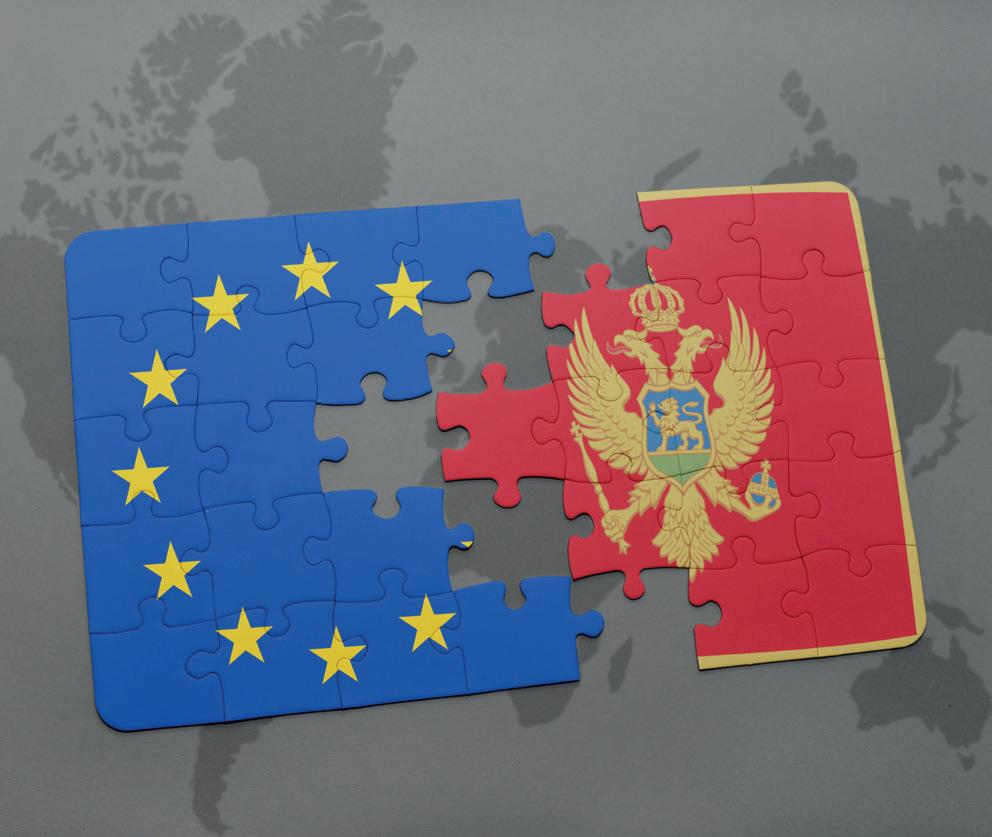

From the book The Kind Souls of Sudan by Viktor Lazić, Laguna, 2025.
Every day, both the guilty and the innocent perish—soldiers, women, and children die in Sudan. Hundreds of thousands flee in desperation, considering themselves lucky, as millions remain trapped in the heart of brutal clashes, unable to escape.
A few years before the wars and uprisings, I travelled across Sudan for a month. I covered around 8,000 kilometres and grew fond of the Sudanese desert—its proud, brave, and honest people who taught me the true meaning of hospitality. The Sudanese, with their kind-hearted nature, brought me closer to a four-and-a-half thousand-year turbulent history, a history little known to the world, yet it shines in my soul like stars over the vast, endless desert.
The whole world has heard of the Egyptian pyramids thanks to effective marketing, yet few are aware of the Sudanese ones, despite there being twice as many. Even Herodotus wrote about the Sudanese pyramids—he knew
of them in an age when news travelled by pigeons and couriers—yet most people I meet in the 21st century have never heard of them.
THE WHOLE WORLD HAS HEARD OF THE EGYPTIAN PYRAMIDS THANKS TO EFFECTIVE MARKETING, YET FEW ARE AWARE OF THE SUDANESE ONES, DESPITE THERE BEING TWICE AS MANY
In recent years, Sudanese people have made significant efforts to inform the world that their land, too, is home to these pointed wonders. Whenever they write or speak about their country, they never fail to mention the number of pyramids they have.

For them, these pyramids are more than mere monuments of ancient history—they are part of the very essence of every Sudanese. In them, they see the pinnacle of aesthetics, art, and the power of their people; they see the reflection of their soul. Even during the 2019 revolution, protesters painted pyramids on road signs, advertising billboards, and banners—they are symbols of freedom, of the enslaved servant who rises to become a master and creates something extraordinary.
Few people know that in ancient Egypt, as well as in Nubia, these giant structures were not built by slaves. Pharaohs employed skilled and well-paid craftsmen, as well as ordinary people, including farmers, who worked on construction sites when their fields were flooded. For them, it was the highest honour to participate in such a magnificent endeavour, even to lay down their lives for a structure dedicated to their ruler, whom they regarded as a deity. Workers who perished during construction were buried nearby, ensuring they would remain forever close to the pharaoh’s side—considered the greatest reward. This is what one of the most renowned Egyptologists, Dr Zahi Hawass, Egypt’s Minister of Antiquities, told me when he was in Belgrade signing books for the Museum of Books and Travel.
The highest concentration of pyramids in the world, all in one location, is found in Sudan, at the Meroë archaeological site near the banks of the Nile, which is precisely where I am headed. It is also the country’s most significant tourist attraction.
Unlike other sites, these pyramids are close to the main highway. I buy a bus ticket to the next town, asking the driver to drop me off near the pyramids.
On a sandy ridge, the once smooth, sharp, and enigmatic structures—like jagged teeth pointing towards the sky—now stand weathered, blunt, and rough. In ancient times, they reached heights of up to thirty metres, equivalent to eight to ten modern storeys.
In front of most pyramids stands a chapel that resembles an entrance or vestibule, yet it

HERE, IT IS JUST THE PYRAMIDS, THE DUNES, AND ME. IN A MONTH OF TRAVELLING THROUGH SUDAN, I HAVE NOT ENCOUNTERED A SINGLE TRAVELLER
is not—instead, it is a separate chamber filled with engraved hieroglyphs and depictions of kings, queens, and gods. This is how I learned that warrior queens once led entire armies in Sudan and that kings shared power with their queen mothers.
I brush away the sand and dust with my hand, hoping to see more clearly—but also to feel the ancient reliefs beneath my fingertips.

I came across a beautiful engraving of the Ba bird with a human head, a symbol of the spiritual being, followed by giraffes, elephants, and gazelles. The guidebook states that there are hundreds of such carvings—a reminder that this was once a land of lush green savannahs.
Some inscriptions are in an ancient script that these people created for their long-extinct language. The finest reliefs were transferred to the British Museum in 1905, while a few were placed in the National Museum in Khartoum.
The pyramids here are slender and tall, with only a few being broader, yet they all share one characteristic—they stand in solitude, exuding a deep sense of tranquillity.
At the Meroë (Bagrawiya) site alone, over a hundred pyramids were built between the 8th century BCE and the 4th century CE, according to a United Nations document.
Here, it is just the pyramids, the dunes, and me. In a month of travelling through Sudan, I have not encountered a single traveller.


But then, the moment arrives. I spot a silhouette moving across the sand, quickly approaching.
“I am Danas, a traveller from Lithuania. I haven’t met a single foreigner in a month! Where have you come from?” His surprise is as great as mine. And so, a wonderful friendship begins.
“Meet my travel companion,” he says. I turn to look, but there is no one there. Am I seeing things from the heat, or is his companion invisible? The desert stretches endlessly in all directions—I would have noticed if he had arrived with someone.
Then, he reaches into his bag, pulls out a plush camel, and carefully positions it for a photograph.
“This is the greatest traveller among camels. It has been with me to over a hundred countries. I’ll give it to my little niece so she knows I always thought of her.”
His words reminded me of my cousin, Mila Bogdanović. When she was a child, I gave her a plush teddy bear, which she carried on all her travels—for years, it has been with her everywhere, from China, Florida, and New York to Brazil and the English marshlands. I found it in a war zone; they told me it had belonged to a soldier, a gift from his little daughter… I gave the bear to Mila when she was six, asking her to keep it safe, believing it would bring her good luck. My little cousin took it seriously— she named it after me, Viki, and even carries it for good luck during exams.
That was a decade before today’s craze of taking plush toys to famous landmarks. This trend has now become so widespread that some temples have begun to explicitly ban teddy bears from being photographed next to icons and sacred objects.
Danas’s camel and Mila’s bear have seen more of the world than most people on this planet…
Before long, Danas and I became like brothers—two wanderers who had come from opposite ends of the desert, driven by the same

STANDING BEFORE A PYRAMID, ONE FEELS AS IF FACING A STAIRCASE TO THE SKY—HOW COULD I RESIST THE URGE TO CLIMB
spiritual hunger. We satisfied it with the pyramids, taking photos of each other. But in time, those pictures would fade from my memory; new roads would open before me across the world, and I would race in all directions, driven by work and endless preoccupations.
Only now, as I write this travelogue, has Danas sent me the photos we took by the pyramids—and I couldn’t be happier.
Two thousand three hundred years ago, Sudan was ruled by King Arkamani, whose
parents had ensured he received a GrecoRoman education, introduced to the region through the Ptolemaic dynasty in Egypt. He deeply angered the priesthood by refusing to grant them excessive power and wealth. The priests believed they could persuade him, as they had some of his predecessors, to commit suicide—likely under the pretext that it was the will of the gods. But Arkamani was an unusually rational man, and instead of sacrificing himself, he had them all executed.
As a result, Sudan became the only place where statues of kings were taller and more massive than those of the gods. From that point on, rulers controlled all earthly affairs, leaving only the afterlife to the priesthood—and not even that entirely. His pyramid is the largest and oldest, so it was the first one I visited.
The pyramids have suffered severe damage; some are missing entire sides. They resemble maimed warriors returning from a

brutal battle. The Nubians were economical in construction, creating artificial hills in the centre—piles of rubble—while placing stone blocks only on the exterior. This is visible in the “wounded” pyramids.
Now, under UNESCO protection, these pyramids differ from the Egyptian ones in that the tombs are not part of the structure itself but are built beneath them as separate chambers. The pyramids serve more as monumental tombstones and rarely contain secret rooms. Bodies in these tombs were usually not mummified but buried or cremated.
The entrances to the pyramids of the rulers were covered with plaster and lime mortar, while their ceilings were adorned with stars in red, yellow, and blue.
Several pyramids were restored in the 1980s. These new structures were built using ancient techniques, providing historians with valuable insights into the original construction process. Their smooth, light-brown surfaces contrast sharply with the dark-brown hue of the old pyramids—and with the desert itself. They offer a glimpse of how the entire complex once looked. Yet, they are artificial, glaringly new—an archaeological “plastic surgery,” a painful reminder that much of the original pyramids have been destroyed.
I noticed that the upper sections of these structures were never pointed. Instead, a square block was placed at the very top, with a circular one on top of that, like a finishing touch to a masterpiece. This can only be seen on the reconstructed pyramids, as treasure hunters had long ago hacked off the peaks of the originals, leaving them completely flat.
Standing before a pyramid, one feels as if facing a staircase to the sky—how could I resist the urge to climb? Within minutes, I was at its flat summit.
A chain of pyramids stretched before me like a row of brothers and sisters. Only from this vantage point did I fully grasp their power and grandeur. Once, they were covered in a yellowish plaster resembling sand, making them appear like mirages emerging from the dunes.

THE PYRAMIDS ARE GRAND ENOUGH TO DECLARE THE MIGHT OF ANCIENT PHARAOHS YET HUMBLE ENOUGH THAT THEY, TOO, SEEM TO BOW BEFORE THE DESERT AND THE VASTNESS OF NATURE
The vast blue sky kisses the desert at their peaks. I am not standing on a pyramid—I am standing amid that kiss.
The shifting dunes, as if alive, dance in response to the wind. One moves before my eyes, curling up like a tame kitten in the corner between a chapel and a pyramid. The chapels resemble the entrances to medieval fortresses—two slightly slanted towers with a passage in between.
The pyramids stand on elevated rocky ground, making them impervious to the

encroaching sand. Suddenly, a patch of low, sparse grass appears before me—an endless yellow landscape now marked by a vivid green stain. As the ultimate triumph of life, two proud shrubs have sprouted right in the centre, and a little further away, a donkey grazes. Beyond them, a row of dunes cradles yet more pyramids.
I walk across the low dunes, moving from one pyramid to another, leaving a clear trail in the smooth sand. Some pyramids were not built from the same type of stone; up close, their surfaces shimmer like a kaleidoscope, reflecting various shades under the sun—from deep brown to bright red. From a distance, everything looks uniform, softened into muted tones.
Stepping back far enough, their grandeur takes my breath away—scattered along the horizon, perched atop the dunes, rising from the golden sea that gave birth to them. And yet, amid it all, against all odds, a few small green islands of grass persist.
The pyramids are powerful yet somehow “gentle”—I feel the urge to run my hand over them as if to caress them. They are grand enough to declare the might of ancient pharaohs yet humble enough that they, too, seem to bow before the desert and the vastness of nature.
From the book The Kind Souls of Sudan by Viktor Lazić, Laguna, 2025.
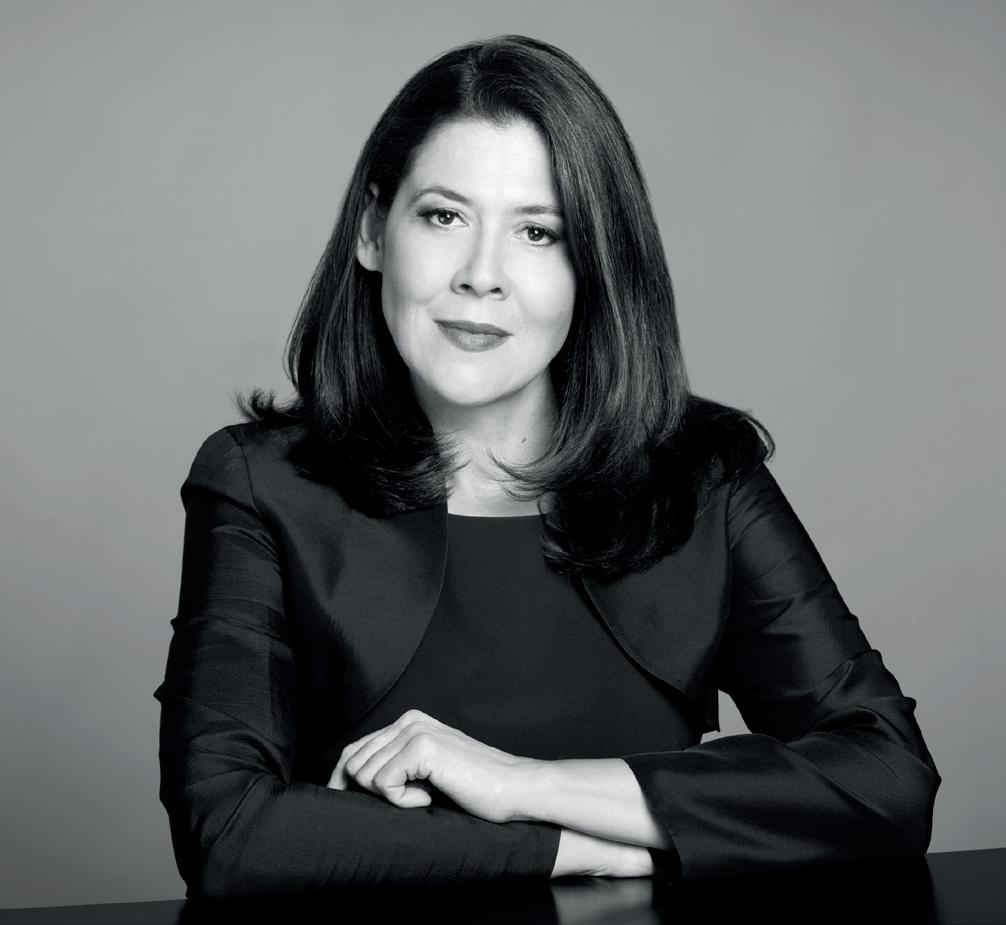
JOVANKA VIŠEKRUNA
JANKOVIĆ
Pianist, Founder of ArtLink Association and Festival
The story of ArtLink is my personal artistic story and journey through the development of a music association and festival that had a clear vision from the beginning—to serve artists, particularly young artists, on their path of growth and career development. That vision also included linking artists from across the world and creating meaningful and creative partnerships that serve the artists and art itself.
After twenty years of devotion to that vision, I can proudly say that ArtLInk has become the link and
inspiration for many young talents and the creative lab for exceptional artistic projects, programs, artists, artistic coproductions and interesting, unique programs.
Linking cities and festivals through the platform Festival Cities with European Festival Association, young artists in the orchestra Camerata Balcanica, artists from different continents in East, West, North, and South, and many other musical
connections, ArtLInk has positioned itself on the art map as a synonym for powerful and inspiring connections through music and art.
Our latest music program connects two cities, Belgrade and Vienna, in the Cycle—Vienna. Belgrade Musical Connections in the city of Vienna with the support of UNESCO and in cooperation with the partners from Austria—Wiena International Soloists.
Our program MozartMokranjac was premiered in Vienna. For this program, as pianist and artistic director, I performed and presented Choir LOLA with Maestro Milovan Pančić and the string quartet Camerata Balcanica with Andrea Nikolić, a violist, as a guest.
How did this story start?
It all started with a great love for music and admiration for the profession of a professional musician and pianist. It all started with my curiosity and a huge desire to learn and grow and to meet the world of performing arts and the world of great musicians. Music provides unlimited opportunities for talent development, personal and professional development, and beauty to audiences.
What activities marked 20 years of ArtLink?
This year, the ArtLink festival has been recognised and supported by UNESCO and the UNESCO National Commission for its high-quality programs that promote cultural heritage, women artists, and regional cooperation through music. Artists from all continents have performed at the ArtLink festival over the past twenty years, and ArtLink has achieved significant long-term partnerships with the European Association of Festivals, Ljubljana Festival, festivals in the region, and a unique collaboration in the previous year with artists from Korea, Portugal, France, the United States, Australia. ArtLink is a pioneer in the region in promoting and nurturing young musical talents, for which several thematic programs have been created.
As a long-standing member of the European Festival Association and Platform member of several platforms, ArtLink became a partner in the Creative Europe cooperation project, which involved two festivals from Hungary and Portugal.
IN A WORLD MARKED BY A CONSTANT RUSH FOR MERE SURVIVAL, FESTIVALS AND ARTISTS ARE INVITED TO SHOW SOMETHING DIFFERENT THAT CHANGES THE ORDINARY AND THE EXPECTED
The second consecutive Women ArtLinks Forum was held at the Madeleine Palace of Art. It is dedicated to women in art, women artists, and women who make art a business. The forum was held in October, which is the month dedicated to raising awareness about breast cancer.
We launched the Music for Health initiative, through which we held several concerts to raise funds for oncology clinics in Belgrade and Niš.
I am thrilled to have created Women to Inspire - Modern Muses Ensemble with several extraordinary artists and that I had my piano appearances this year in Portugal at the Algarve festival with cellist Isabelle Vaz,Wienna with Camerata Balcanica, premiered in Serbia with an East - West ensemble from Korea in National Museum of Serbia, and in piano duo with French - Australian pianist Dee Penicaut and soprano Amy Blake. It was an honour for me to be the Artistic Director of the program Braziliana in which I presented the music of Brazilian composers Villa Lobos and Carlos Gomes with Camerata Balcanica in the Western Balkan region. Also to create the program Saint Lucia with Embassy of Sweden in the White Palace and to present the project Silent voices by American chamber ensemble - Black Oak trio.
Parallel to my artistic performances I am proud to have been the member of the Board of European Festival Association for a number of years and to have had the chance to present ArtLink at the Directors Panel at the International Shanghai Festival, where it was given to important stakeholders in the Music and Festival Industry from the US, Azia, and Europe, at the summit of European Festival Association and the Conference organised by Association of French Festivals in Reims..
Who have been the key supporters and partners in the last 20 years?
For me, as an artist and Artistic Director, the most important support was recognition by the French Ministry of Culture and the Chevalier de l’Ordre des Arts et des Lettre, which was given to me in 2017, and I am grateful for that.
ArtLink Young Talents Programs as the core program has been strategically supported by the Nordic Council of Ministers, Porsche Company, Visegrad and Western Balkan Fund, but has been developed to the highest standards in nurturing young musical talents with the support and in cooperation with Societe Generale Bank in Serbia, French Institute and Embassy of France in Serbia. This program laid the foundation of the career development program for young talents in Serbia,
This is also a wonderful example of Art and Business cooperation that was initiated at the first Round Table on Art and
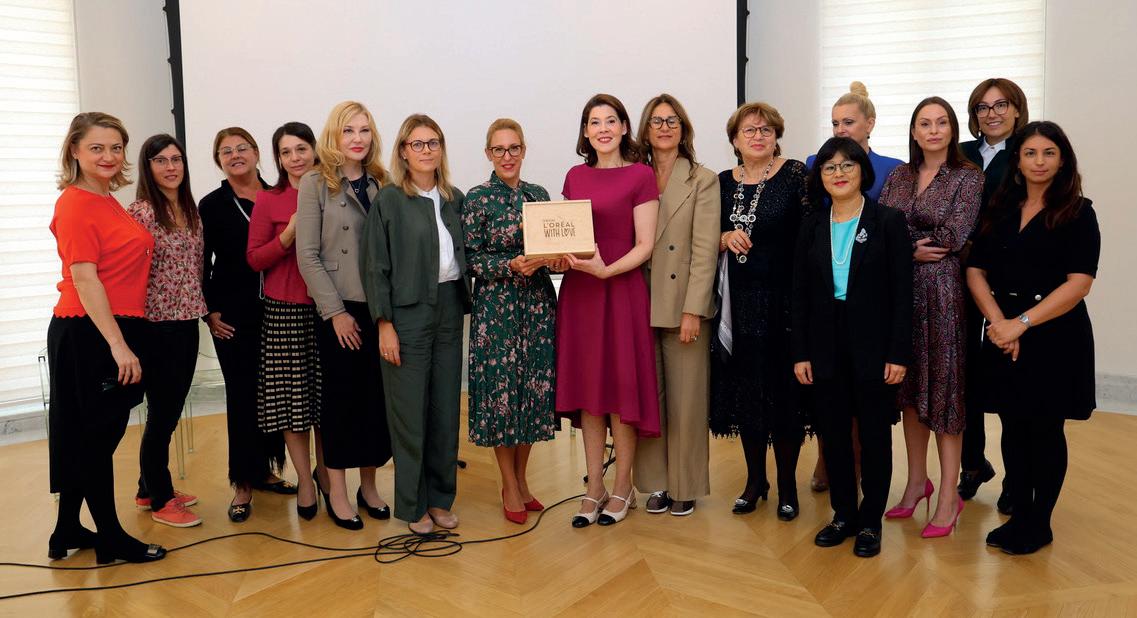
A WORLD WITH MORE BEAUTY IS A BETTER WORLD, AND I BELIEVE THAT WOMEN BRING THAT BEAUTY TO INSPIRE
Business that ArtLink organised in 2005, and that introduced the Philatrophy program in Serbia. ArtLink has since its foundation worked on community investment programs, not only in the capital but also in smaller towns such as Majdanpek, Kučevo, Zaječar, Kragujevac, and raising awareness on the topic of nature protection, energy saving, We have we implemented programs in cooperation
with GIZ, the Mitsubishi company in the entire region, the Ardagh Group, and UNIQA Insurance and the Zepter International company.
We have built regional cooperation with the Kamerata Balcanica musical ensemble with the support of the International Visegrad Fund and the Fund for the Western Balkans and artistic residencies with a support of EUNIC. Embassies of

Brazil and Switzerland. With Camerata Balcanica for UN Serbia, ArtLInk organised the Concert for Peace while simultaneously being a regional hug for the Western Balkans in the European Association of Festivals.
In recent years, the ArtLink festival has been held outdoors - at the Belgrade Fortress as well as at fortresses in Serbia and the region, which contributed to the promotion of the city and the region in cooperation with local partners such as the Zaječar Theatre, Felix Romuliana, Golubac, and partners from the entire region. Performances by top artists included the Janoška ensemble, John Malkovih, the Vienna Academy Orchestra and many others. The ArtLink festival connected the most beautiful destinations in the region. It even held a musical Bach marathon on the banks of the Sava River.
What is your vision for the future?
We aim to continue being innovative and creative and to continue being pioneers in bringing the spotlight to emerging artists and artistic interventions needed in society. We will remain an incubator for the career development of musicians and musical connections.
As the motto of our Women Forum was “Beauty will save the world,” we will intentionally bring this beauty to the world around us through music and art.
Finding the beauty and light surrounding us and sprinkles the beauty of the world and the light of our hearts will be our permanent mission. A world with more beauty is a better world.
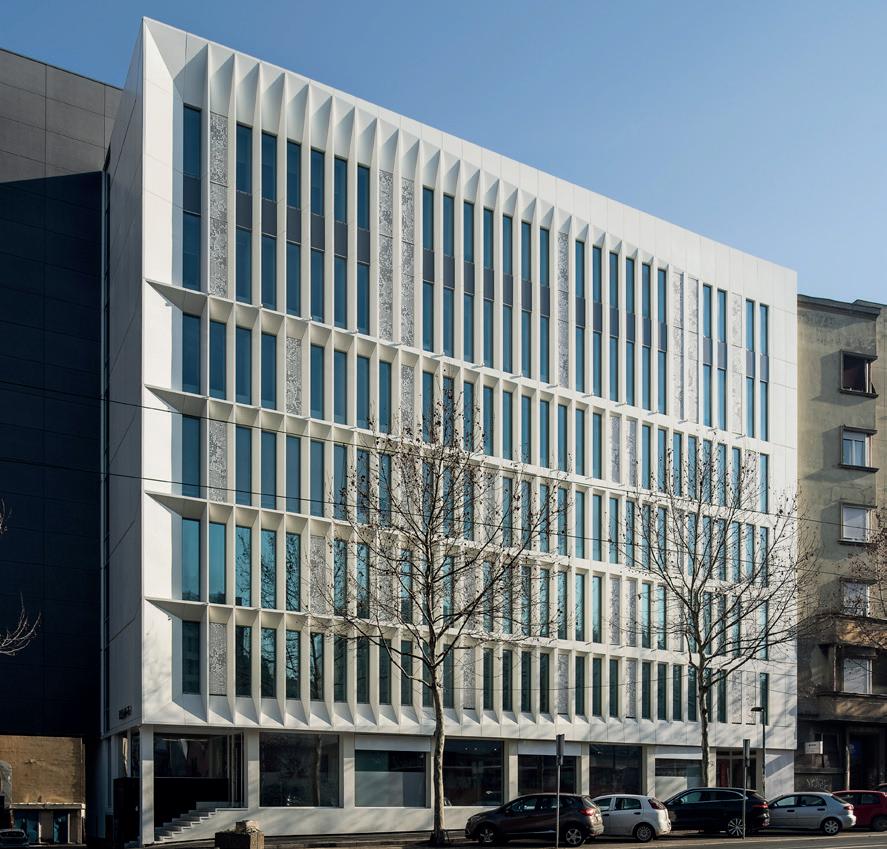
For decades, they have been part of the urban landscape—observers of the changes unfolding around them and witnesses to their own gradual decay. The office buildings Bulevar 79 and M44, designed in the 1960s and 1970s, reflected the architecture of that era and the business needs of the time. As key hubs of business life, they contributed to the overall economic development of the former Belgrade.
The history of these buildings is more than intriguing. The M44 building, located at the corner of Makedonska and Kondina streets, stands on the site of the former Jugobanka, and until 2003, it was also home to the famous tavern “Pod lipom.”
This was one of the three legendary taverns that formed the “Bermuda Triangle” of Belgrade’s social life, along with the restaurants “Šumatovac” and “Grmeč.” On the other hand, the former Trudbenik enterprise, situated on Bulevar kralja Aleksandra, was transformed into the Bulevar 79 office
building. Like many other structures in the city center, these buildings experienced decades of decline, falling into a state of serious neglect while waiting for their second chance.
Thanks to a comprehensive revitalization carried out by Marera Properties, they have been given a completely new and recognizable identity. The company transformed them from unattractive and dysfunctional spaces into modern, sustainable, and carefully designed A Class office spaces that meet the standards of contemporary businesses.
Through meticulous planning and the application of modern architectural and engineering solutions, these buildings have been transformed into spaces that not only fulfill functional needs but also seamlessly integrate with the surrounding urban environment. Their architectural heritage has been largely preserved, providing an ideal foundation for further intervention, including facade and interior reconstruction. This has given
FOR DECADES, THEY HAVE BEEN PART OF THE URBAN LANDSCAPE—OBSERVERS OF THE CHANGES UNFOLDING AROUND THEM AND WITNESSES TO THEIR OWN GRADUAL DECAY


the buildings a new sense of dynamism and energy. Special attention was paid to maximizing the available space and incorporating modern interior design to create an environment that fosters productivity and efficiency.
Thanks to extensive reconstruction, the use of contemporary, innovative approaches, and interventions that fully utilized their potential, the Bulevar 79 and M44 office buildings have become prime examples of modern architecture, recognized by professionals in the field. The renovation project for Bulevar 79 was awarded the City of Belgrade Prize for Architecture and Urbanism in 2018, while the reconstruction of M44 received the prestigious “Ranko Radović” award. Both projects were executed by the architectural firm Remorker. The success of the M44 renovation was further affirmed by the expert jury, which praised the building’s exceptional contextuality and seamless integration into the urban environment, noting that even the citizens perceive it as a “long-time resident” of the neighborhood.
Beyond professional recognition, the value of the Bulevar 79 and M44 office buildings has also
been acknowledged by contemporary businesses— from banking and legal sectors to IT firms—that appreciate modern infrastructure, accessibility, and prestigious location. Over time, these buildings have become landmarks on Belgrade’s business map, not only due to their enhanced architectural value but also as symbols of a modern business environment in the city center. For companies seeking a workplace that keeps pace with the city’s energy, Bulevar 79 and M44 offer more than just premium office space. Located in two distinct districts at the heart of Belgrade’s center, they place your business in the midst of vibrant city life— where work, networking, and social opportunities seamlessly intersect.
THANKS TO A COMPREHENSIVE REVITALIZATION CARRIED OUT BY MARERA PROPERTIES, THEY HAVE BEEN GIVEN A COMPLETELY NEW AND RECOGNIZABLE IDENTITY


BORIS SPASSKY (1937-2025)
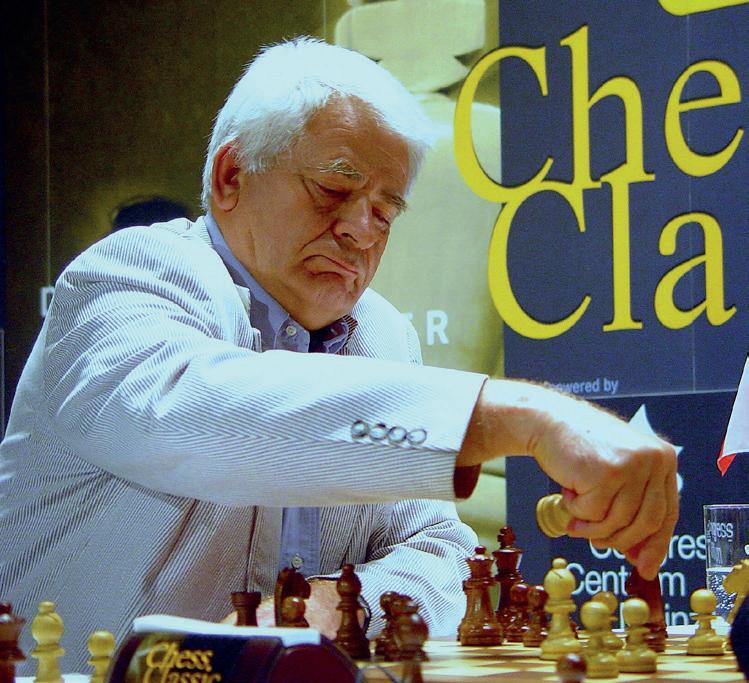
The 10 th World Champion, Boris Spassky, passed away on February 27, 2025, in Moscow at the age of 88.
Many decades later, from his modest Moscow apartment, Boris Spassky would look back and express regret for deciding to continue the 1972 World Championship match — when he could have claimed victory by default. “The stakes were much greater than my own interests,” Boris said. “I was even ordered to halt the match by Soviet officials. But the ultimate decision had to be mine.”
As a consequence, Boris Spassky cemented his reputation as the ultimate gentleman — a champion of fair play — perfectly in tune with his well-known personality at the time. Moreover, his crucial decision helped to establish the greatest legend in chess history: that of Bobby Fischer, who, at the height of the Cold War, defeated the champion of the “evil” Soviet Union.
In truth, as Spassky himself admitted, he could never take
a dislike to Fischer. Instead, he pitied him, as one might pity a troubled child. He wanted to defeat him as a sportsman, to teach him a lesson over the board. It’s worth noting that before the match, Fischer had lost games to Spassky but had never beaten him, thereby illustrating just how dominant his adversary was.
Boris Vasilievich was a handsome, blue-eyed ladies’ man, always fashionable and welldressed. He was never known for relentless hard work but rather relied on what Milan Kundera would call the “unbearable lightness of supreme talent.” He was Mr. Right — in every way contrary to his young rival.
It is fascinating how the “Match of the Century” in Reykjavik shaped Spassky’s life. The analogy is clear: like an actor who stars in an Oscar-winning film, after which nothing else quite compares. But there was so much more — before and after!
Yugoslavia was the principal battleground where East and West could meet and compete in those years. Let’s not forget another “Match of the Century,” held in Belgrade in 1970 — the USSR vs. the Rest of the World. Here, Fischer conceded first board to an in-form Larsen, perhaps to avoid a clash with Spassky — who in fact then proceeded to punish the Danish grandmaster in a brilliant miniature.
After losing to Fischer, Spassky continued playing high-level chess, though without his former ambition. The times had changed, and a new generation led by Karpov had arrived. A notable moment came in 1977 when he played the Candidates Final in Belgrade, only to lose to Viktor Korchnoi — who then began his notorious series of matches against Karpov.
Spassky remained active, but a moment of reckoning came in 1992 when he and Fischer played their bizarre rematch in St. Stefan and Belgrade. “Fischer promised me a rematch in 1972, and he fulfilled it,” Spassky would later say after his defeat. The multi-milliondollar prize fund, provided by businessman Jezdimir Vasiljević to challenge Western sanctions on Yugoslavia, helped him financially. By then, Spassky had been living in France for years, married for the third time. Each of his wives gave him a child — and each eventually left with all his possessions after costly divorces.
Spassky was born in 1937 in St. Petersburg (then Leningrad). As a child, he survived the Nazi blockade, having been evacuated with many other children across the frozen lake. He was one of the lucky ones — the first and third trucks in the convoy were destroyed by a Stuka dive bomber.
During the 1950s and early 1960s, he carved his way up through the forest of great players — Smyslov, Tal, and Korchnoi. In 1966 he was the challenger, but Tigran Petrosian retained his title by a small margin. Three years later, he earned another shot at the title, and this time, he won! He was world champion for only three years, but what years they were.
The Yugoslav press dubbed Spassky the “Pushkin of Chess,” as his fine positional style harmonised with his appreciation for poetry — he even knew many of Pushkin’s verses by heart, not just Eugene Onegin
He had the unofficial status of an émigré —a free spirit who refused to accept Moscow’s directives as to which tournaments he would be allowed to play. After losing the title to the West, he was not favored by many in the Soviet Union. Yet in his later years, Spassky presented himself as a Russian nationalist.
I met Boris in 2004 when he was visiting Serbia to open a youth championship in Obrenovac. I also remember him performing the ceremonial first move at the 2008 Chess Olympiad in Dresden — he chose the Women’s Olympiad board. He made it in a game played by our Alisa Marić. His last public appearance was in 2016 for promotional events.
He leaves behind a legacy as one of Russia’s greatest chess sons.

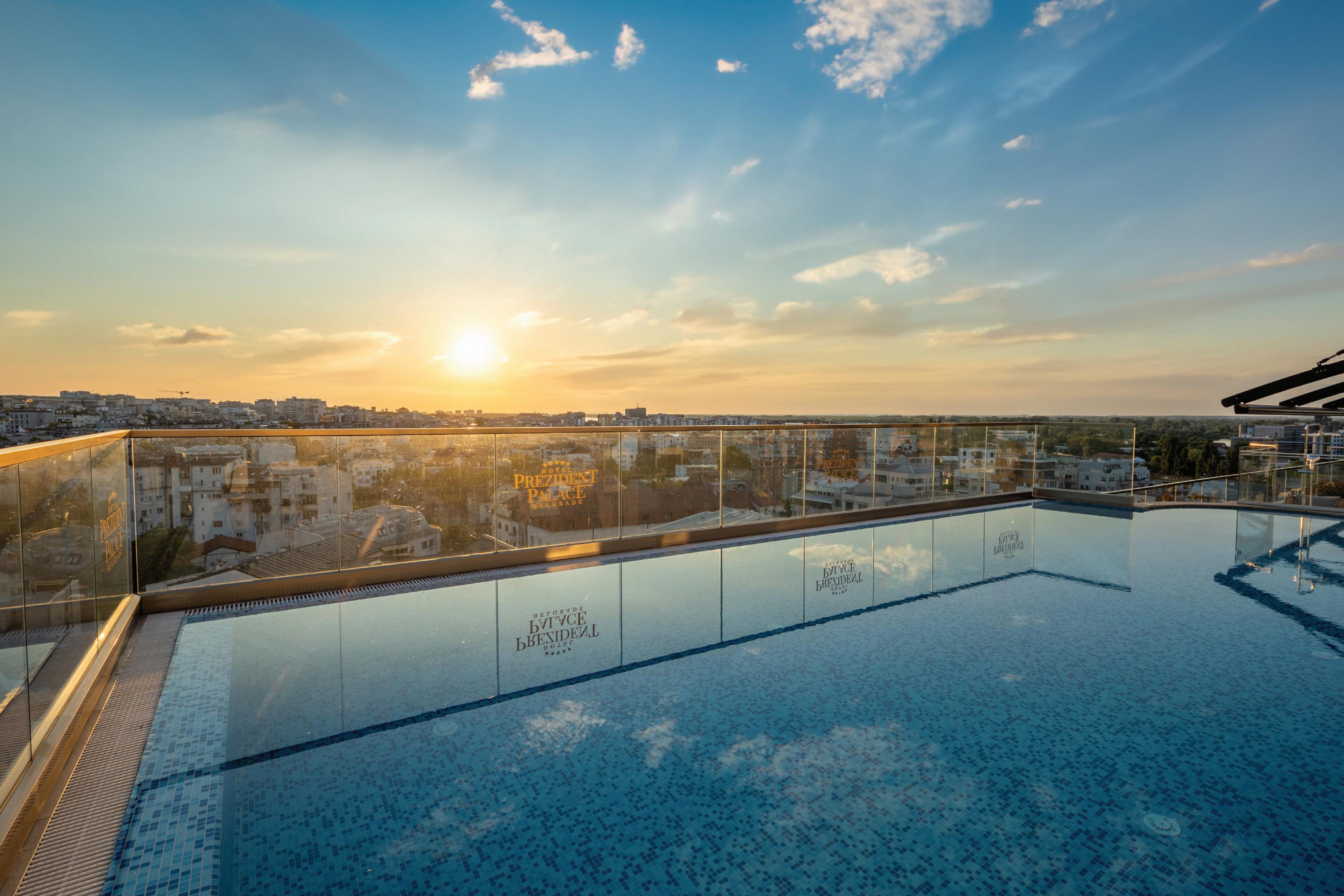



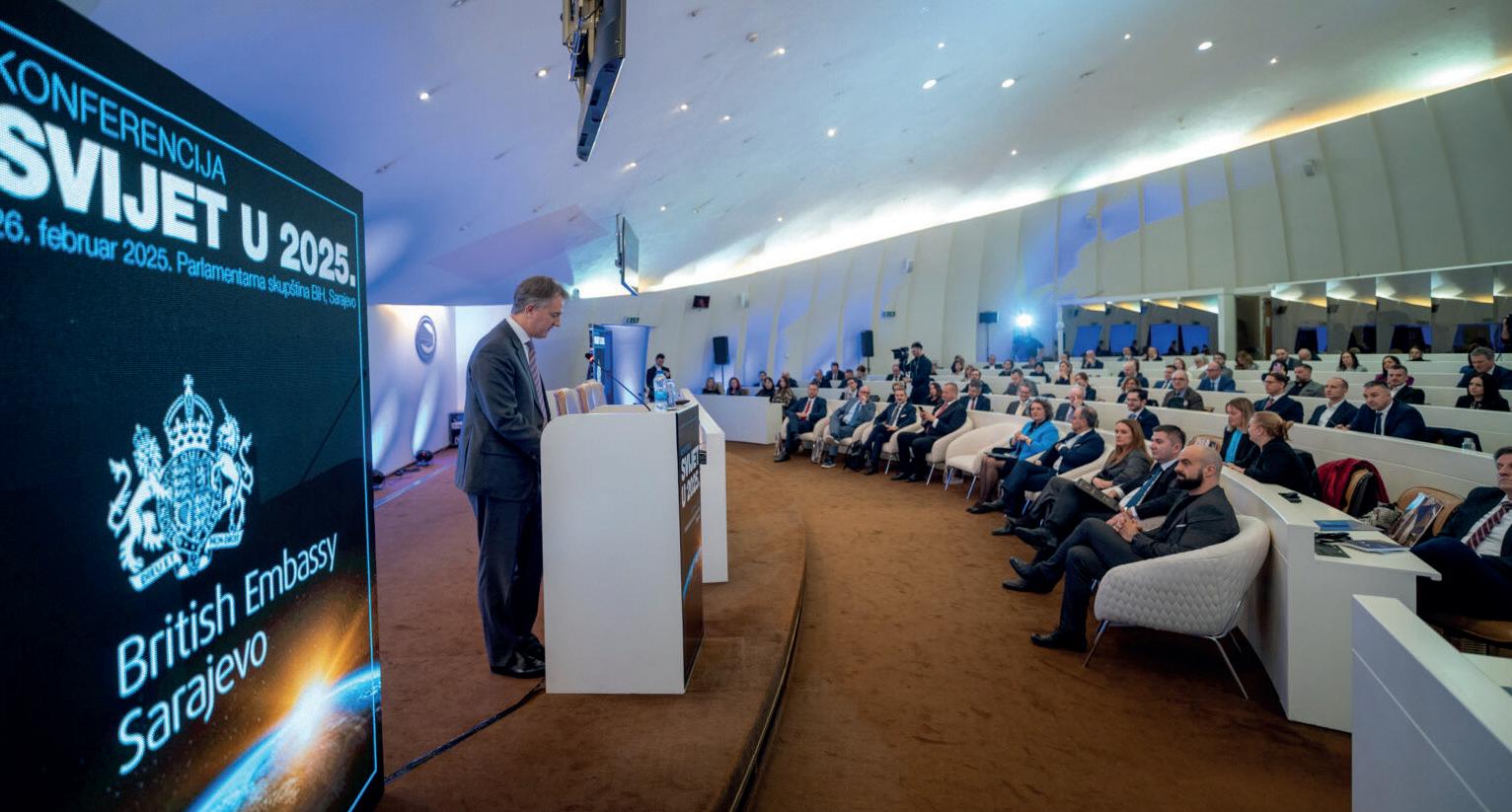
On February 26, 2025, the conference “World in 2025” was held in Sarajevo, organised by Color Media Communications, with institutional cooperation with the Central Bank of Bosnia and Herzegovina (CBBH) and with the support of the Delegation of the European Union to Bosnia and Herzegovina, the Embassy of the United Kingdom in Bosnia and Herzegovina, and the University of Sarajevo School of Economics and Business.
The conference brought together leading economic experts, business professionals, and holders of the highest public offices, as well as representatives of the diplomatic core in Bosnia and Herzegovina.
The conference is one of the oldest events hosted by Color Media Communications. It has already become recognisable in the countries of the region as an event that, through its discussions on the business, political, and social environment, contributes to a better
THE FUTURE CANNOT WAIT – IT MUST BE BUILT THROUGH STRATEGIC PLANNING, INVESTMENT IN RESOURCES, AND STRENGTHENING RESILIENCE TO GLOBAL CHALLENGES
understanding of the challenges facing the economies of Bosnia and Herzegovina and offers specific recommendations in this regard.
Opening the conference, the Governor of the CBBH, Jasmina Selimović, PhD, emphasised that we are currently facing one of the most challenging geopolitical situations in the world and that, as a small and open economy, Bosnia and Herzegovina cannot be isolated from global changes.
Our connection with the European Union is gaining additional importance, especially after we obtained candidate status, while we await the date for the
start of negotiations. In such circumstances, the key question today is not only what awaits us, but how we will adapt to the changes that lie ahead,” said Governor Selimović, emphasising that there is increasing talk of agile organisations that quickly and efficiently adapt to changes in their environment –economic, political or technological, focus on cooperation, continuous improvement and processes that enable constant development and improvement. They often rely on technology and data to make quick and informed decisions.
Considering our current context, where uncertainty and change
have been constant for years, it becomes clear that the most effective direction is to strengthen our internal capacities. And not only at the Central Bank of BH but also at the national level. Therefore, the question that we all have to answer is how agile Bosnia and Herzegovina is and how ready we are to adapt to the future ahead of us,” said the Governor.
On this occasion, she emphasised that the CBBH, through its strategic plan with four key priorities, has laid the foundations for agile operations.
The traditional role of every central bank is to preserve monetary and financial stability. Still, we are taking it a step further – focusing on the modernisation of business processes, investing in human resources and retaining talent, as well as strengthening international cooperation. These four priorities can easily be reflected in the broader picture of Bosnia and Herzegovina: the stability of
the country, investing in talent, modernisation of the economy, and strengthening international ties,” added Governor Selimović, concluding that our task is not to wait passively for changes, but to welcome them being ready.
Addressing the participants of the conference, the Head of the European Union Delegation to BiH, H.E. Luigi Soreca, pointed out the fact that the digital revolution that transformed industry took place to a large extent in Europe and that the European Commission has launched a strategic framework that will guide the European path in the next five years. This is not just a policy document emanating from Brussels but also a call to action for Europe’s transformation into a global leader in innovation and sustainability, said Ambassador Soreca. He added that BH must, to face the challenges, improve and accelerate its reform Agenda.
H.E. Julian Reilly, British Ambassador to Bosnia and Herzegovina, noted that the world in 2025 is on the move, economic development has stalled, and the climate crisis requires urgent attention. “The Agenda of this conference is clear: economic development must be at the heart of every economic discussion in Bosnia and Herzegovina (BH) and the region. The Western Balkans will integrate into the European economy, and BH needs to create a simple, clear, and predictable legislative framework to retain foreign investment.” H.E. Julian Reilly, British Ambassador to Bosnia and Herzegovina, hosted a reception at his residence on the occasion of the World in 2025 conference.
Mr. Robert Čoban, Director of Color Media Communications, focused on global challenges and unpredictable situations, emphasising that each time the conference “The World in…” was organised, it was followed by global challenges and unpredictable situations.
Professor at the University of Sarajevo School of Economics and Business Amila Pilav Velić, PhD held the presentation “Business Pulse 2025: How to achieve sustainable growth”, in which she presented the results of a business survey aimed at assessing the business environment in BH, as well as the perceptions and experiences of companies from all over BH regarding the political and regulatory framework, business environment, macroeconomic conditions, foreign investments, export, fiscal and parafiscal burdens, access to sources

BOSNIA
of financing, anti-corruption measures and the labour market.
The first panel, entitled “Stop the Earth, I’m Getting Off: Where is this world going?”, brought together diplomats and ambassadors who presented their views on geopolitical developments and their impact on Bosnia and Herzegovina. The panel participants included H.E. Julian Reilly, British Ambassador to BiH; H.E. Thomas Fitschen, German Ambassador to BiH; H.E. François Delmas, French Ambassador to BiH; H.E. Gabriele Derighetti, Swiss Ambassador to BiH; and Sara Lindegren, Deputy Head of Mission at the Embassy of Sweden. The conclusions of this panel emphasised that the world is in a state of constant and rapid change and that Bosnia and Herzegovina must develop resilience and capacities
for proactive action instead of passively reacting to global trends.
During the second panel, entitled “Money Never Sleeps: Green Financing – European Trends and Priorities of Bosnia and Herzegovina,” experts from the financial sector discussed sustainable financing as a key factor in future economic development. The participants included Marko Vidaković, Vice Governor of the Central Bank of Bosnia and Herzegovina, Mejra Juzbašić-Bajgorić, Regional Director of Finance in Motion for Southeast Europe, Michele Castoro, President of the Management Board of Intesa Sanpaolo Banka BiH, and Edis Ražanica, Director of the Association of Banks of Bosnia and Herzegovina.
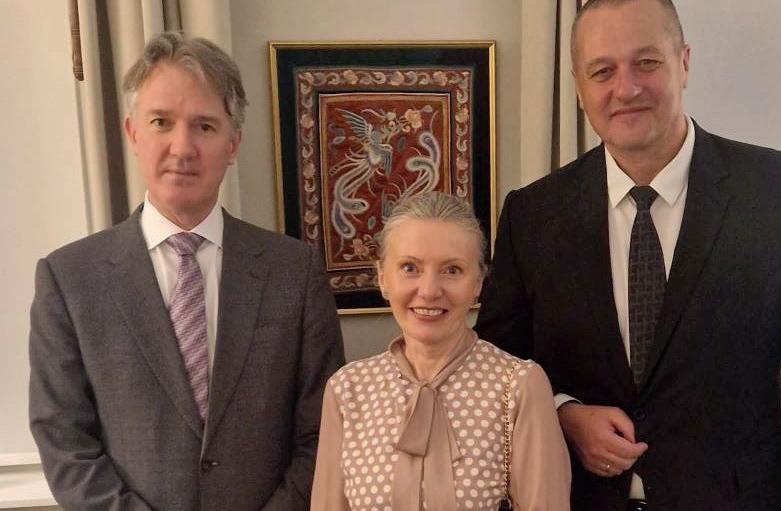
On this occasion, Vice Governor Marko Vidaković emphasised that in the past year, the CBBH has become an active member of two internationally recognised networks – the Network for Greening the Financial System (NGFS) and the Sustainable Banking and Finance Network (SBFN).
“Membership in these networks will enable the improvement of business standards in the field of central banking through the application of best practices in the international environment, thereby preserving the environment and reducing climate risks, which are among the greatest challenges of today,” emphasised Vidaković.
He also noted that the CBBH has begun investing in green bonds, thereby actively contributing to sustainable financial flows and supporting the transition to more environmentally responsible investments. These steps are crucial in positioning BH in line with European and global trends in sustainable financing. The conclusions pointed to the growing importance of green investments and financial mechanisms that support sustainable development, emphasising the need for better integration of BH into European green financing flows. Through these panels, it became clear that the future cannot wait – it must be built through strategic planning, investment in resources and strengthening resilience to global challenges.
The conference concluded with the panel “Brave New World: Digitalization – a Project of the Future,” which was addressed by Nihad Salkić, CEO of ORKA, and Robert Čoban, CEO of Color Media Communications.

3 APRIL 2025
Madlena Art Palace, Belgrade
The Women’s CEO Summit 2025 is scheduled for April 3, 2025, at Madlena Art Palace in Belgrade. This event aims to celebrate and promote gender equality in top business leadership. Organised by Color Media Events, the summit will feature panels, workshops, and networking sessions designed to empower and inspire women in leadership roles.
The program includes an opening session with Tatjana Macura, Minister without Portfolio responsible for coordinating activities in the fields of gender equality, the prevention of violence against women, and the economic and political empowerment of women in the Government of the Republic of Serbia and Brankica Janković, Commissioner for the Protection of Equality. The “Women’s Voice in Diplomacy” panel will feature Ambassador Ane Lugon Moulin of Switzerland, Ambassador Avivit Bar-Ilan of Israel, Andrea Pavukova, President of the International Women’s Club in Serbia, Milana Rikanović, Director of UN Women in Serbia, and Aleksandra Joksimović, Director of the Center for Foreign Policy and former Serbian Ambassador to London. The “CEO Talks: Business” session includes Biljana Braithwaite, Founding Partner & CEO of Sustineri Partners. The summit will also host a “CEO Talks: Fitness & Well-Being” session, followed by an after-work lunch and cocktail party.
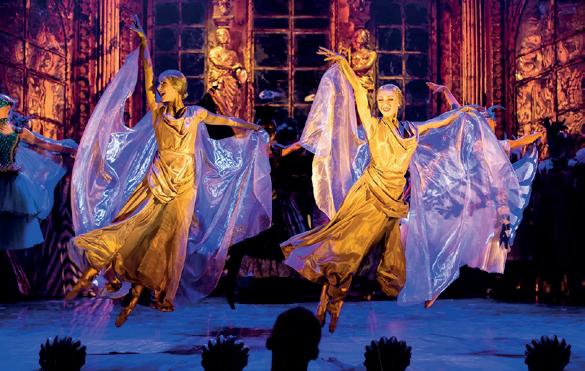

6 APRIL 2025
Streets of Belgrade
The largest sporting event in the region is scheduled for April 6, and according to the organisers, the number of registered participants has already surpassed that of previous years. “At this moment, we have over 11,700 registered runners, including 2,367 foreign participants. We are not chasing numbers; rather, we focus on improving quality in all aspects. However, the numbers are the first indicator that the running community highly values our organisation and appreciates it more each year,” says Darko Habuš, director of the Belgrade Marathon. This highly significant sporting event for the City of Belgrade and the Republic of Serbia will feature races of 42, 21, and 10 kilometres, as well as a fun run. A record number of elite runners is expected on April 6. As in previous years, the races will start at staggered intervals to ease congestion at the starting line and refreshment stations.
22 APRIL 2025
Sava Centar, Belgrade
The world’s most popular musical, The Phantom of the Opera, is coming to Belgrade for the first time in its spectacular Englishlanguage production on 22 April 2025 at Sava Centar for a limited season.
The Phantom of the Opera is Andrew Lloyd Webber’s most awardwinning musical, with over 70 prestigious accolades, including four Olivier Awards and seven Tony Awards. It has been viewed by more than 160 million people worldwide in 46 countries, across 195 cities, and in 18 languages. This moving love story continues to capture the hearts of audiences worldwide.

